Advancing Back to the Foundations
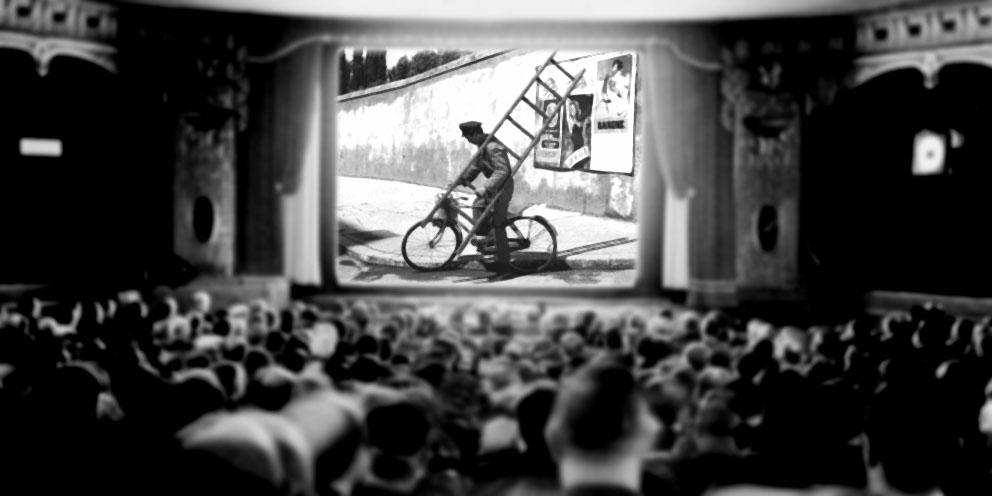
“How the Story Began”
As I mentioned at the end of the previous chapter, up to this point I have tried to draw a synthetic overview, the broadest one I have been able to, of the environment in which we, as professional animators, are called to move, with all fears, frustrations, anxieties, and even anguish that a technological and cultural process in a tumultuous transformation arouses in each of us, whether we are an artist still at the beginning, who faces this world for the first time, armed only of his skill, creativity, courage and enthusiasm – and whether we are an established artist, who has already been involved in this profession for years, even decades.
From now on I propose to delve more deeply into the “living matter” of the animator’s professional life and tools (but some of these thoughts can be also applied more or less to other artistic roles related to animation, such as storyboard, lay-out, background, editing, compositing, etc.) and to seek the very roots of our art, the methods, the actual tools that we can use to best convey it, both within our professional relationship – production, colleagues, directors – and towards, ultimately, the audience. “Our” audience.
The most crucial, determining and, ultimately, most personal and “secret” phase, if we think about it, takes place right at the beginning of the story, the moment in which we go from first aspiring to then planning and finally deciding to start this adventure, not more just as a dream, an eccentric passion, or a means of expressing one’s personality, but as a real – paid – daily “job”, whether we are freelancers, owners of our own studio, or employed in a large production Company.
Each of us can tell our own story about this initial phase, probably completely different from that of everyone else, even if in reality there are some common characteristics, starting from the fact that we do not handle numbers, like an engineer, nor we deal on clinical pathology, like a doctor, or on Excel, like an accountant: our common field could be considered the image, the moving image, or more specifically the representation of it. In other words our matter and tool is the drawing, more specifically the line, or more generally, moving shapes.
And this is generally true, if we limit ourselves to a superficial examination, but there is something more, more deep and crucial, as we will see.
To get there somehow, I will tell my personal experience of these first formative years, and of my first encounter with the art of animation. Not because my story is particularly significant, or more representative of anyone else’s. Indeed, I could define my personal experience as rather askew, eccentric, compared to more “canonical” stories of elective affinities, specific studies, career directions.
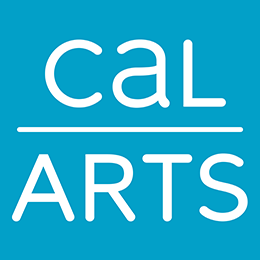
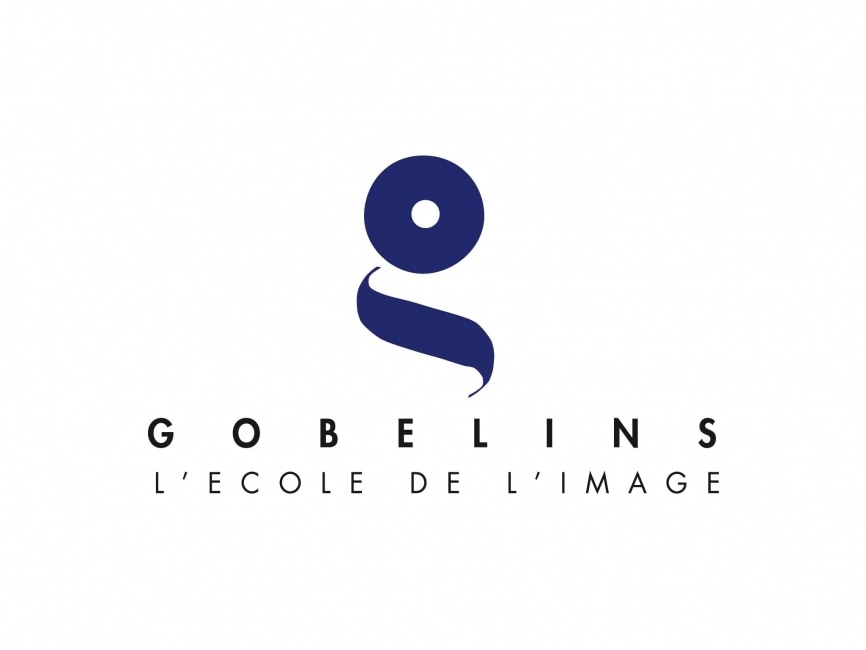
There are those who, at a very young age, already have very clear ideas and enroll in a specific school or renowned institutions, such as CalArt or Gobelin.
Then those who encounter animation a little later, perhaps while following fine arts courses at an Academy, or other similar training courses. And finally those who follow other more unexpected and unpredictable paths.
These are all different paths, all exciting, and which ultimately lead to the same result, that is, starting a life as a professional animation artist (often after having explained, not without difficulty, the “sense” of such a weird choice to parents, families, friends, social network).
Simply, by following my personal experience, it is easier for me to descend “to the bottom of the cellars” (i.e. to the foundations), to the very source of our, as we had called it, “vocation”.
Anyway, after the childhood crush (common to many of my generation) with the great Disney feature films of the golden era and later, I distanced myself without regret from that primitive passion, which indeed, in the adolescent time I considered “too childish ” and no longer suitable for a boy who now felt grown up and emancipated.
My first ideal goal, as soon as I had the awareness that I probably wouldn’t remain in childhood for my whole life, and that indeed it was becoming urgent for me to get out of it, was the “Cinema” with a capital C; I mean live-action movies, what I probably instinctively felt like the “adult brother” of my primordial passion.
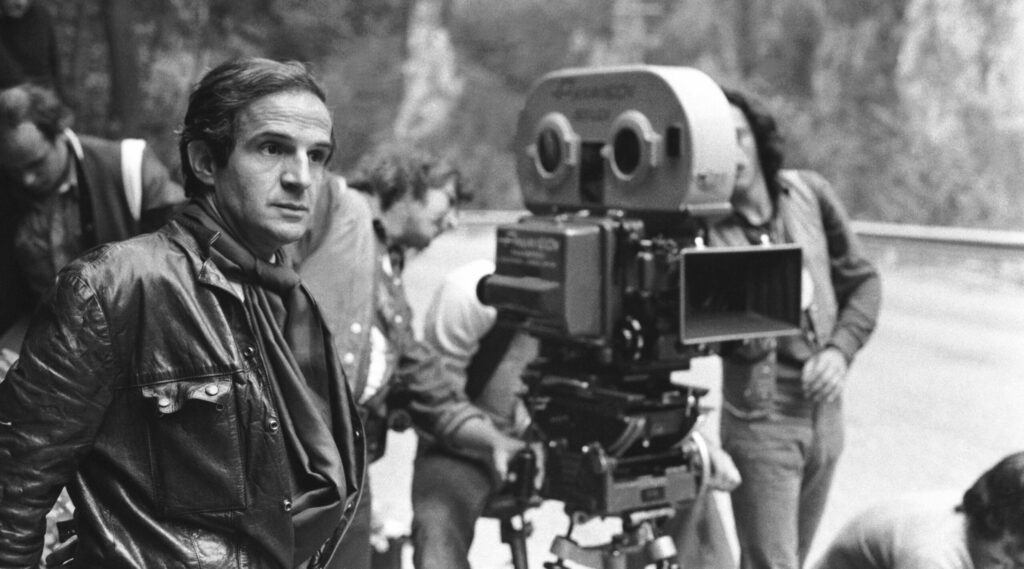
This first aspiration of mine “to become a film director” occurred with the complicity of the presence in my house of a large collection of volumes on film history, technique and criticism, collected by my father who was a passionate cinema enthusiast and who practiced for some time the activity of film critic and reviewer on the pages of local newspapers.
Those were very fruitful years (those of my father’s time, I mean) for the movie industry, or, in one word, the “Cinema”, understood both as an entertainment industry and as a social and cultural phenomenon. In particular in my hometown, Trieste, which in the immediate years after WWII was a territory occupied by the US army (AMGVG – “Allied Military Government Venezia Giulia”), dozens of cinemas flourished, which imported, much earlier than the rest of Italy (and even of Europe, with the exception of the UK), mainstream Hollywood (and Burbanks) production, which was also booming in the postwar period.
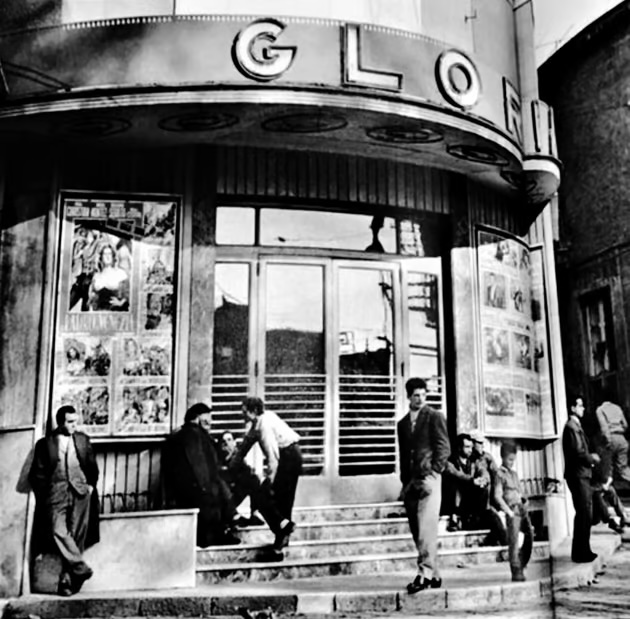
Furthermore, in Italy these were the years of the birth, development and popular and international success of the New Italian Cinema, with its spearhead, the “Neorealism”. My father, and this already explains many things, was almost the same age as a whole great generation of Italian director-authors, from Vittorio De Sica, to Federico Fellini, to Luchino Visconti, and he met and frequented as friends well-known critics and film historians of the time, like Tullio Kezich and Callisto Cosulich.
In my house all this resulted in the presence of many shelves in the private library cluttered with volumes, essays and magazines exclusively on Cinema, which I still jealously preserve, and which at the time became my first avid readings, even as a kid, together with literary classics for youth (I was always a strong reader) …and Mickey Mouse comics. And the most read and reread were fundamental cinema theorists and authors, such as Sergei Eisenstein (i.e. the first Italian Einaudi version of his “Film Form”), Tziga Vertov, Guido Aristarco, Francesco Pasinetti, Chris Metz, Gianni Rondolino, Cesare Zavattini, and many others, some well-known (in Italy in particular) and others now forgotten, as well as screenplays taken from various films by Fellini, Visconti, Chaplin, Ford, just to name a few.
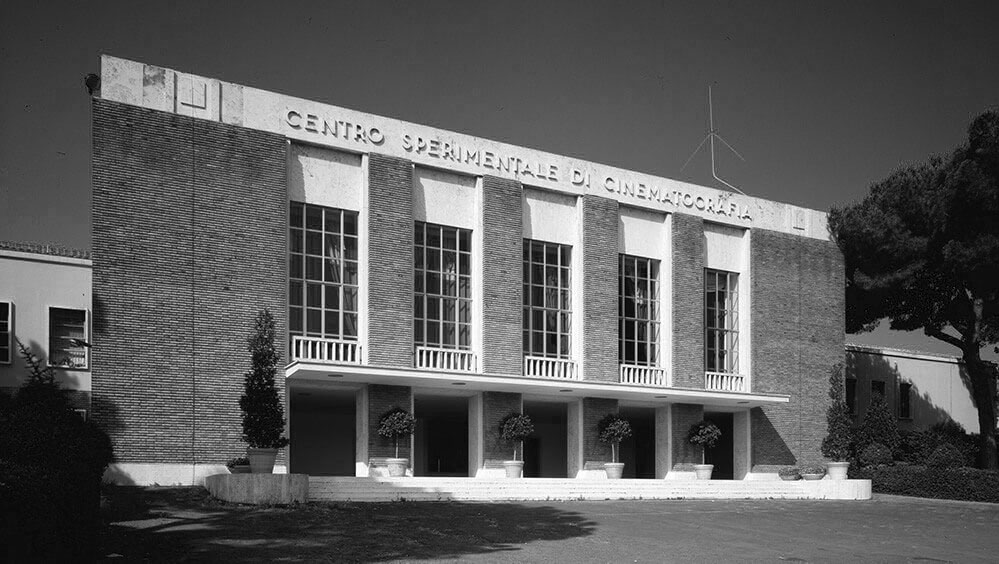
I wouldn’t swear how much of all this I really understood and assimilated at the time, but it certainly gave rise to a real passion, and was this passion that pushed me, after high school, to try to enroll at the Centro Sperimentale di Cinematografia in Rome (prestigious film academy founded and directed by director and author Roberto Rossellini – “Rome, Open City”(1945), “Paisan” (1946)).
If I had succeeded, who knows, I would most likely not be here telling this story, but a completely different one. But it was a dead end: although my family was not entirely against it (even if they would certainly have preferred a son who would become a doctor or an engineer), the distance and costs linked to an inevitable move to Rome, in addition to the very low probability of entering the restricted number of those elected to attend that very exclusive school, caused the project to founder, which finally resulted in an apparently less “demanding” enrollment in the newly established DAMS (“Discipline delle Arti Musica e Spettacolo”) Faculty in Bologna.
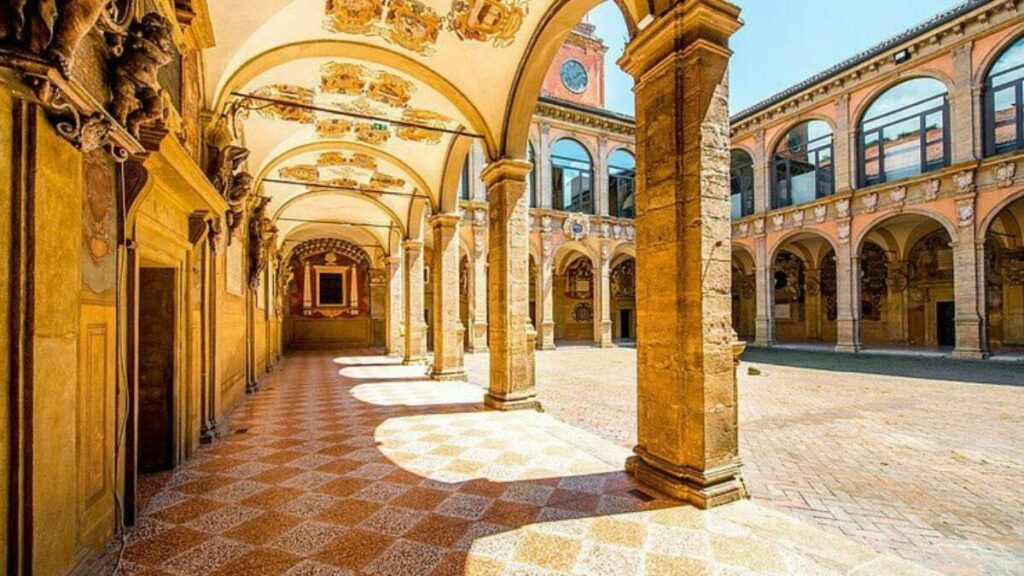
Here I have to say a few words for those who don’t know what the introduction of that particular University department meant in the history of culture in Italy: it was “invented” from scratch, in the early 1970s, by a group of eminent – and mostly still young at the time – intellectuals to ensure, so to speak prosaically, a “public salary” to be able to continue their study and research activity with a certain economic security. Soon it became a center of attraction for a whole generation of young talents who wished to somehow enter the world of art, music and entertainment, as expressed in the very name of the degree course.
It was here where I had the opportunity – an opportunity unfortunately, given my immaturity, not sufficiently exploited – to meet as professors personalities of Italian culture of the caliber of Umberto Eco (as I mentioned in the previous chapter), Luigi Squarzina, Renato Barilli, Thomas Maldonado , Furio Colombo, Giulilano Scabia, Nanni Loy (the only film director of the group), Emilio Vedova, Anna Ottani Cavina, and many others.
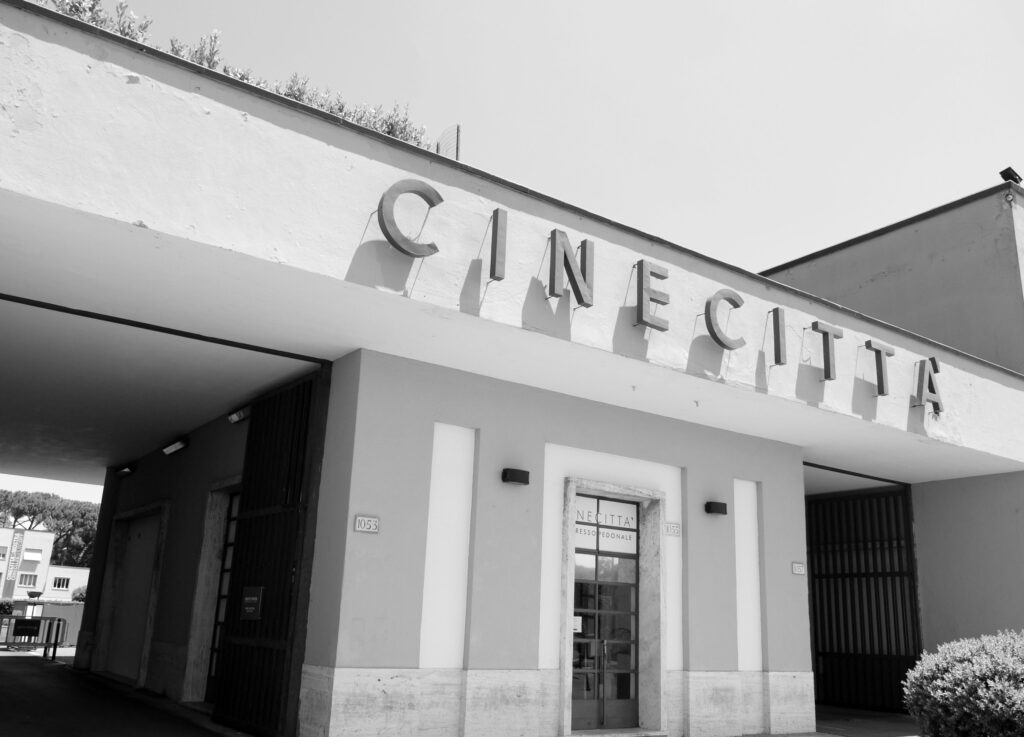
My “future” was now only vaguely still clinging to the old Cinecittà dream, and was taking shape as that of an unspecified “cultural operator” who could be inserted in schools, universities, fine arts superintendencies, theaters, public administrations, even ministries.
But it was precisely in this period, so exciting and seething with ambitions and disappointments, that the first spark “fired”, the one destined to mess up all the plans, and which would finally lead me to what I would really do for a living …even though I was still far from being aware of it.
Casuality and Causality
In the course of the previous article I began to talk about the confused and uncertain choices that characterized the beginning of my studies, all in any case very far from the path that only later would lead me to practice the profession which then, for almost forty years now, it got me bread, onion, and even some dessert.
Unlike many, therefore, I came to this profession in a completely casual way, and rather late, but perhaps it was precisely for this reason that this “irresistible drive” that I called “vocation”, in my case was more strong and aware than for many others. I consciously abandoned other possible life paths, perhaps safer and more practicable for me, to launch myself into an unexplored territory, without having a specific technical and artistic preparation, with only a vague idea of what I could do with it in my future.
But I don’t want to spoil it any further: let’s say that my studies, my acquaintances, my projects were far from any reference to what I would really become “when I grew up”, until, as I said above, the spark suddenly flew.
However, it was not that melting pot of ideas and knowledge in which I was immersed during my years in Bologna that produced, at least directly, that sudden “enlightenment”, but a completely fortuitous, divergent and unexpected encounter: pure “causality”. Although, thinking about it, it wasn’t so foreign to the original “culture soup” in which I was moving in those years.
It happened when I started taking courses in “psychology of perception” at the university of my hometown (Trieste), a field of study that I had come across by chance during my academic studies in the History and Psychology of Art, and which had begun to interest and intrigue me a lot. In fact there was something extremely attractive for me in trying to understand the psychological and physiological basic mechanisms involved in the perception not only of works of art, which are conceived precisely with the aim of using those mechanisms in order to convey the message, the information, and the representation of “reality”, but also of the pure vision of the world by human beings: perception – illusion, or sign – meaning.
It was therefore during the course of these studies that I came across a Belgian experimental psychologist (relatively little known to non-experts), named Albert Michotte (1881-1965).
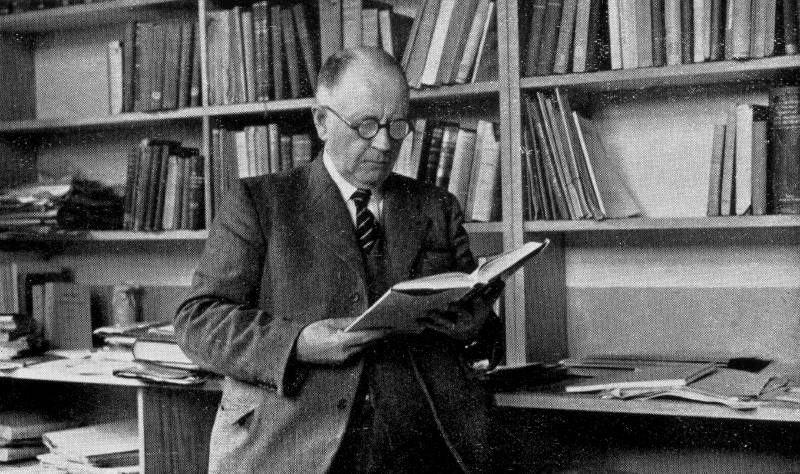
The main focus of Michotte’s research was perception. This was the theme of his first research, and it was to this field, albeit with a new perspective, that almost all of his work after 1940 is devoted. He also had a reputation for creating new and creative techniques and instruments.
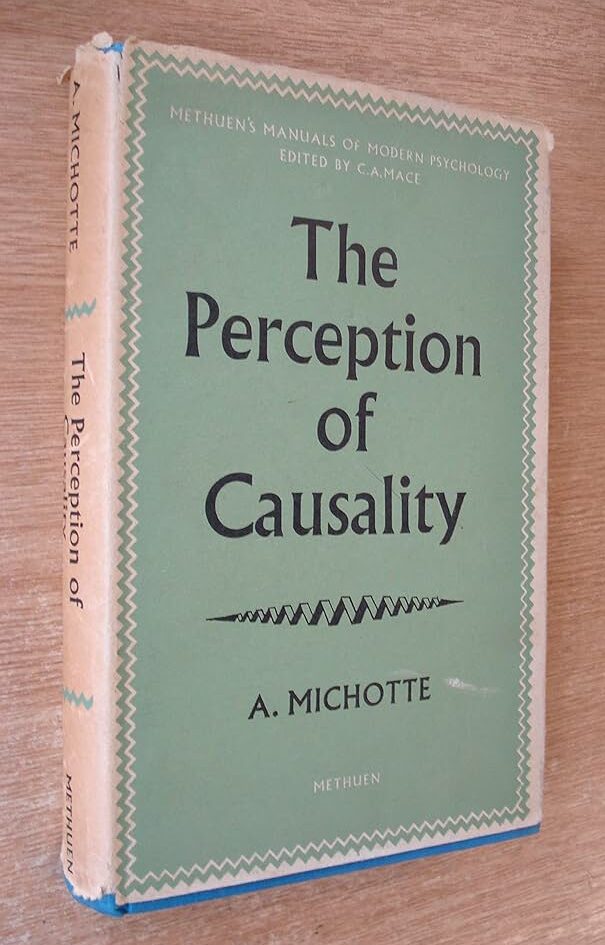
In his 1946 book, “The Perception of Causality”, published originally in French, he became the pioneer work in event perception and met with international acclaim. In this book, he shows how certain very simple visual sequences carry the appearance of causal connectedness. Michotte emphasizes that this appearance is perceptual, not inferred by association: “[T]his is not just a “meaning” attributed to the literal, step-by-step translation of a table of stimuli; they are primitive specific impressions which arise in the perceptual field itself,” [Wiki].
I will deal with this research in more detail in subsequent chapters, since I consider it truly foundational for the subject of our profession. For now I will limit myself to focusing on the primary object of these studies, what struck me to the point of probably determining all my future career.
Michotte posed the problem of probing what were the minimum elements by which our mind perceives the causality of one phenomenon with respect to another: in simple words, what makes us say, for example, that a moving billiard ball that hits another is the “cause” of the movement of the latter. Not only in reality, where there are many elements that interact or interfere with the event, but also in a representation, even a totally abstract one, of the same.
Michotte understands that, once every other spurious element is removed, only two parameters remain in play: movement (and relative speed), and time. That is, the relationship between these elements: back to our billiard balls, a ball [A] moves with a speed [s1], hits ball [B], which after a fraction of time [t] receives energy from ball [A] and moves away from it at a speed [s2].
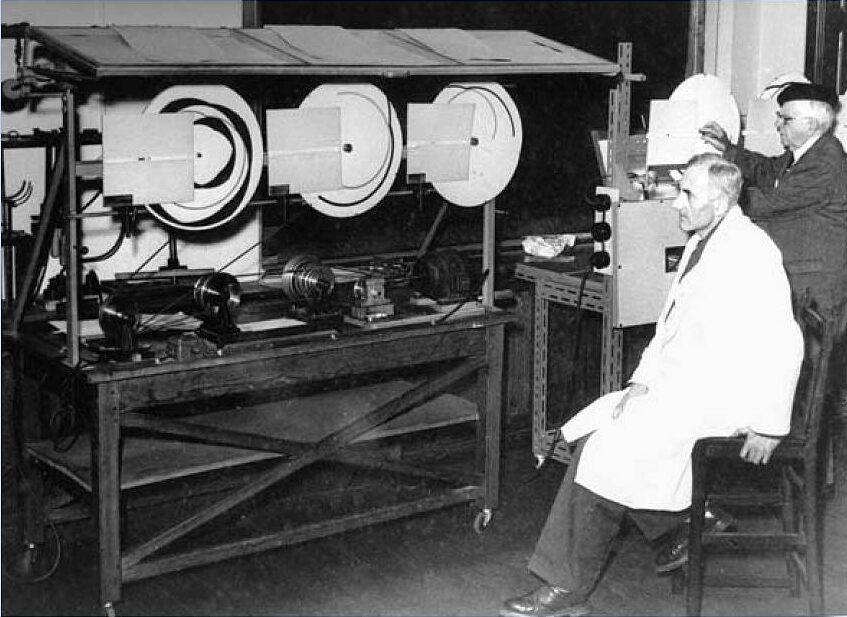
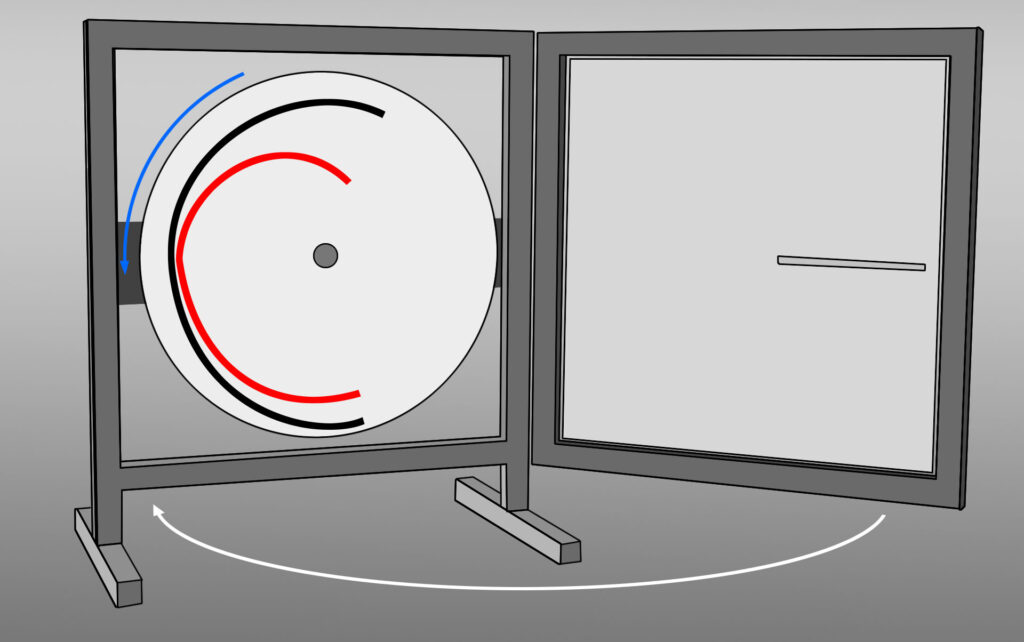
To eliminate any extraneous variable from the experimental field, Michotte devised an ingenious device, consisting of rotating disks with spiral paths showed behind special slots, so as to be able to modify the essential variables involved at will, namely the absolute and relative speeds [s1] and [s2] of the “objects” [A] and [B] (which in his experiments were reduced to black squares on a white background) and the “contact” time t between the two objects. What fascinated me about these experiments was the fact that, by varying these parameters, it was possible to obtain an absolutely binding perceptual effect that could go from a clear and absolutely objective “[A] CAUSES the movement of [B]“, to instead a “the movement of [A] DOES NOT CAUSE the subsequent movement of object [B]“, up to “object [B] actively “ESCAPES” or “RUNS” from object [A]“, with a lot of intermediate nuances all subject to different subjective interpretations.
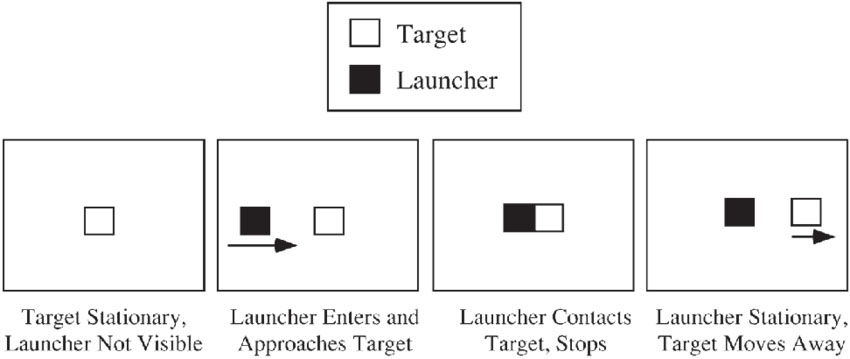
In other words, the simple MOVEMENT of an object could be perceived by our perceptive system as an active, voluntary, or passive action, and the object itself, reduced to a simple “one-dimensional” figure, could be seen as the subject, an agent, an actor, or the object of an action applied to it.
I can anticipate that here, without knowing it yet, I had clearly encountered the raw material, the clay of which the art that I would soon practice was made, because for our perceptive system action corresponds to intention, and intention to a more or less conscious life.
This research involved me to such an extent that I felt the need to delve deeper into it, replicating it, and perhaps adding further elements of my own. Since it was impractical to reconstruct Michotte’s complicated (and expensive) apparatus at home, I thought of using a technique that I knew little about, but which seemed to promise greater flexibility at relatively low costs: animation!
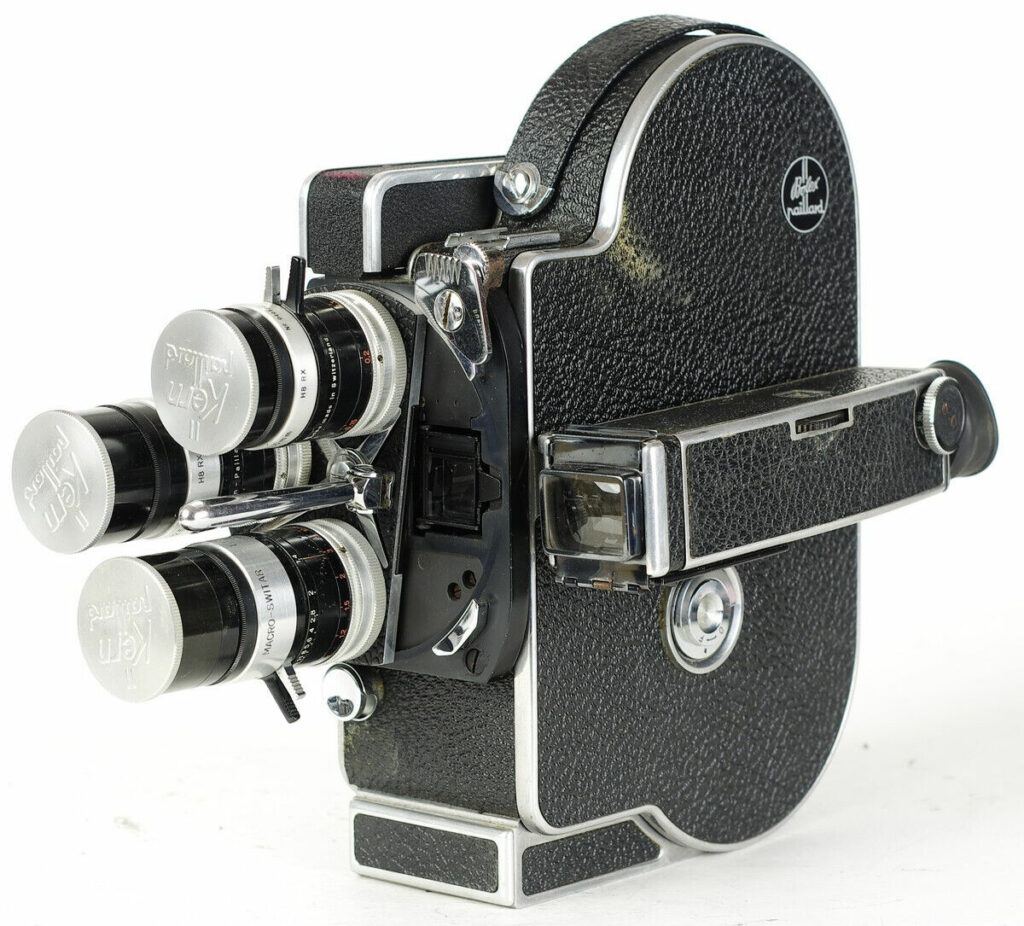
I therefore purchased a second-hand Bolex 16mm, mounted it on a rudimentary stand, and began photographing some white small disks frame by frame, moving them along carefully prepared (invisible) paths on a black cardboard background. I used little disks, instead of the small squares of the original experiments, since they were closer to the concept of “billiard balls” I initially imagined (not thinking that Michotte had decided on small black squares on white background, not only for reasons related to the technique he used, but perhaps also precisely to eliminate any possible residual conceptual approach to a “real” object), but also because in this way I could eliminate the variable of the “contact surfaces”: the point of contact between two disks could be reduced, in fact, to a single point, while in Michotte’s original version the contact occurred on the side of the squares, and therefore perceived as a “surface” in a three-dimensional world.
However, unfortunately I soon realized that the system was not ideal, since, unlike Michotte’s original “spinning discs” device, it did not operate on a perfectly analogue, continuous representation system, but on what today would be called a “sample” – exactly like in CDs audio compared to vinyl microgrooves. In this case, in fact, I had a minimum sampleable interval of 1/24 of a second, equal to the standard speed of the film rolling in the playback system, i.e. the cinema projector or the Moviola. In practice I couldn’t manage time intervals lower than this threshold, so I could not really fully reproduce Michotte’s results, but only approximate them.
Yet all this was not sterile and unproductive work, since even in this way I was able to obtain quite evident perceptive effects and some interesting variations, and I also obtained my little “good impression” in the academic field; but above all it was precisely here that, as I said above, my first encounter with the animation technique took place, and, even more fundamentally, it was here that I “discovered” the power, and the magic, of movement.
It goes without saying that this first rudimentary “stand camera” soon became my first workbench for the creation of my very first real animated films, or rather, animated drawings, but this is a story that would go beyond the scope of these articles.
What matters was my personal “discovery of hot water”, that is, the fact that the movement applied to an object substantially and dramatically changes its nature in our perception of the world: this object, be it a simple white disk on a black background, or a bottle on a table, or a stylized line drawing, or a photographic image, makes a leap in status, acquiring in our eyes a previously non-existent intrinsic property, what we could define as “life”.
This will be precisely the subject of the next article, since we “animators” have included this concept in the very name of our activity: just as a musician is someone who manipulates sounds to obtain an effect of communication, information and emotion, we, as “animators”, do the same thing, manipulating the MOVEMENT.
Movement is Life. And Vice Versa
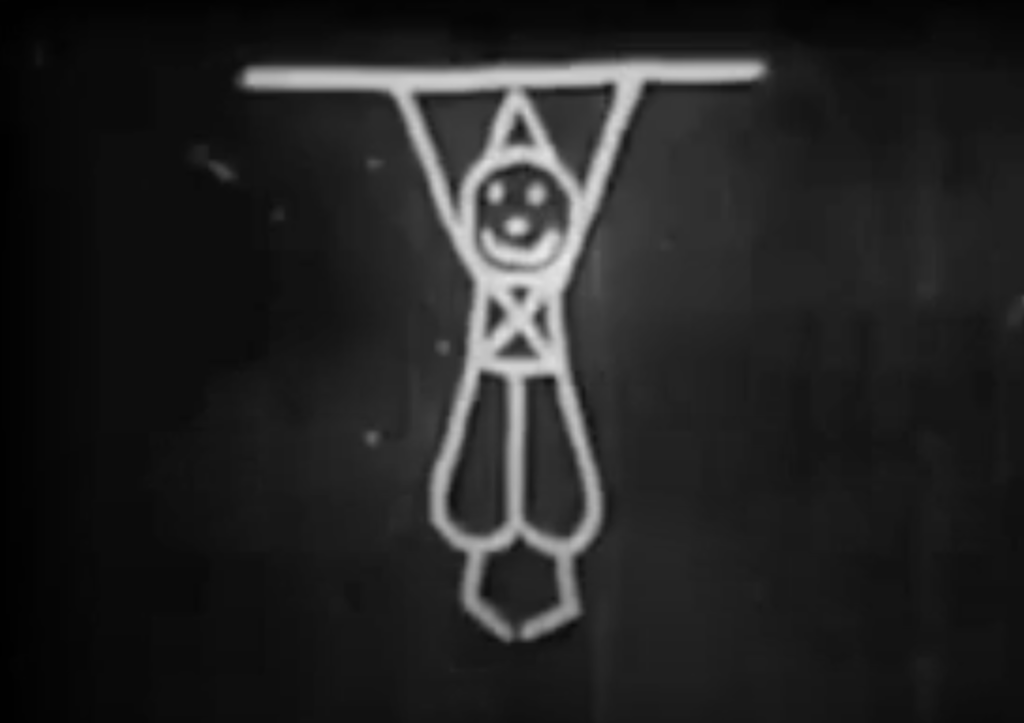
As I wrote above, a series of completely random and unpreordained circumstances brought me to the threshold of the “revelation” that would later influence all my subsequent life choices.
My sensitivity to “expressive movement” was probably in some way innate, otherwise it would not have emerged so forcefully in the face of a simple fortuitous encounter with an otherwise little-known experimental psychological theory, so much so as to divert the course of my interests, and of my own primary activity.
However, this “accident” helps me to focus on what I believe is the primary core of every animator’s talent, whether innate or learned.
It is an “instinct”, a sensitivity, let’s call it what we want, completely independent of the technique actually used to express this talent, from animated drawing, to claymation, to stop-motion, to 2D and 3D computer animation, since the beginning of the history of cinema itself. Indeed, even before, to its prehistory, given that it is well known how the drawn film even anticipated the subsequent invention of “animated photography” from the Lumiere Brothers onwards.
Anyway, this this also applies to the most bizarre animation techniques, sometimes seen only in experimental or niche films, at specialized festivals (I mention only the magnificent découpages of Luzzati & Gianini, the magical animated silhouettes of Lotte Reininger, the extraordinary fantasies on film by Norman McLaren, the phantasmagorical pinscreen of Alexander Alexeieff) but also to original and somewhat anomalous “experiments”, yet successful with critics and the public, such as some brilliant films by Tim Burton and Gulliermo del Toro.
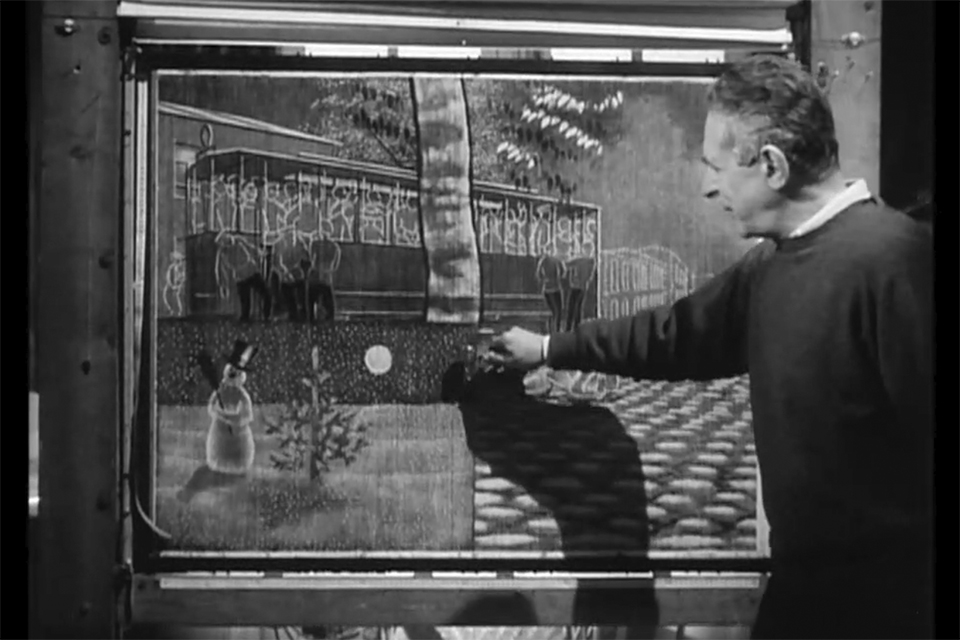
Well, going back to my story, I still remember very clearly, as if it had happened yesterday, the very vivid sensation I had when I received the developed film of my very first “animated drawing” and projected it on the wall of my room.
It was a crude little man in a hat who awkwardly took a few steps forward in a kind of a double-bounce; suddenly BANG! received a heavy anvil on his head, staggered and fell to the ground in a faint, FLOP! The anvil, after bouncing in the air, finally fell back on him CRASH! Haha, what a hilarious joke! I even reinvented a kind of personal “Arroseur Arrosé”!
However, it was nothing more than the “practical” application of that concept of “causality” which I had dealt with by moving small white disks during my university studies. It was an absolutely rudimentary first test, of course, I had no knowledge of the animation technique at the time, not even an approximate one. I only knew that it could be achieved by drawing a series of images in sequence on sheets of paper placed in register under a movie camera, then photographing them frame by frames.
Yet the impression I had of it was such that it probably influenced in a decisive way and forever my choice to devote myself to this very particular art, then as a profession: this barely sketched drawing of a little man with a hat, still so clumsily and rudimentary (paradoxically, since I lacked specific preparation in fine arts, I always considered myself a bad draftsman, always forced to laboriously pursue my ambitions as a traditional animator), at the very moment he began to move and to take his tentative steps on the screen, wobbling at 24 frames per second, it was no longer a “drawing”, but HE was indeed “the little man in the hat”. A moving – living – little character. A figure that virtually separated from the sign traced by my hand, and “came to life”, showed its intention, its vital force, an expression in his “face”. His eyes “looked at me”, manifesting, albeit in a crude way, a conscience and an intention, and when the anvil hit him, this was no longer just the “drawing of an anvil”, but a solid iron object, and its “weight” was distinctly perceivable, thanks to the effect it manifested by hitting the other subject.
Art and Time Machine
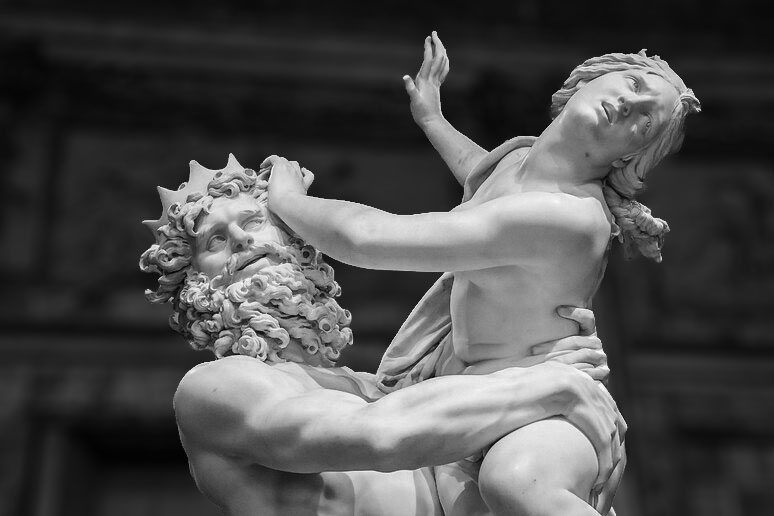
Synchronic Arts
Time is frozen. We can observe and evaluate the work of art as a whole or in detail for a single moment or for an indefinite time.
The work of art remains unchanged over time, except for external events that are not significant for the work itself (damage, manipulation, restoration, theft, etc.).
Space is directly expressed and occupied by the work of art. We can observe it in the material, in the weight, in the perspective, in the balance, in the internal and external spatial relationships of the work itself.
Movement can be suggested or denied by the work of art, it can only be observed as a potential event, in development, or in instant suspension, in the dimensional relationship and balance of weights between the parts of the work.
Narration, dynamism, rhythm are expressed through comparison and juxtaposition / contrast between the parts of the work.
It can “tell a story” only as a metaphor.
Sculpture, painting, architecture, graphics, photography etc.
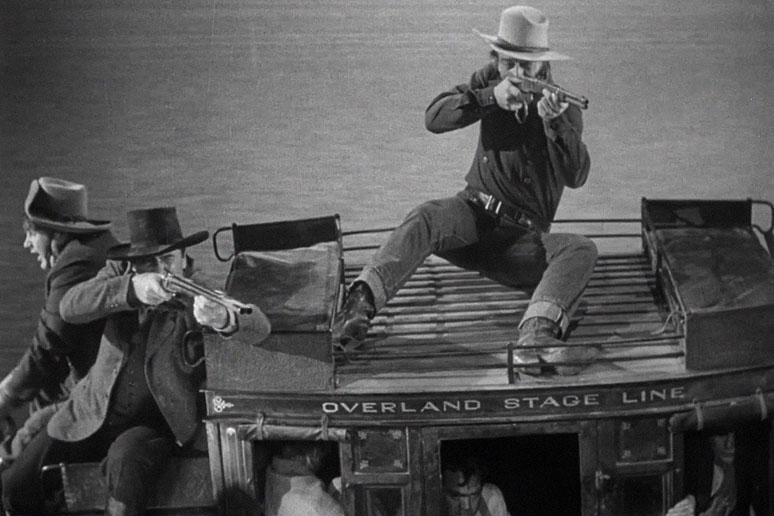
Diachronic Arts
Time is unfolding. We can observe and evaluate the work of art only during a more or less significant period of time in which the work itself is represented.
The work of art is in continuous transformation and mutation, unless the temporal flow is interrupted by the intervention of external agents, which have no influence on the work itself and its meaning.
Space is expressed by the work of art only as a measure and theater of the action, through indirect representation.
Movement is the very engine of the work and supervises its development, in the relationships between the subjects and objects of the representation. The external development of the representation and the internal one can coincide or be independent of each other, but they follow the same path and share the same temporal flow
Narration, rhythm, action are integrated into the work of art and directly expressed by it. It tell us a story.
Music, literature, poetry, theatre, cinema, television etc.
I like to divide the vast field of arts into two main macro-categories: that of SYNCHRONIC arts (such as sculpture, architecture, painting, photography), which produce unique forms in space and time, and can be observed in a single simultaneous cognitive act;
and that of the DIACHRONIC arts (to which music, poetry, theatre, cinema belong) which have the characteristic of unraveling over time, and which therefore can be read, experienced and understood only in a perceptive and cognitive act of a certain time duration.
In this case time implies development, movement, mutation. Finally, a story.
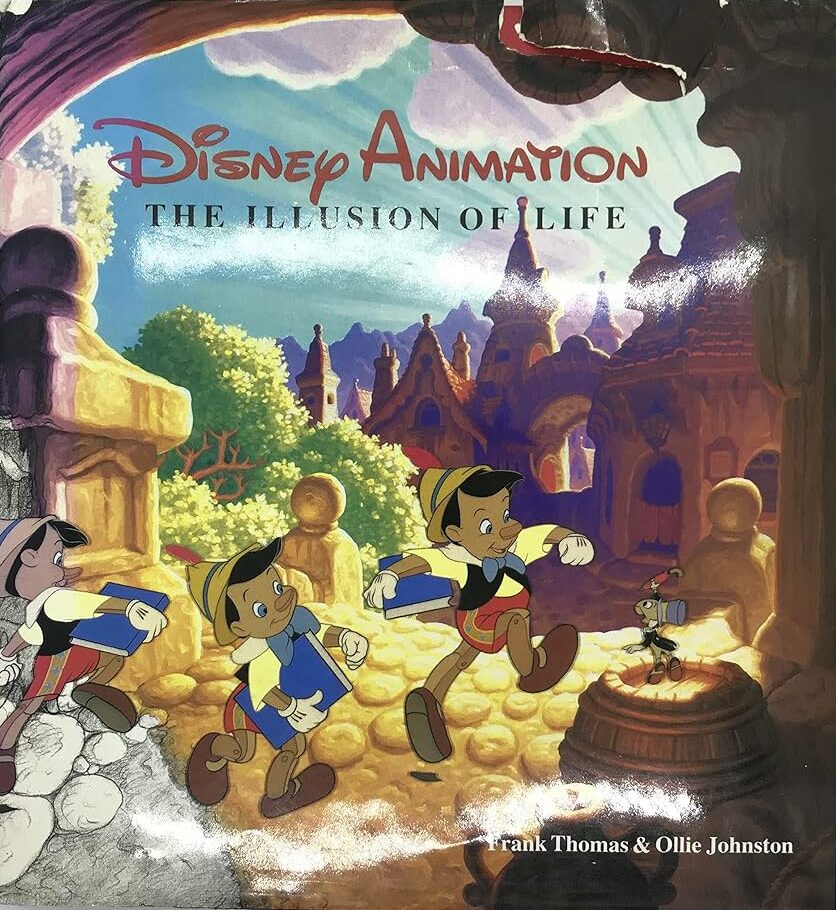
If we think about the work of a musician, for example, we know that his “raw material” is sounds, and that he manage their articulation over time to create melody (horizontally), harmony (vertically), and counterpoint (interweaving the two lines, like the warp and weft in a fabric).
Similarly, the animator deals with movement, to create and modulate temporal transformations of shape and position such as to give objects an illusion of “life”. That is, that “Illusion of Life” canonized by the classic volume of the same title by Frank Thomas and Ollie Johnston (which I have already had the opportunity to mention as the “bible” of our profession).
Movement is certainly present, we could say, in an essential way, even in ALL those we have defined as “synchronic” arts. A movement intrinsic to the forms, to the various components of the work, to their relationship with each other and with the unity of the work as a whole: think of the rhythm of a colonnade in architecture, the tension of the muscles in a sculpture, the play of light and shadows in painting, to the instantaneous shot of a photograph that “freezes” an action, exposing its essence stopping the time.
But this movement it is always a “suggested”, potential, a fragment of an ongoing instant event.
In the arts that we have defined as “diachronic”, however, the movement is expressed directly by the constituent material of the work itself: it is its breath, it is the vehicle of its language that the recipients (spectators, readers, audiences) are called to decode in order to receive the message, the information, the emotion. It is the actual protagonist of the work.
In painting, or in sculpture, etc., the “movement” is that sign, that concrete surface which expresses it visually and conceptually in the immutable instant in which we observe the work.
In music, as in poetry and movie, and even more so in animation (which we can define as drawn cinema), movement is something inherent the medium itself: it is what happens in the “empty” space between one word and another, between one note (a sound) and another, between one frame and another. In this case it is a constantly changing perception, which as observers (spectators) we totally re-construct in our minds.
This is why the impression of “life” is so, pardon the pun, alive, evident, overbearing: because it is precisely our mind that gives it life, right from within our “soul” (or psyche).
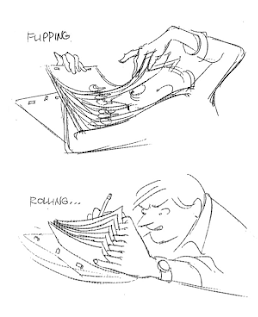
As animators we know well – because we have been taught, or because we have understood it on our own – that what matters in our work is not what we see in the single still drawing that we trace on the paper (or the “pose” that we create on the screen of a system digital 2D or 3D), but what happens between that single still drawing (or frame) and the previous one, and/or the next one: it is a completely invisible “something”, until we start the “time arrow”, starting the projector, or the timeline of the application, or, as was done in the past (and there are very few people left who know how to do it now) by “flipping” the physical paper sheets gathered in a stack.
Every single animated drawing (or every pose on the 3D computer) is in a state of studied imbalance, it is a fragment of interrupted vision, which fatally yearns for subsequent development, it is an “interrupted act”.
That space-time “void” between one drawing and another, between one frame and another, which the observer’s physio-psychological perceptive system completes autonomously, is the real “raw material” of our art – our clay to model, our marble to sculpt, our sounds to tune and modulate: it’s the movement. an event that manifests itself only through the vector “time”.
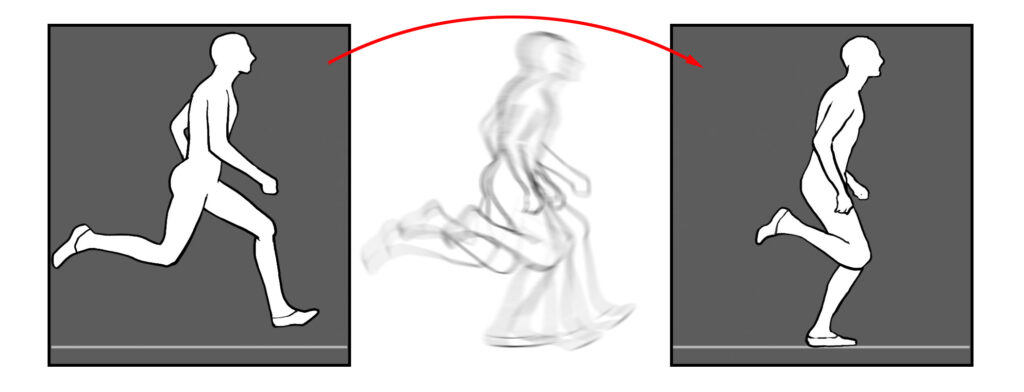
I mean, it’s PURE movement: this is our language, regulated by a precise grammar and a rigorous syntax, which is the object of our work aimed at always refining our expressive tools to finally tell a story.
As we will see later, when we will move from a purely theoretical discussion to a more “practical” one, it is no coincidence that one of the first exercises that every animator encountered and assimilated in his training path, the “bouncing ball”, deals precisely with this basic articulation of the language, where the management of the primary elements of space (spacing) and time (timing), appropriately dosed and modulated, can confer solidity, concreteness, weight and expressiveness to an “object”, even a completely abstract one such as a simple circle drawn on a sheet of paper (or projected on a screen). With an effect that is not by chance completely similar to that of the little discs (or squares) of Michotte’s experiments mentioned in the previous article.
In any case these “expressive elements” are in no way traceable in the single drawing, or frame, seen one by one, but are “nested” in the void of the spatial and temporal comparison between a drawing (or frame) and the previous or subsequent one, regulated by the primordial “physiological” principle of cinematography, i.e. the “persistence of the image on the retina“.
The language of animation starts from these primary elements, just as the word is composed from the alphabet, and speech from the flow and unraveling of words.
As we will see in the next articles, this will lead us to the identification of the two subsequent elements of articulation of our language, to compose what I consider the three fundamental pillars of animation.
From causality to intention. From intention to thought. From thought to narration.
Or, in simple words:
Three Little Pillars: Introducing to the Journey
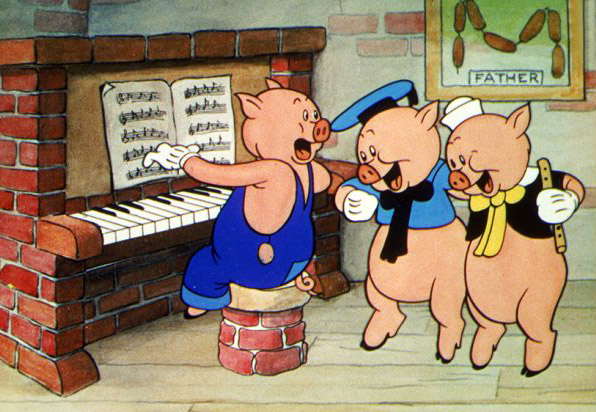
So far I have tried to analyze the primary nature of the animator’s work, and to identify what I have called the “raw material” that pertains to this particular art form.
Excluding every other aspect (which I will discuss later), I focused on what is the profound, not only intellectual, but even physiological root of our work. Those who practice the profession of animator have certainly developed a particular sensitivity towards “movement”. I mean, not movement as a physical expression of a character, or an object, but precisely movement as such.
Often it is a completely innate sensitivity, more accentuated than other people, a native “talent” that has contributed, even unconsciously, to pushing many of us to undertake this journey, even initially just as a passionate predilection.
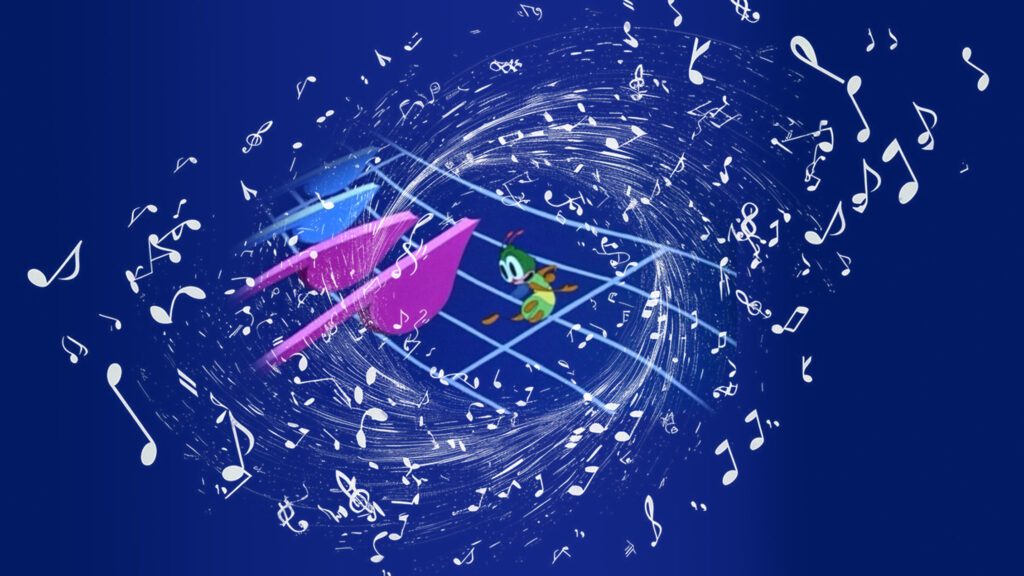
We know, for example, how in a musician his sensitivity towards sounds, the relationships between them, and their expressive substance is particularly developed, much more than in other people. It is a special disposition, completely innate, which often develops very early in life, and which almost fatally pushes to take the path of the musical career.
In the same way, we can say, the animator discovers himself quite early in his life capable of perceiving, analyzing and reproducing movement in an extremely subtle way, as an intrinsic component of animated objects, and of modulating it to the point of translating it into an intelligible language, capable of transmit life, emotion and narrative to an audience. Also in this case this is, as I was saying, a real predisposition that precedes any learning or practice: in my opinion it is precisely this particular sensitivity that makes the animator a more or less talented animator.
At this point I will begin to delve into this “language” in more detail, into its grammar, its composition technique, and finally rummaging through the “tools of the trade” of the professional animator’s daily work.
However, I do not intend to propose yet another “animation course”, I will not deal with simply didactically illustrating techniques and principles, tricks of trade and suggestions, nor with re-proposing more or less common practical exercises: for this purpose there are already online and in bookstores countless courses, paid or free, some excellent, others less so (and, yes, others honestly quite poor).
Instead, I intend to maintain here a perhaps less usual approach, a little more theoretical and conceptual, trying to give my contribution to a more in-depth understanding of the mechanisms that underlie those same principles. A bit like, to stay in the musical field, a treatise on music theory differs from a practical guitar or piano course, despite covering many common themes. I am addressing above all to readers who already know the principles illustrated or are familiar with them, but who want to delve deeper into their theoretical foundations.
The advantage of this approach is also that it is clearly detached from any specific animation technique (traditional animated drawings, 3D animation, puppet animation, claymation, and others), but can be applied indifferently to each of them, just as melody, harmony and counterpoint are concepts that can be applied to every instrument, group of instruments, and musical style.
As I mentioned in the previous article, therefore, there are three “pillars” that support the entire edifice of our artistic practice, and the thing to underline here is that these are not three independent elements, but they are one support of the other, in a layered structure, such as the section of a sedimentary rock. just as, in music, there are the three pillars mentioned above of melody, harmony and counterpoint.

The first of these pillars, is MOVEMENT, as we have seen: it’s what I could define as “the vital breath” that gives an otherwise inert object the ability to “act” (even the simple movement of an object [X] from a point [A] to a point [B] is “action”), to express intentionality, emotion, and, therefore, broadly, life.
We can say this is our “Melody”: Movement is Life.
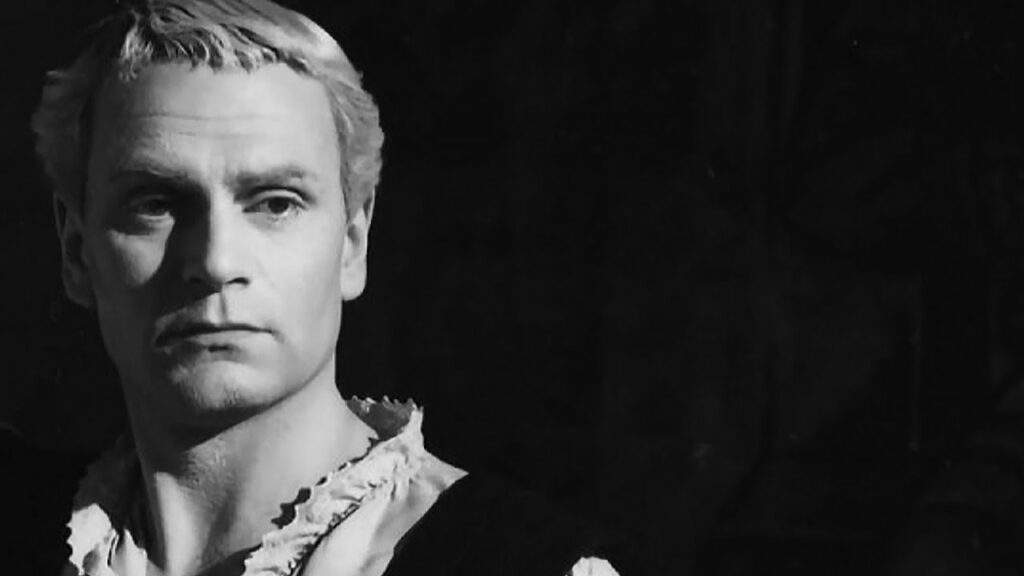
The ability of a moving (i.e. animated) object to perform a subjective action, we call it ACTING, is the second of these pillars, what in our eyes and brain gives an emotional dimension to the object.
So, Acting is “Harmony”: Acting is Emotion.
The moving object therefore carries out actions and reactions, so expressing thoughts and emotions. Finally, the set of these actions/reactions articulated according to a specific intention are in turn capable of generating a story, which represents the third “pillar” of the building we are erecting: STORYTELLING.
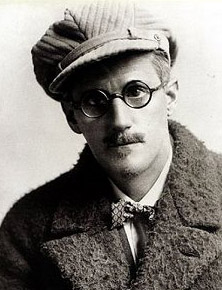
Understanded here not as a plot, the “poetic” development in the Aristotelian sense of a drama, but as the primary narrative cell expressed by the moving object (now become an Actor) in movement. An object [Y] that gets scared and runs away when an object [X] approaches is already a primary elementary narrative cell. Just as the fragment of the sentence [“Stately, plump Buck Mulligan came from the stairhead…”] is the incipit cell from which, followed by dozens of thousands of other connected micro-narratives, a work like James Joyce’s “Ulysses” will emerge.
And this is animation’s “counterpoint”: Storytelling is Journey.
In the next article we will meet an old acquaintance, who anyone with a minimum familiarity with animation as a profession has loved so much, and perhaps equally hated…
Bouncing and Jumping
At this point I cannot avoid mentioning what I would undoubtedly consider the “king” of all introductory animation courses, the Bouncing Ball.
Obviously I will talk about it in more detail in a next chapter, but for now I’ll just try to make you understand why this apparently stupid and very elementary exercise is in my opinion so important and fundamental in the context of a general “vision” of our art.
It is, as you will have already guessed at this point, an ideal “development” of Albert Michotte’s perceptive experiments which I have already introduced previously in this same chapter (12 – Casuality and Causality).
Although they are two completely distinct approaches, also because they are defined in very distant disciplinary fields, they ideally make up a perfectly coherent discussion for the purposes we have set ourselves.
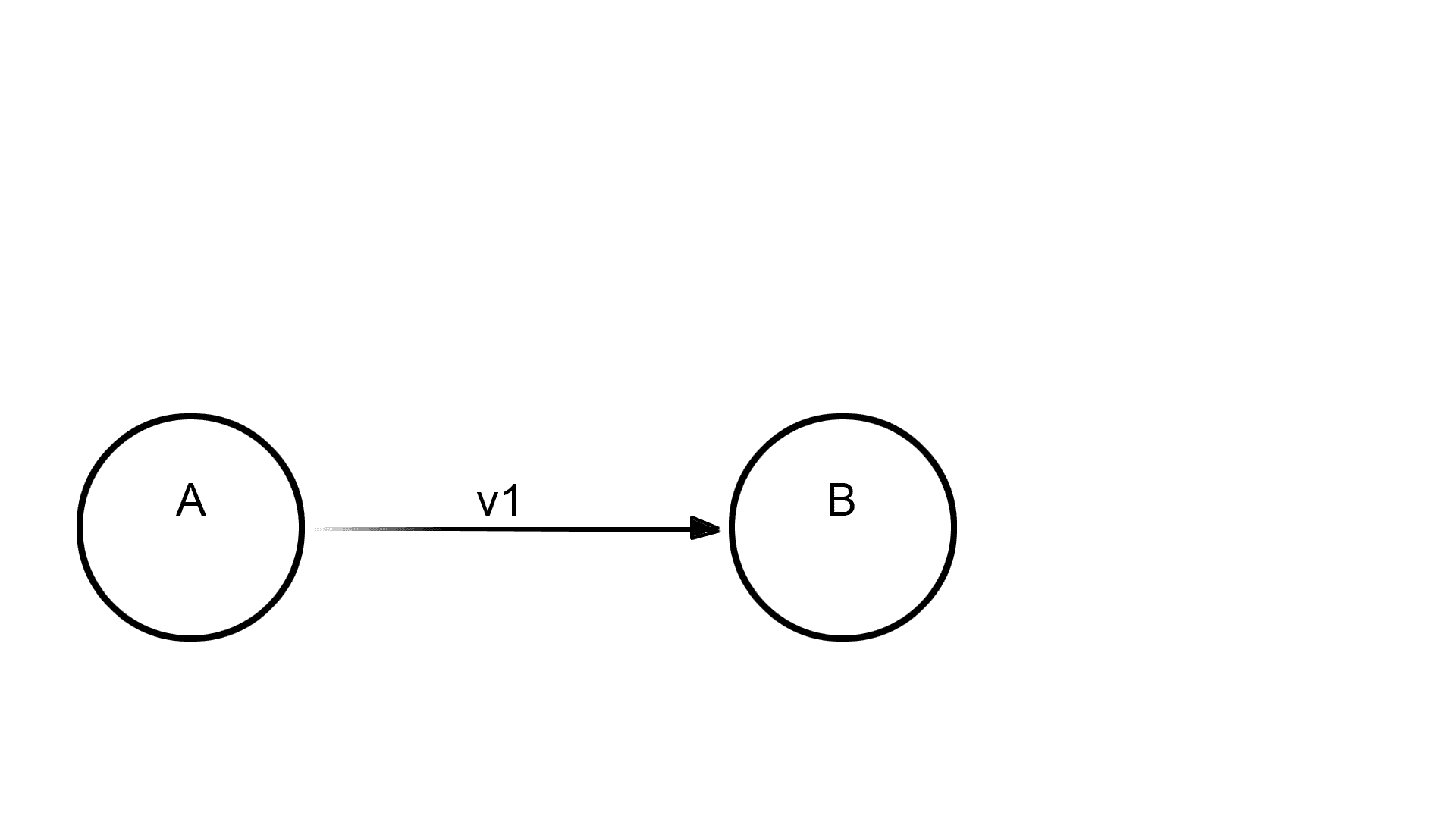
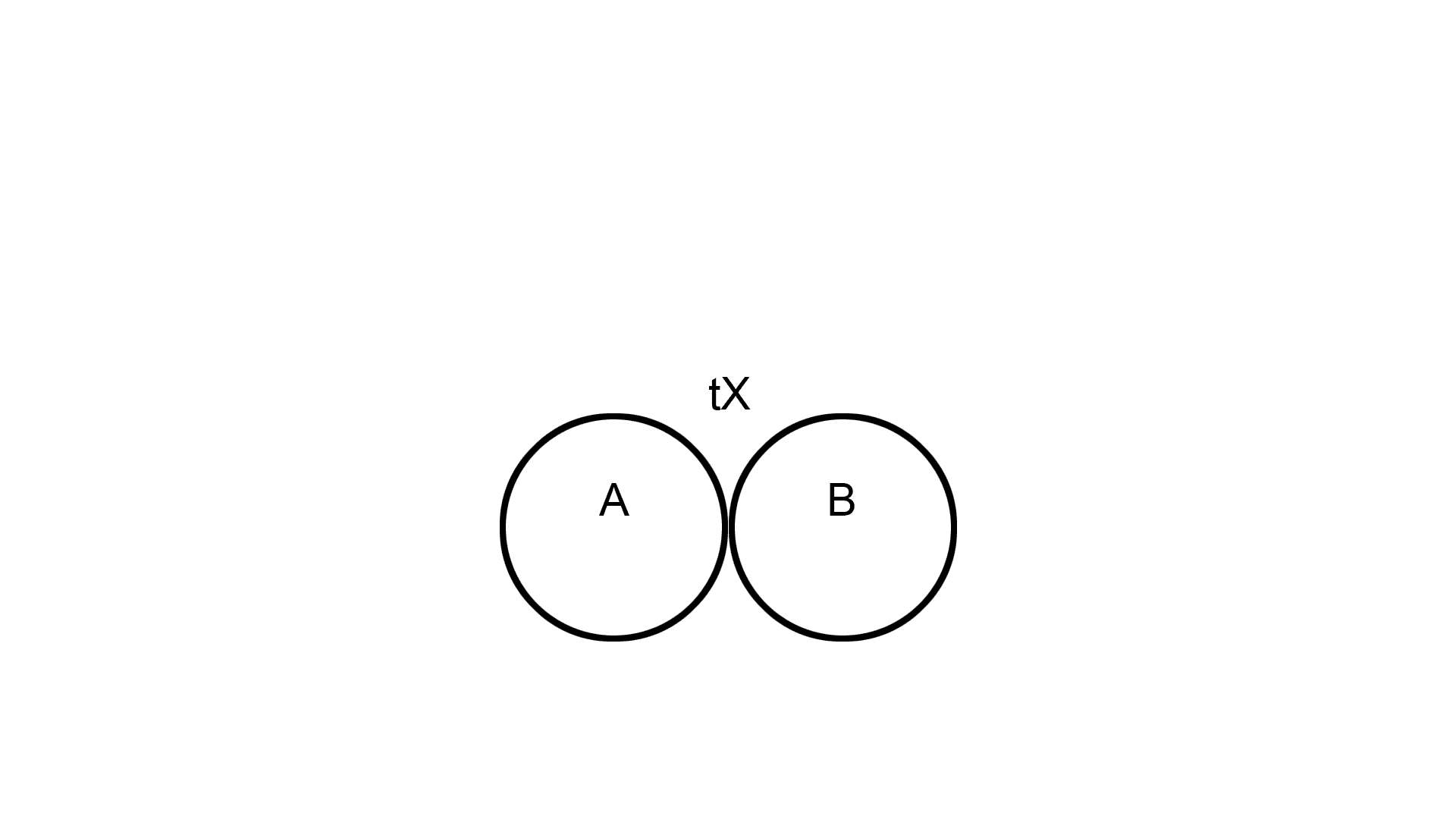
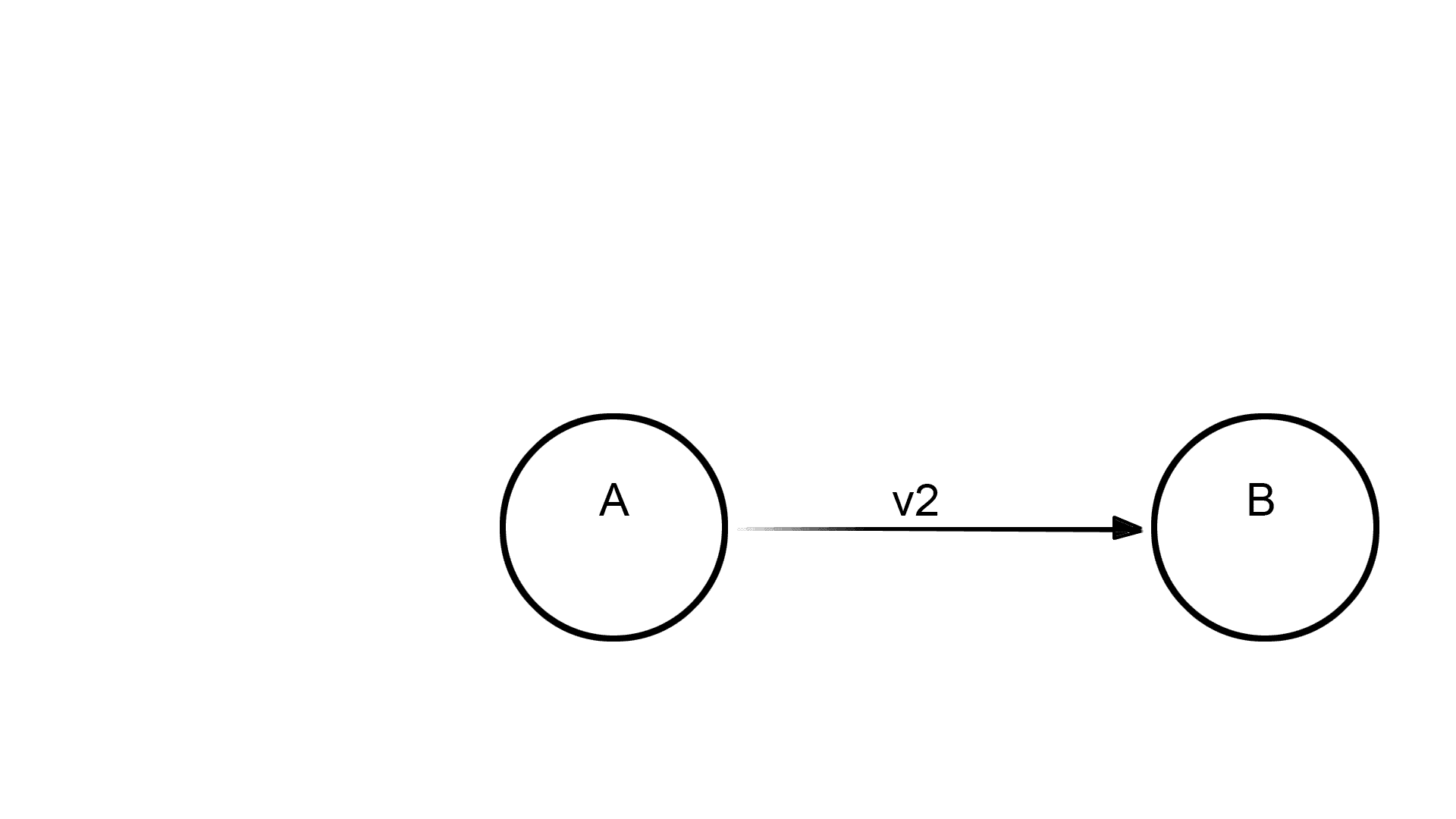
Returning to Michotte’s causality experiments, we have seen that by appropriately varying the parameters of relative speed and contact time between two abstract and two-dimensional objects we can obtain very different trigging and launching effects.
In the “classic” example, an object [A] moves at a speed [v1] (Fig 15.01), meets an object [B] with a contact time between the two of [tX] – in this case 1/ 25 of a second or 40 milliseconds, equal to 1 PAL video equivalent frame – and stops (Fig 15.02), while the object [B] starts in the same apparent direction at a speed [v2], in this case about the half that of [A] (Fig 15.03). The perception you get is that object [A] CAUSES the object [B]consequent movement (Vid15.01).
As you see, this is an entirely virtual event, as the two objects are not real, they don’t have mass, volume or material. Moreover their movement is obtained cinematically – and therefore it is not continuous, but sampled, at 1/25 of a second – and it is completely inferred by our perceptual system.
We can now vary a single parameter, such as the contact time between the two objects [tX], bringing it to 240 milliseconds (equivalent to six frames at 25 FpS), and thus the effect is canceled: the two movements of [A ] and [B] are only chronologically subsequent, but independent of each other. No causal effect is anymore perceived (Vid15.02).
If, however, we try to modify the speed ratio between the two objects, inverting them, i.e. the object [B]moves at a higher speed than that of the object [A], we will obtain the curious (if predictable) effect of an “ESCAPE” of the object [B] from the object [A] (Vid15.03), obtaining, in addition to the pure effect of “causality”, also an, albeit primitive, effect of “intentionality”, at least on the part of this last item. Until now the two movements were both in a certain way “passive”, at this point instead the object [B] seems to actively “escape” from the other, and therefore express its own intention – and also emotion, such as “fear” ” or “disgust” – in performing this action.
Up to now the movements (i.e. speeds) in play were constant (linear), but here’s what happens when we add a new parameter, that of ACCELERATION.
Here the object [A] reaches the object [B] at a linear speed. At the moment of contact, instead of stopping instantly on the spot, it continues its path for a short distance, gradually decelerating until it stops. At the same time, the object [B] sets off in the same direction at a speed initially only slightly lower, or even equal, to that of the other object at the moment of impact, gradually decelerating until it stops at a certain distance from the first object. (Vid15.04)
Here the effect of “intentional causality” is not only accentuated, but we begin to perceive the nature of the two objects in the field: not all the energy is transferred from object [A] to object [B], but a part of it is dynamically dissipated by the first object itself, giving a primitive perceptive indication of the relative mass and constituent material of the two objects.
If the object [A] then enters the field at a certain speed and gradually decelerates until it stops in contact to the object [B], and only after a certain time [tX], which can even reach a significant value, the object [B]moves away from object [A] by ACCELERATING, then the “intentional escape” effect will be further strengthened, and at this point we will probably be able to deduce a certain intentionality (threat, hostility) also in the approaching action by the object [A] to [B] (Vid15.05).
Finally, if we coherently combine the processing of all these parameters (speed, contact time, acceleration/deceleration), we can obtain an even more significant and elaborated effect, in which we can clearly “see” the object [A] approaching “threateningly” the object [B], who, after a moment’s hesitation, quickly moves away due to his own reaction (fright, surprise, hostility) from the object [A] (Vid15.06).
We could even completely cancel the contact time, or even make it “negative”, so that the object [B] moves BEFORE the arrival of the object [A] in its vicinity: the “escape” effect would be further accentuated by a greater sense of intentionality (Vid15.07). But here we are already in an area that we could define as a real, albeit elementary, character animation.
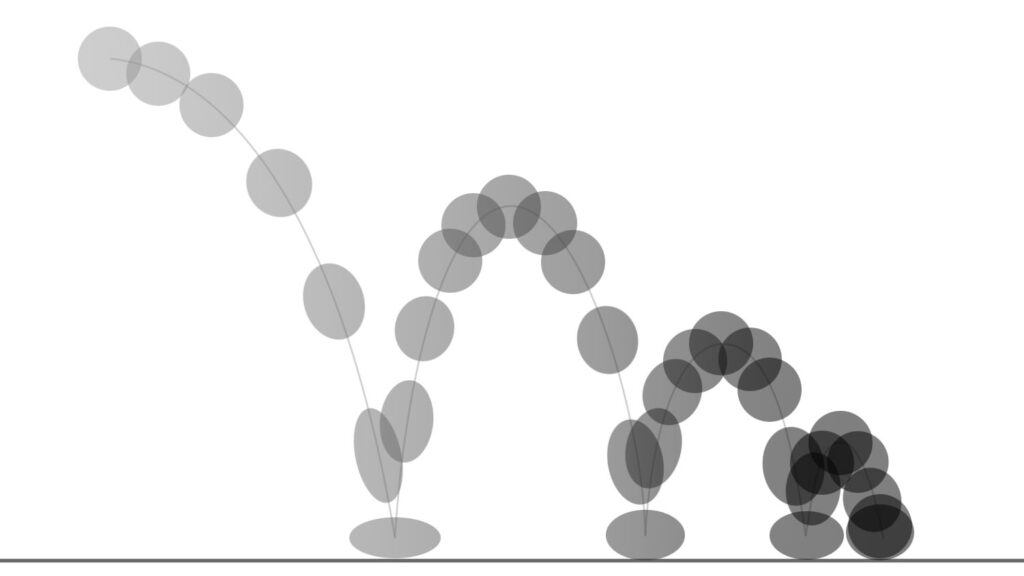
The traditional “bouncing ball exercise” that we will now briefly talk about, if we think about it, compared to Michotte’s scenario simply replaces one of the two objects on the field, object [B], with a totally “passive” and static one (although we will see that it too can in turn be in some way “animated”) which – conventionally – we define as “GROUND”, but which could be any other “fixed” ideal object against which the object [A], or conventionally our ” Ball”, exercises its action: it could be a “wall” or a vertical barrier, if the movement develops in a horizontal line, or even any other stationary object, even a second Ball, as long as it is fixed compared to the first.
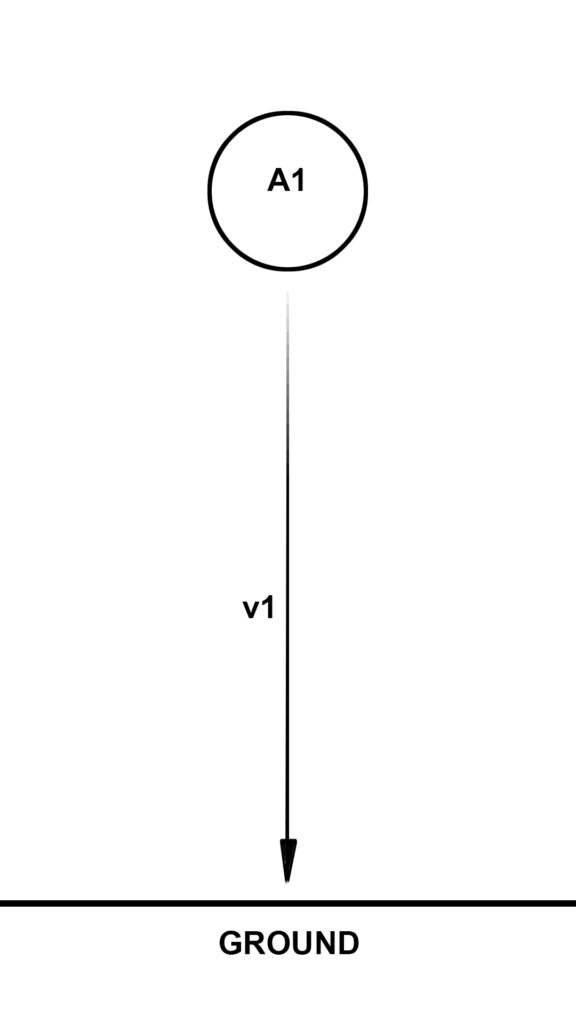
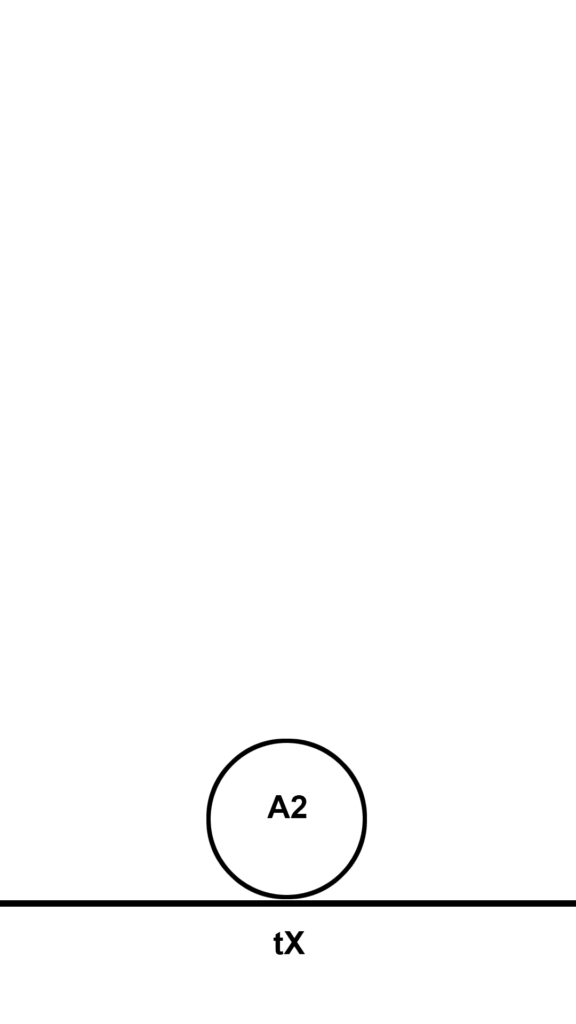
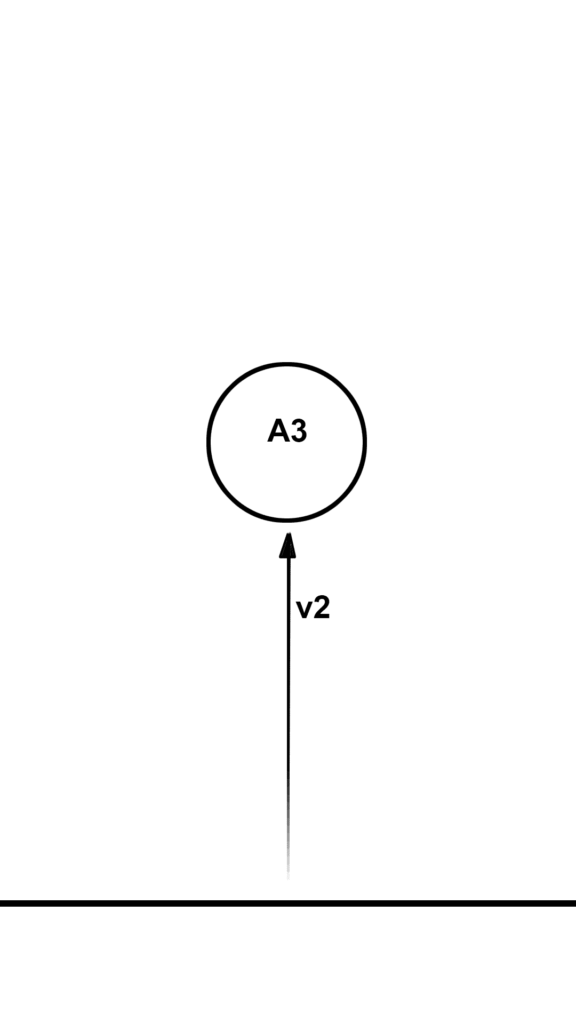
So here it is only the object [A] that performs the action, and this involves both a simplification and an enrichment of the perceptual effect.
In the classic version of this famous (and infamous) exercise (Vid15.08), the “Bouncing Ball” makes use, as in Michotte’s scenarios, of three main parameters: Speed in[v1– in Acceleration] (Fig 15.04) in entry, or fall, Time [tX] (Fig 15.05) of contact with the Ground, and Speed out [v2 – in Deceleration] (Fig 15.06) in exit, or rebound.
By varying these parameters we can obtain different perceptual effects, fundamentally linked to the “physical” quality of the objects (the Ball and the Ground) in play. Here we are no longer dealing with “causality” (and therefore intentionality), but with the “concreteness” of the objects, that is, their mass, or weight, their greater or lesser “solidity”, and the nature of the material of which they are made.
Here too I limit myself to just a few crucial examples.
We know well that by modifying some of the parameters we can obtain different but vivid perceptions primary of the “weight” inherent to the object. And even in this case these are effects inferred by the observer’s perceptive system alone, as the objects in play are totally abstract representations: they “really” have no mass or weight, no concreteness, no three-dimensionality or material, they are a pure representation of an event.
By varying the motion parameters alone, we can make an object convey its greater or lesser weight (mass), such as light as a balloon (Vid15.09) or as heavy as a leather ball (Vid15.10) or heavy as a boulder (Vid15.11).
By acting instead on the contact time of the object with the ground, we can obtain the illusion of a voluntary action on the part of the object: the ball, once on the ground, ideally picks up momentum and makes a voluntary leap, no longer just rebounding (Vid15.12); up to obtain, when the contact time exceeds a certain threshold, the cancellation of the effect itself, two separate outward and return movements, with no longer any cause or effect relationship between them (Vid15.13).
But at this point a completely new and original element appears in the mechanics of the bouncing ball: the Squash & Stretch effect.
This is an effect unique to animation, and Albert Michotte would certainly have considered it spurious, extraneous to the object of his research. For us, however, it represents a fundamental turning point, the one in which the object is charged with its own, vital energy, in itself and not just in relation to another object, as was the case for example in the “escape” effect of the “causality” experimental set illustrated above. It is no longer a “cause and effect” phenomenon, but an internal impulse within the object itself. The object becomes fully “the subject” (or “the actor”) of an action.
In the classic example (Vid15.14) the sole presence of the Squash & Stretch effect is limited to making the movement more “fluid and natural” to the observer’s eye, but it is enough to modify a couple of parameters (Contact Time and Acceleration – Vid15.15) and the event takes on a whole new meaning. It is no longer a more or less passive “bounce”, but it is the ball itself that dampens the impact of the fall, gains momentum, and voluntarily jumps away.

Squash & Stretch are still two completely arbitrary parameters here, as they have no direct basis in objective reality. If we test a sequence shot from life (Fig15.16), for example, we can actually “see” the Stretch as motion blur, which is in any case an artefact due to the sampling of the movement from a shutter at 25 fps, while we practically do not see any visible trace of the Squash.
Actually, a “squashing” effect of a real elastic ball is physically present, but to an almost imperceptible extent, which brings us to another of the primary “principles” of classical animation, as we will see later: the exaggeration (Fig15.17).

Finally, if we simply eliminate the “entry” movement and keep all the other parameters intact (Vid15.18), we will get a true minimal animation of an object gaining momentum and voluntarily making a leap upwards.
The object, which up to this point the movement transformed into the subject of an action, thus fully becomes an “Actor”.

But at this point we are about to meet another famous funny and silly guy: the flour sack.
Acting Is Feeling (Part I)
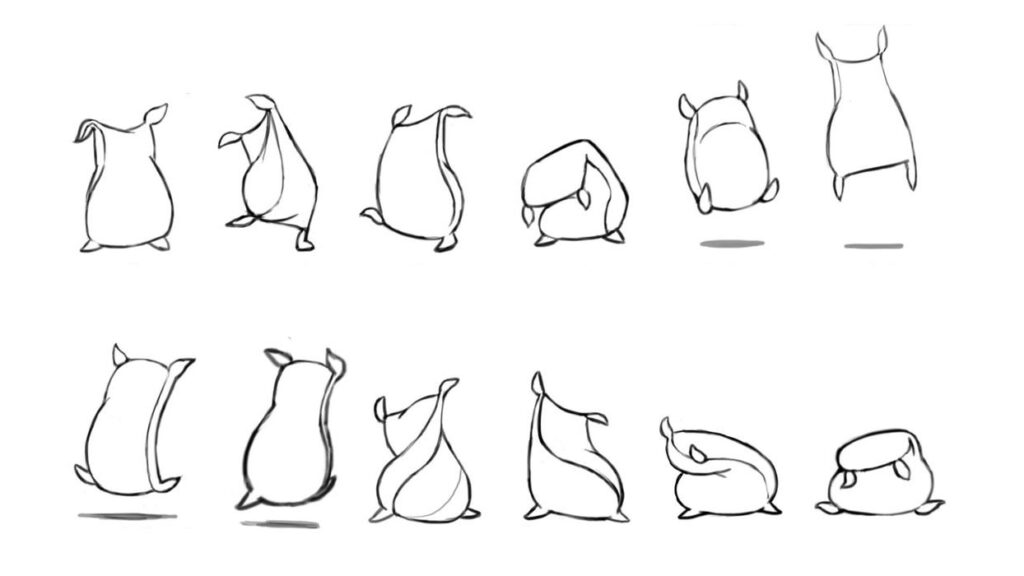
I – Vision and perception
We have seen, so far, how and to what extent the “time-dimension” can act on the perception of an object, even reduced to a very simple two-dimensional geometric graphic representation, deprived of any redundancy of characterization. By varying some space-time parameters we can obtain perceptual effects that are totally different from each other, which can range from a totally mechanical passive or cause/effect movement, up to representing a subjective intentionality and, potentially, a consciousness.
These effects can be defined as “illusions”, as they are totally attributable to our internal perceptive system, being devoid of real physical evidence; they have no volume, mass, matter: they are precisely pure representations.
Something very similar happens, if we think about it, with perspective, which in a two-dimensional projection “forces” us to perceive the third dimension, which in reality is also completely virtual, deduced or presumed, so to speak, from our perceptual system, probably even at the level of neuronal organization.
In the field of the psychology of perception, as is known, a broad debate remains open on how much and to what extent a profound “innate” conditioned reflex, in some way the result of automatic adaptive mechanisms, acts on these perceptions – or illusions. And how much is not rather the result of a subsequent adaptation, or rather of a form of learning by the subject in response to environmental stimuli.
That is, in other words, how much of this perceptive mechanism is already ready for us at birth, to immediately facilitate our orientation in the environment and therefore our survival as individuals, and how much and to what extent instead it is the experience of our interaction with visible reality to shape our perceptive faculties in order to adapt them to environmental demands. The entire discipline of the psychology of perception was conceived precisely to provide answers to these crucial questions.
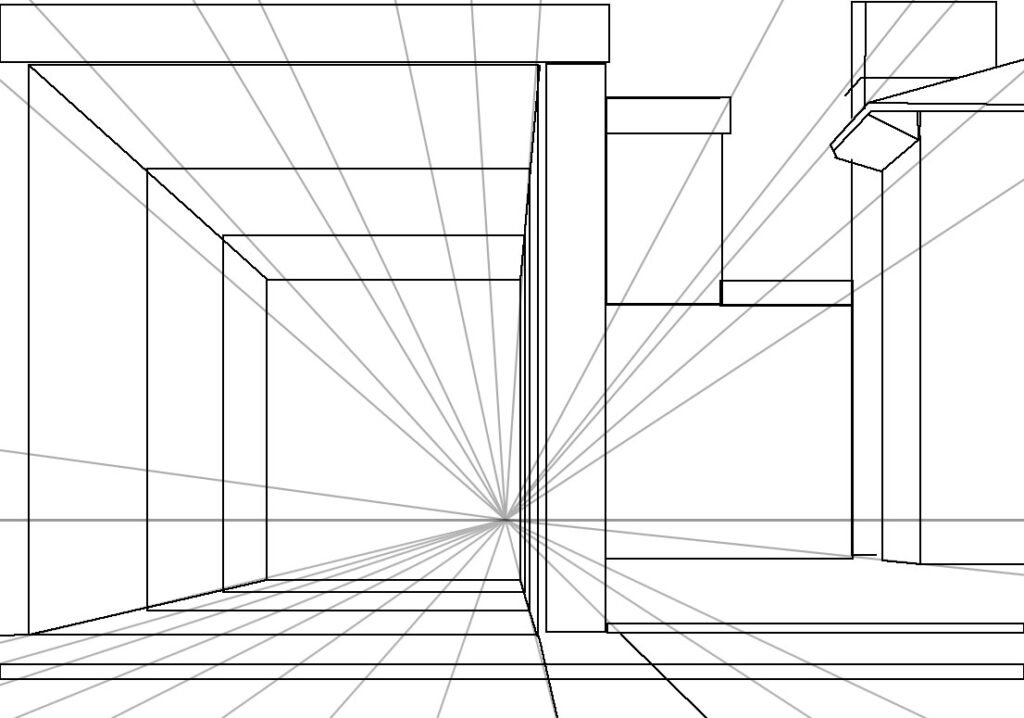
As regards perspective, it is clear that vanishing points and perspective lines do not exist in nature, however they are a codified rational representation of how our cognitive vision reorganizes reality to adapt it to our innate experience that a distant object appears more smaller than a nearby one, and that the latter partially or totally hides the distant one from view. And that the distant object “continues” to exist in its entirety of form even behind the shielding of the nearby one. Or, conversely, that if we see an object that hides and is proportionally larger than another, it “must” be closer to us.
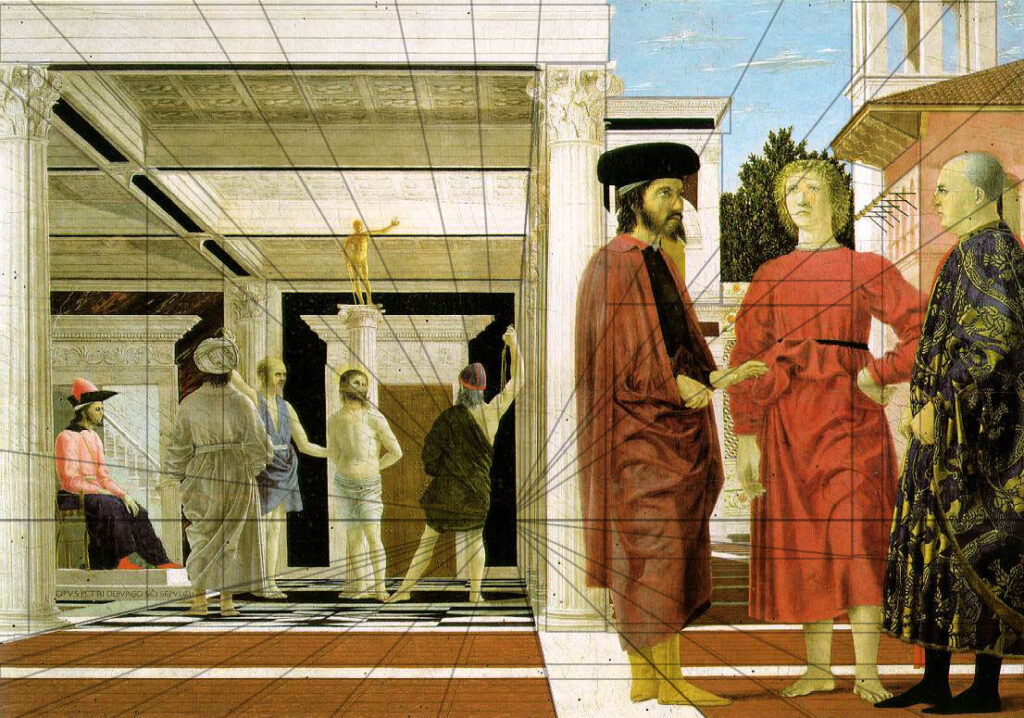
As we know, this “codified” representation of three-dimensional space on a two-dimensional plane was developed and successfully established only in relatively recent historical times (in particular, in art, after Piero della Francesca [Fig_16.03]), and this demonstrates that it is not an “innate” precognition, but is the result of a cultural accumulation of experience and knowledge which only later intervenes to enrich our ability to read and interpret the images we see or produce.
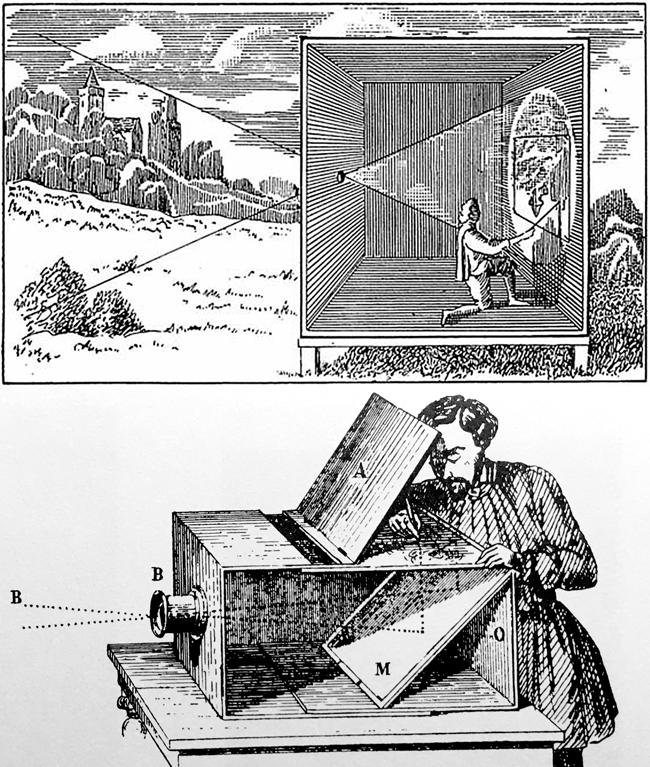
Some primitive cultures are not able to interpret perspective drawings as a three-dimensional representation, and only late, in our culture, photography – an objective “mechanical” copy of reality – confirmed our geometric predictions. After all, it was another older technical artifice, the camera obscura – in use by smart artists already in Piero’s time, and by Piero himself [Fig_16.04] – that made the theoretical-practical definition of the perspective system as we know it today.
But what matters at this point is to understand that, even in a very schematic and elementary representation, our perceptive system “cannot help but” interpret that same two-dimensional representation as “three-dimensional” [Fig_16.02].
Here I have deliberately neglected binocular perception, or stereoscopy, where other more complex physiological and optical components come into play, which go beyond our field of investigation; while the “classical” perspective remains anchored to the projection on the two-dimensional plane, and remains, despite being, as we have seen, a conscious codification of perceived reality, once again, a very constraining illusion for our cognitive system.
II – Perception and Illusion
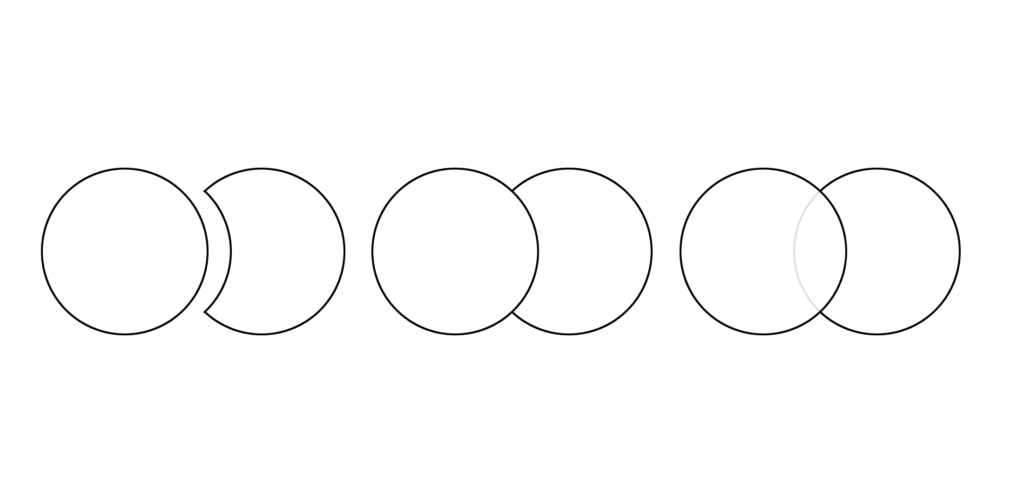
Just above we mentioned how our perceptive system creates “false perceptions”, which we called “illusions”, in an attempt to match the sensory data produced by visible reality, with the expectations created by our own cognitive system. For example, a white disk moving frame by frame on a black background at 25 Fps is interpreted as “a ball moving on a plane”.
A white disk placed next to a crescent moon shaped object cut to match its perimeter is perceived as a disk that overlaps with another disk, partially concealing it [Fig_16.05].
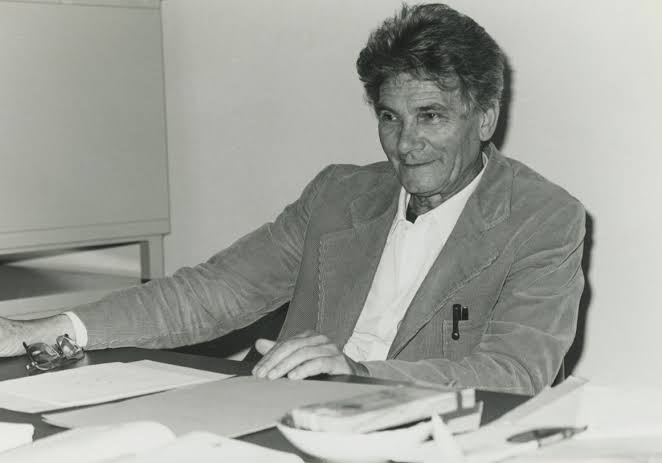
To better understand the thin border that exists between illusion and perception, there is nothing better than mentioning at this point one of the most classic (and well-known) representations of experimental psychology, that of the so-called “quasi-perceptive triangle” invented in 1955 by professor and psychologist Gaetano Kanizsa (whom I had the privilege of having as a teacher during my years in Trieste).
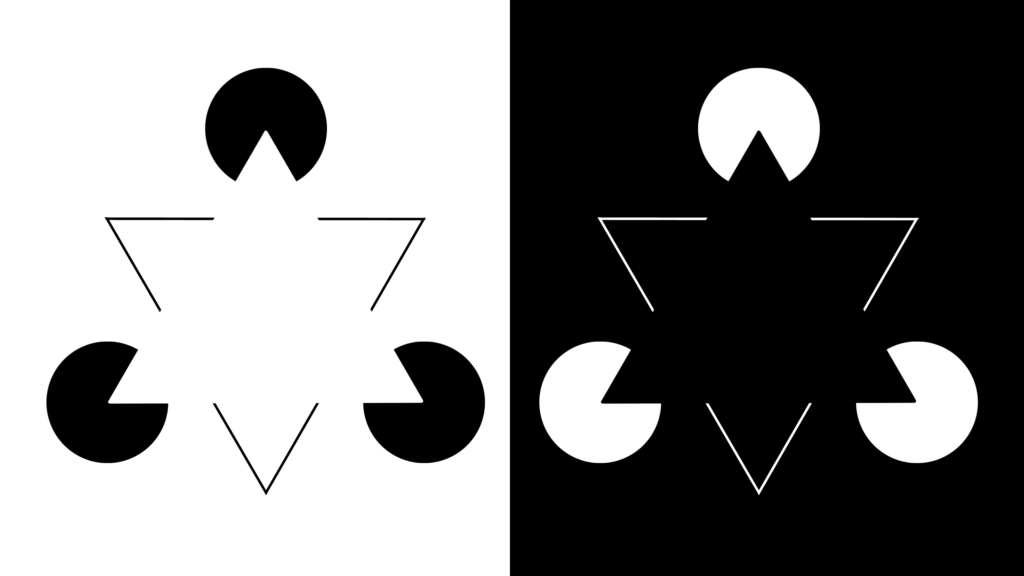
As is known, in this representation the central triangle, in ideal light conditions, appears to an ingenuous observer not only as a visible figure and describable as a “triangle”, but also significantly “brighter” compared to the background, when evidently there are no lines or contours that define this figure, and the background is completely uniform.
In other words, our brain instead of perceiving reality as it is, i.e. a set of black geometric figures arranged on a white background (or vice versa) in a certain order in a two-dimensional space, reorganizes it by creating correlations based on its expectations, dictated by experience and our perceptive system.
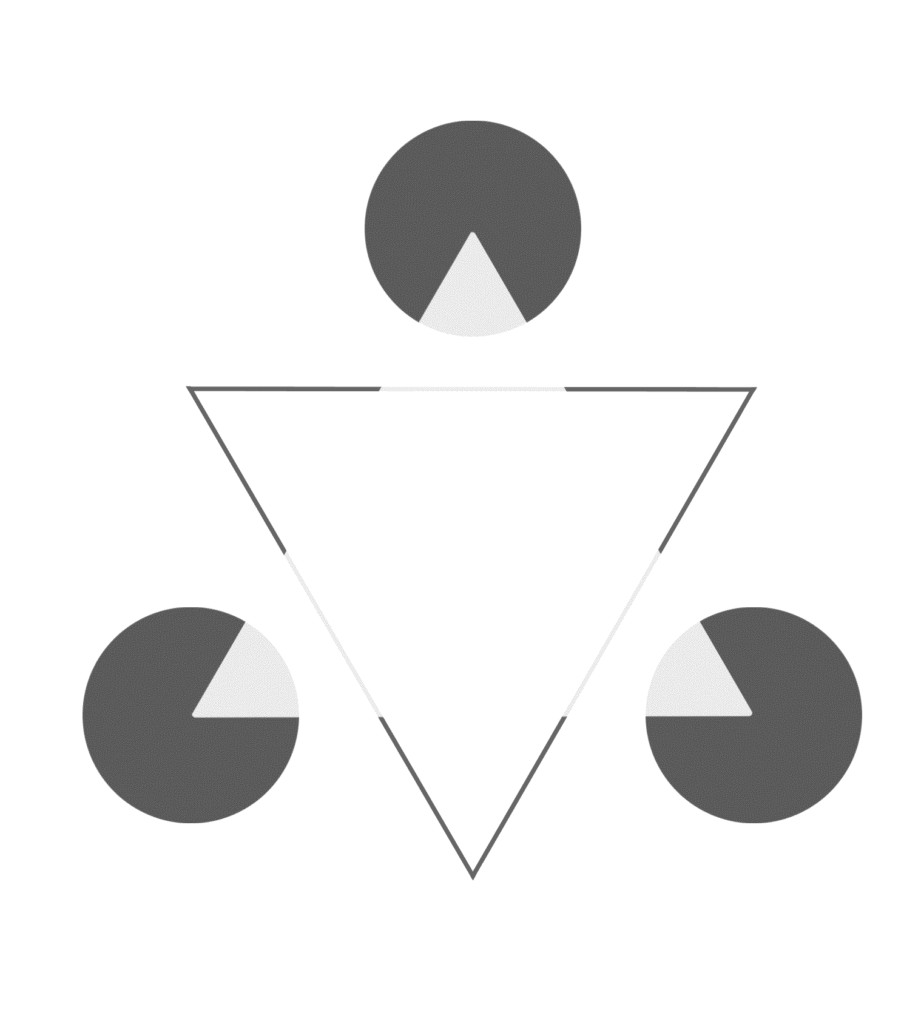
In this case, an innate law of continuity is imposed whereby a form that overlaps with other forms must necessarily cover the latter, which we imagine as continuous beneath it [Fig_16.08]. Our mind then reorganises the image in a way consistent with its innate expectations, whereby the black figures overlap with the white background and, for continuity, presuppose the presence of a white triangle above them, which in turn also above the white background, and to adapt it to this visual scheme, it virtually accentuate its brightness, creating a “contrast margin” (the outline of the virtual triangle, as illusory contours) which is effectively non-existent in the real physical image.
The so-called optical illusions exploit this coercive characteristic of our vision to create completely virtual images, non-existent in objective reality, but present in subjective vision. The triangle in [Fig_16.07-16.08] does not “exist” on the sheet of paper, it does not have an outline, a margin, a contrast that differentiates it from the background, yet it is clearly present in the observer’s vision, so much so that the majority of subjects will without hesitation describe it as such. This clearly demonstrates how our “innate” preceptive system precedes, and in some cases can even replace, the cognitive one in a scale of priorities.
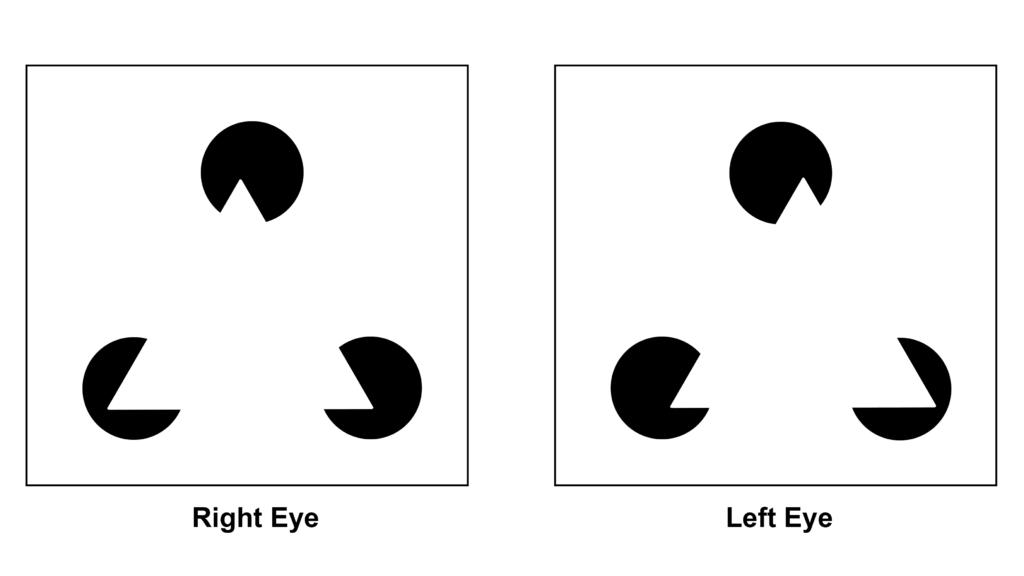
If you can collimate your binocular vision with this figure, you will be able to see a rather bright triangle that stands out in depth from the black disks in the background.
Similarly, as we have seen, the laws of movement work which determine the phenomena we described above as “causality”, “intentionality”, “rebound”, “jump”. In any case, these are patterns preordained by our perceptive system, regardless of our knowledge and experience of the environment and the objects that trigger the events described. Our brain is, so to speak, biologically set (and therefore in a certain sense even forced) to interpret that certain temporal sequence of images as an ongoing event, and no longer as a series of fixed images one independent of the other.

The moment we add a fourth element, squash and stretch, things change. In fact, squash and stretch is no longer an “innate” perceptive parameter, but comes from our active interpretation of reality, a scheme learned from experience, from culture, and codified in a geometric synthesis, just like vanishing points and lines are in the traditional perspective representation, from the Renaissance onwards.
And it is precisely at this point that mechanics is replaced by biology, by life: we could say that in our eyes an object becomes the actor of a voluntary and conscious action, acquiring a body, a living self.
III – From Illusion to Representation
This is therefore why our “flour sack” is not as simple and trivial an exercise as it may appear at first glance: it is instead a crucial example to fully understand these dynamics. Here we are still in a delicate balance along the very thin line that discriminate the innate, what our perceptive system presents to us as a predictable representation of the world, from the learned, what we add to it from our experience of this same world and its physical and material reality.
As you may have noticed, in the classic examples the draftsmen usually add small appendages to the four corners of the main shape, to symbolically simulate limbs, or extremities, hands and feet. This helps to characterize the “character“, which is devoid of other clues, such as eyes, a face, a head and a body, but in my opinion it is superfluous here. The same results can also be achieved with a perfectly clean shape, deprived of any hint of characterization.
For this example [Fig 16.10] I eliminated all the appendages, and I kept the same spacing and timing scheme as the jumping ball presented above [Fig 16.09], to demonstrate how this scheme applies almost without substantial modifications to a subject apparently more complex than a simple ball. What appears for the first time here, and which substantially changes the quality of perception, are at least two additional pieces of information, defined precisely by the application of the Squash and Stretch and the articulation of the shape:
A – The recognisability of the object as the stylised image of an actual “sack of flour”.
B – The perception of volume, weight, upper and lower part of the body.
It is these clues, projected onto the object by our experience and culture, that transform the object into a “sack of flour”, and therefore the “sack of flour” into the character “Flour Sack”. Which, particularly when we move or animate it, acquires expressions, even a hint of arms, legs, head and body, all virtually. And this happens because we project onto this character our cognition and our experience of how an “animated” character should move and feel.
It is no coincidence that all this has always been widely used by animation, throughout its history: from the whistling sirens in “Steamboat Willy” [16.11], to the naughty Sugar Bowl in “The Sword in the Stone” [16.12], to the showy Carpet in “Aladdin” [16.12] (which is, among other things, a spectacular, almost direct application of our Flour Sack), simply because it is something that only the animation technique can achieve.
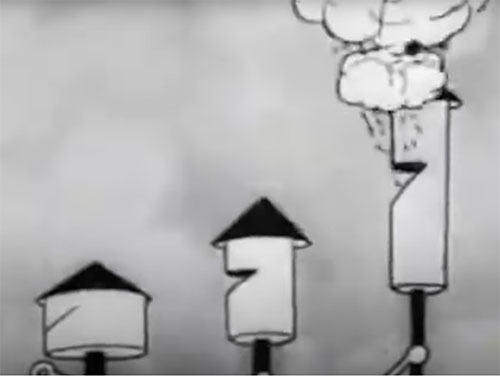
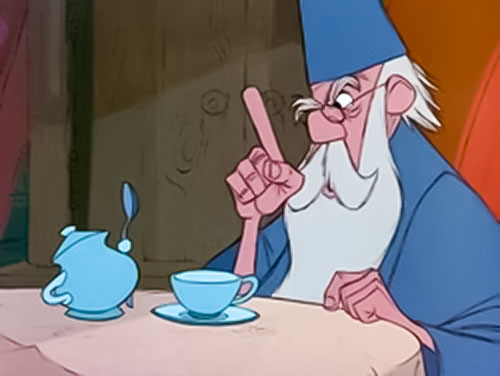
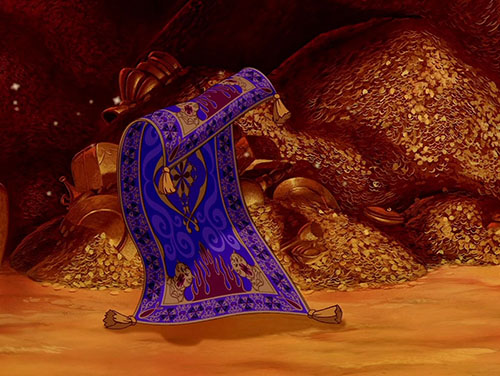
Here my effort is above all to try to get out of the didactic formula, which is the most common approach with which these exercises are presented, and to understand their profound meaning, which goes well beyond the pure mechanics of an exercise.
As we said, our “flour sack” is no longer the “flour-sack-object”, but the “Flour-Sack-Character”, and as such it is not only capable of performing movements on the stage, but to express emotions through them, to act, speak, narrate, and therefore, in this way, it becomes in every sense an “actor”.
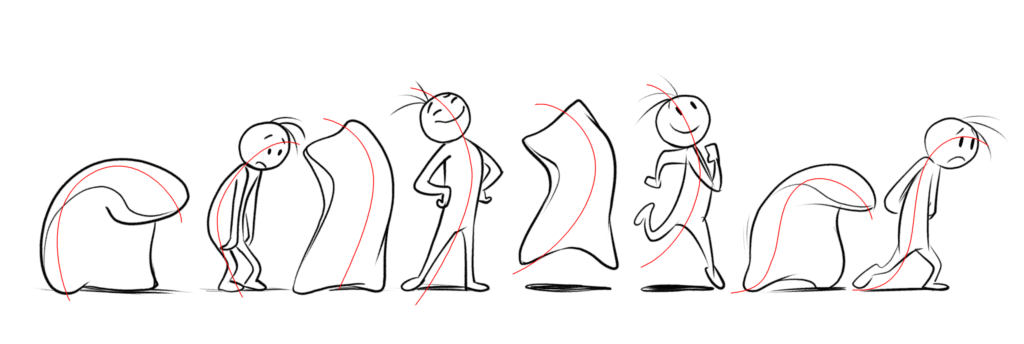
In the classic illustration we see how we project into the poses – and movements – of the flour sack attitudes that bring us back to a humanized body language, or rather what experience and culture has taught us about it: a curved and floppy flour sack is sad and demoralized, one who is erect and strutting is bold and excited, one who jumps lightly is lively and happy, one who shuffles along with slow steps is humiliated and heartbroken.
So far we have limited ourselves to body language, but the same process of synthesis and projection also occurs, and to an even greater extent, throughout that immense territory which is that of facial expressions.
Also in this case our system starts from a series of innate elementary schemes and is then applied to increasingly complex and “subtle” representations, as we gradually introduce in it our experience and the learning, also from a technical point of view, of the depiction.
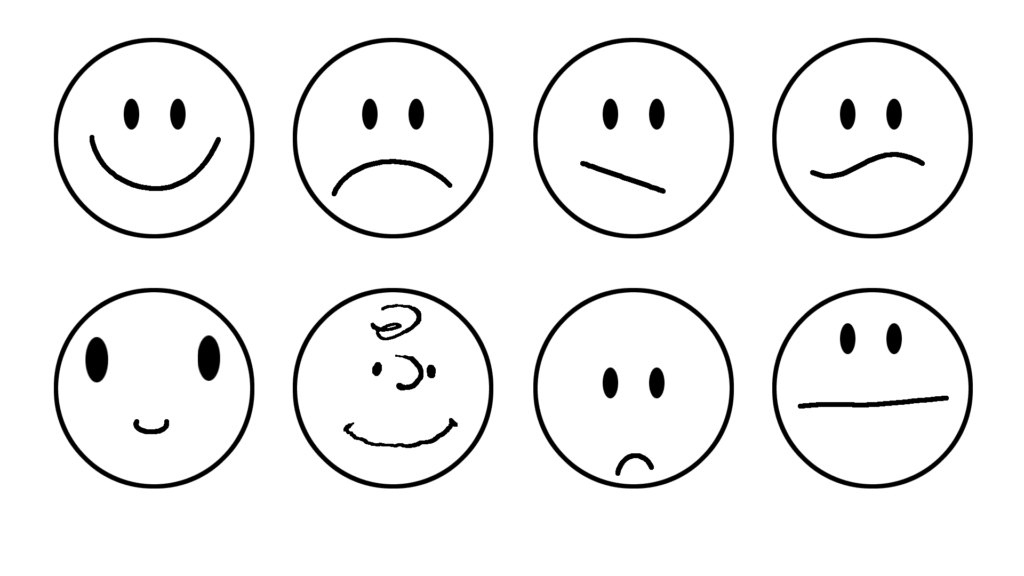
The minimal graphic equivalent of a face is, as we know, the so called “smiley” [Fig_16.15], where a simple circle, two tiny points and an arc section arranged in a certain way suggest to us, or rather, actually make us recognise a “face” in a way so overbearing that we are surprised by it every time. This is certainly an innate pattern, the one that pertains to the “reading” of a human face, indispensable for our survival. What is even more surprising is that by appropriately modulating the shape and arrangement of these elements we can obtain a very vast range of “expressions”, and even subtle nuances of them. And we can see the consequences of this throughout the history of the graphic representation of a “human” face, from the “laught and tears” masks of the Greek Theatre to… Charles M. Schulz’s Charlie Brown.
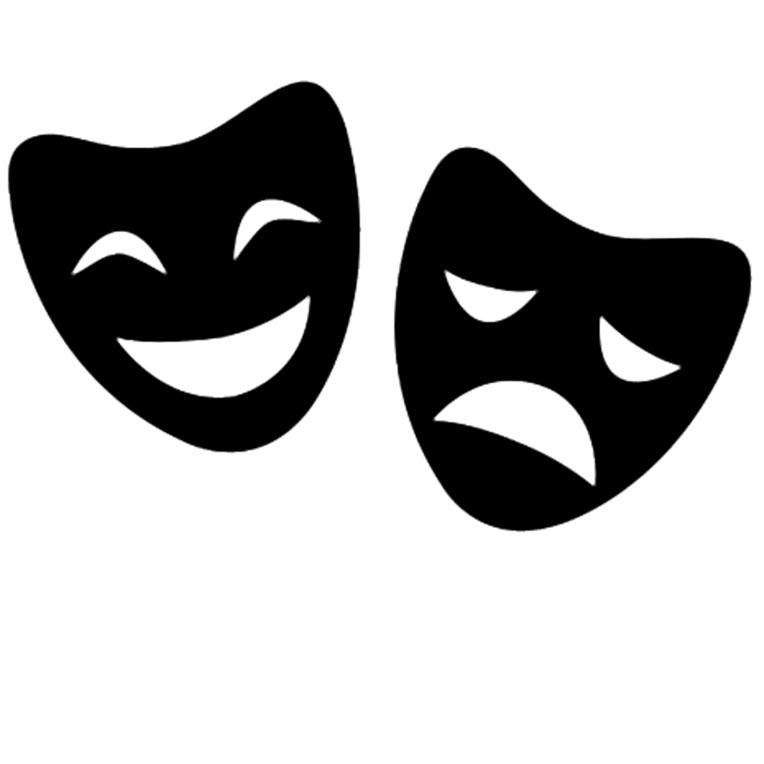
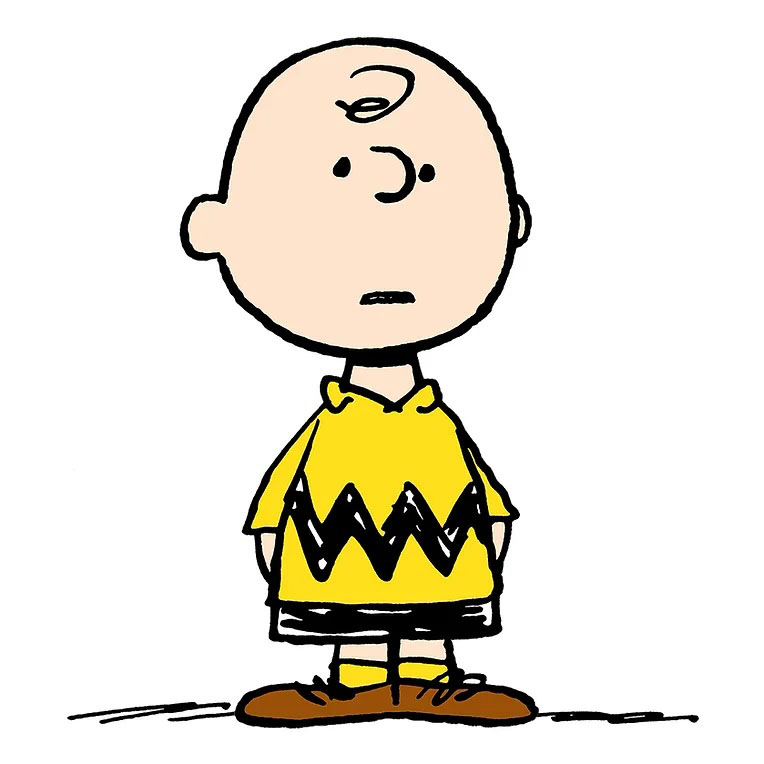
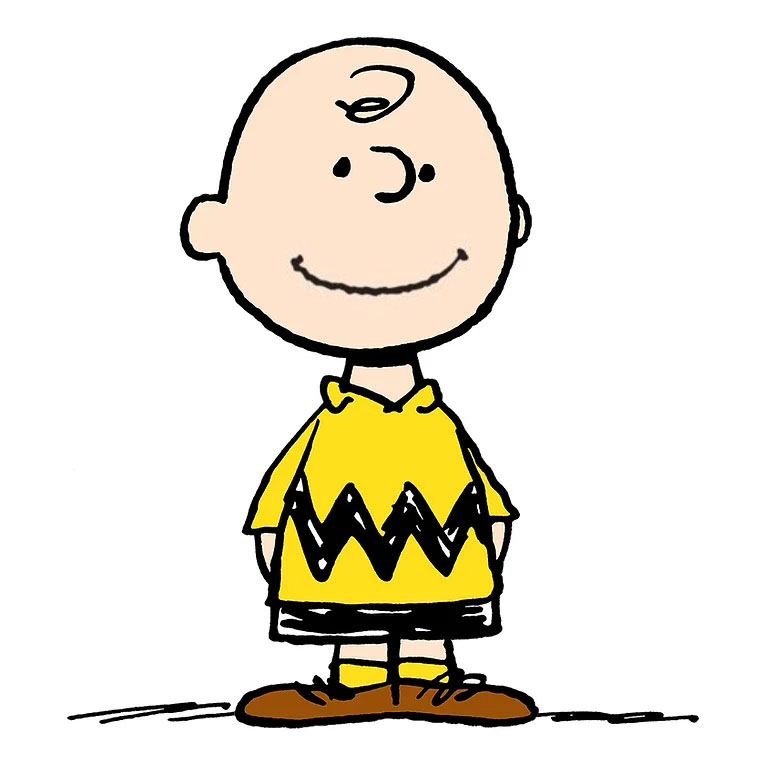
The thing that always surprises me, however, even after decades of practice in the art of animation, is how a character, especially if animated in an excellent way, acquires a truly autonomous life, and in some way seems to detach itself (himself?) from the control of those who animated it. I think we’ve all had a similar experience when reviewing our own animations, especially after a certain amount of time.
Yet we know well that our character, without the intervention of our hands inside its secret mechanisms or to handle the invisible threads that support it, would be, literally, an empty bag, an immobile and lifeless puppet.
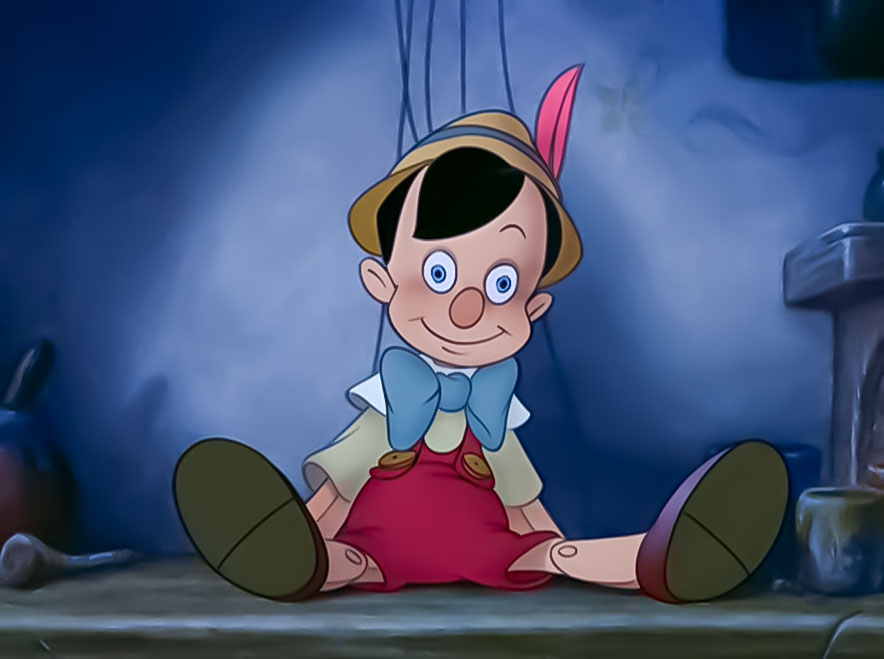
So, who is really the “actor” in this play?
Acting Is Feeling (Part II)
IV – “Mirror, Mirror on the Wall…
Who’s the Best (Animator) of Them All?“
What’s a looking-glass doing on my former old-time animation desk?
We, as artists, are all a bit narcissistic, it’s true, but this is not the reason why that particular object is there: in reality it was for many years, before any camera or smartphone appeared, one of the main tools available to the professional animators, as we will see in a little while.
In the previous paragraphs we followed a rather linear path, which led us to understand how, for our perceptive system, movement changes into action, action becomes perception, perception becomes illusion. And, finally, illusion is organized into representation.
Right in the last step, the one between illusion and representation, we therefore witness a dramatic “leap in quality”, where we move from the sensorial sphere to the emotional one.
And this passage is mediated by what we have defined as the second pillar of the art of animation, namely: acting.
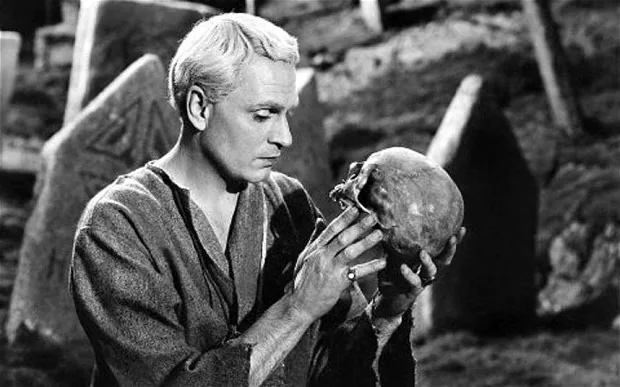
However, things are not as simple and immediate as they may appear, because acting requires the presence of an actor to be expressed, and what we see on the screen is not a “real” actor, but a drawing, or an image however produced by an artist. So, WHO is the actor in this performance? I mean, the character, the puppet, or the person who moves it?
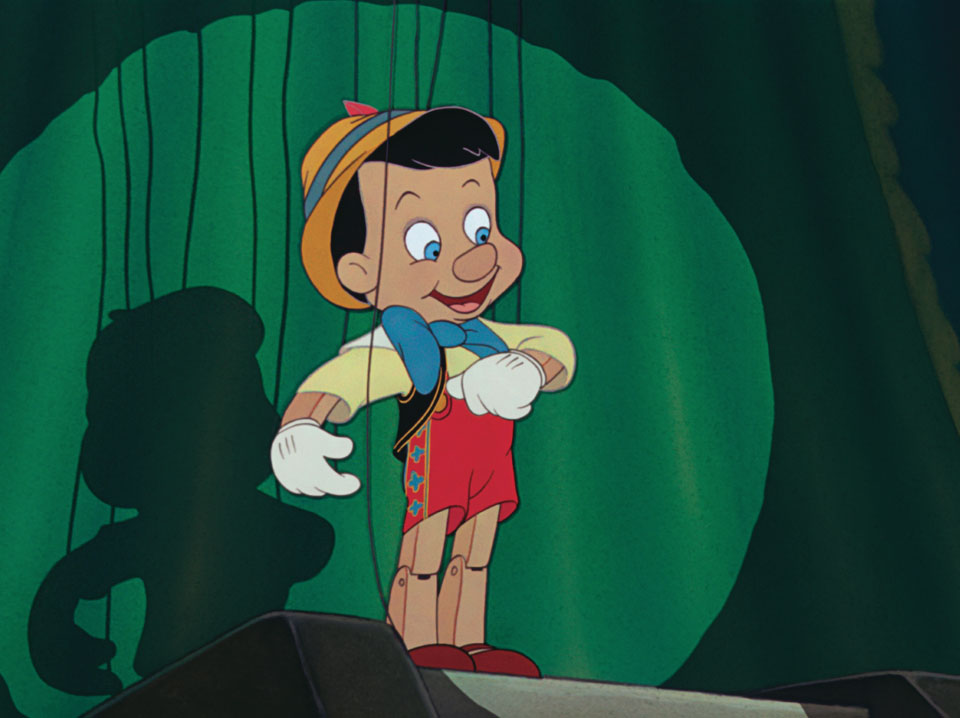
For the audience watching the performance there are no doubts: due to an ancient covenant pre-established by the laws of entertainment, the actor is the character, while instead the strings and the puppeteer who moves him (it) from behind the scenes, are invisible; indeed, for the representation to be fully credible and enjoyable by the public, they MUST be invisible. We can say that all the art of animation is aimed at realizing this invisibility as best as possible, so much so as to make it, ideally, an absence.
This too is a “perfect illusion”, and it is precisely in the search for this perfection that art reveals itself. Just as in the art of dance we see the lightness and the grace, and never anything of all the technique, work, effort, sacrifices and commitment that were necessary to put it on stage.
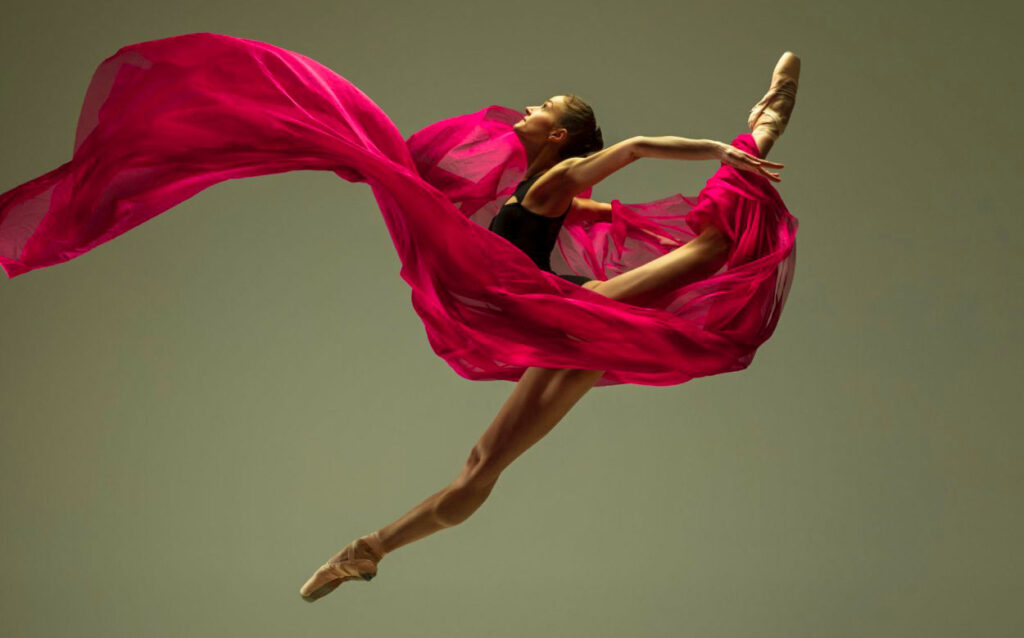
Here, however, we need to be careful: in animation the concept of “actor” is apparently very different from what is understood as such for the rest of the entertainment field: the animated character (drawn or generated) who acts on stage is not “real”, nor even a photo-cinematic reproduction of a possible staged reality: it is a drawing, or an image created from nothing on a screen, and for this reason it cannot properly be defined as an “actor”.
But if we try to read a standard definition of the term “actor” in a dictionary, we can find for example: (Cambridge Dictionary) “someone who pretends to be someone else while performing in a film, play, or television, or radio “.
Which means that the actor is not the character (the image) we see on stage (screen), but the person who drew/moved it, that is, the animator himself, who “pretends” to be that character. He is “the person who”, literally, “portrays the character”: and this has many important implications.
The first, and most obvious, is the well-known fact that the animator is not just a draftsman, nor does he necessarily have to be (many animators never touch a pencil to create their animations, as we know), but is also, to sometimes above all, an actor.
And this implies the second of these facts, namely that the quality of his animation will be all the higher the more refined his talent and technique as an actor is. Because, just as the quality of drawing in a traditional animator is never completely innate, but develops and refines with practice and application, so too is his acting ability.
This is a point, I must say, a little overlooked in many animation courses, also due to the purely the purely technical and organizational difficulty of combining the primary course with an effective parallel acting course.
Many animators, even after having reached a professional position, often enroll on their own initiative in fine arts and life drawing courses to refine their technique, and this naturally has a great value in the artist’s training, but not many feel the need to do the same thing with an acting course, also because it is not at all easy to find a qualified course, and even more difficult, if not impossible, to find one that deals more specifically with the techniques that would be most useful to a character animator. As far as I know only a tiny fraction of the best animation schools try to manage such courses internally.
Yet it is a skill of fundamental importance in the training of a high-level professional animator, and, with rare exceptions in which the animator is a “natural born actor” (yes, there are some around!), it is not always sufficient to rely on one’s own innate abilities, or just refer to actors seen in films or at the theater. If an animator is a mediocre actor, or even worse, if he believes he is a good actor without being one, he is unlikely to achieve levels of true excellence in his work, especially if he is engaged in high-quality productions such as feature films and flagship series.
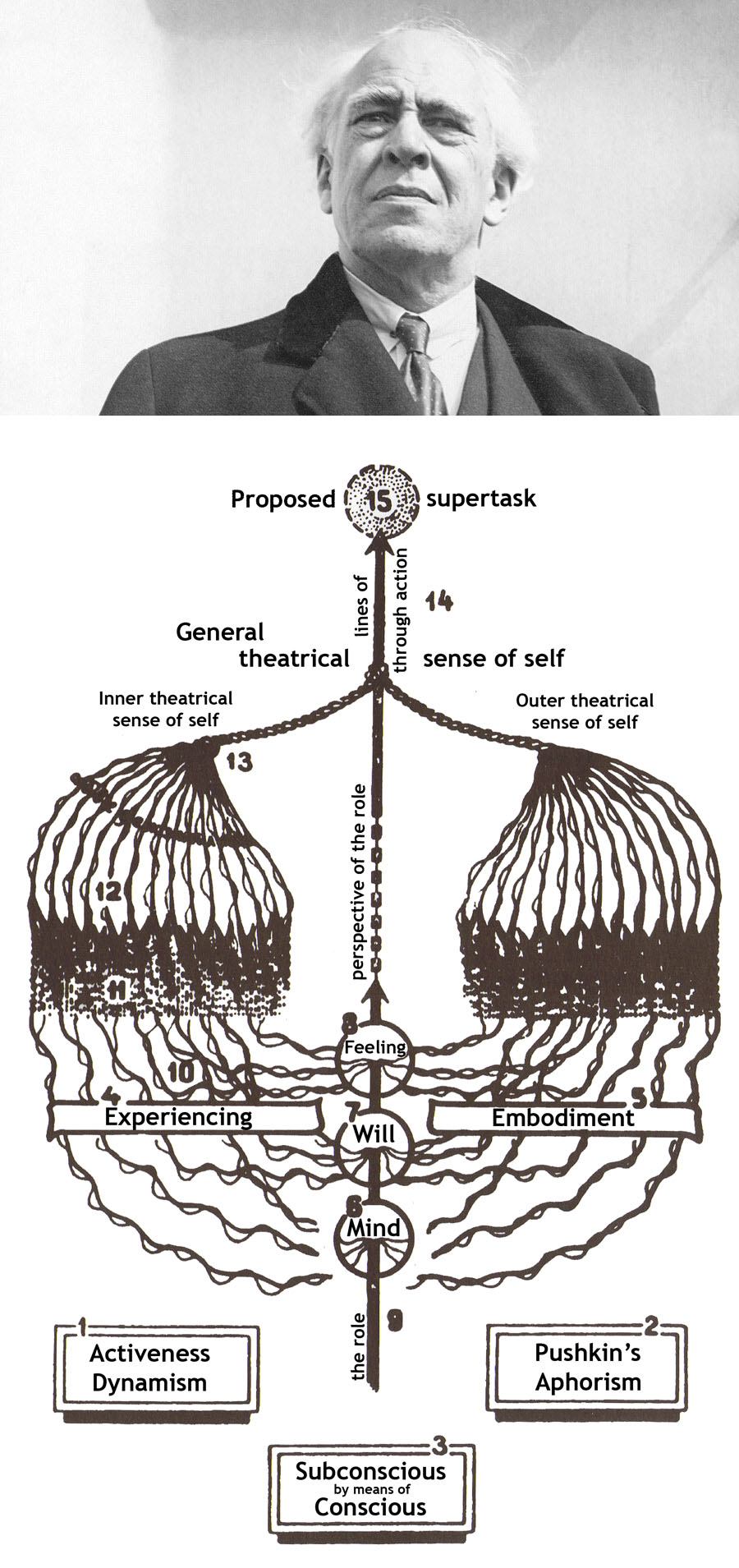
The acting technique that an animator expresses is much more similar to that of a film or TV actor than to that of a stage actor: there is no direct relationship with the audience or even with the other actors, there is no continuity of action for the entire duration of the play, or the act. As on a film or television set, the action is fragmented into shots, almost never arranged in an orderly sequence, and all the work is intermediated by a complex industrial production mechanism. Therefore a specific study approach would be required, not a generic one, like most of the courses available.
However, in the absence of anything better, even to attend a “standard” course in theatrical interpretation, or mime, and/or to read some specific text (such as the three fundamentals essays by Konstantin Stanislavski “An Actor’s Work”, “Building a Character”, “Creating a Role”) can be extremely useful. We will talk about it again in a future dedicated chapter.
For now it is enough for me to underline how what I have defined as the second “pillar” of the art of animation was very clear to animators from the early days, but in particular with the flowering of Disney’s “Illusion of Life”. Everyone, especially the most brilliant of them, relied on their own interpretative ability to obtain the results of absolute and timeless excellence that they were able to achieve.
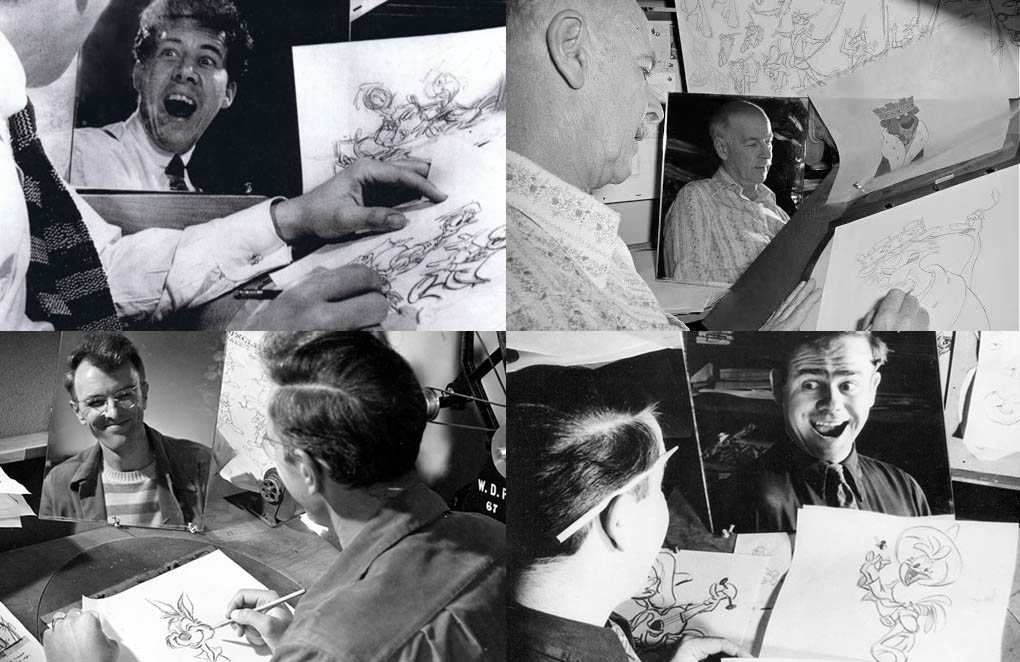
V – Rotoscoping or the “Dead Animation”
However all this should not be confused with the practice, which is now widely consolidated (thanks to the spread of shooting systems within everyone’s reach, such as common smartphones, capable of returning excellent quality and high resolution videos in all conditions of light) to rely on shots of oneself as a reference for the characters’ actions.
In reality, in my opinion, it is a risky practice, if it is used slavishly, just to get out of trouble in a short time in more complex scenes, uncritically following the outline of the reference film.
Today this technical “help” is widely used in 3D animation, which lends itself easily to this “re-tracing” work given that the consistency of the characters with the models is guaranteed by the tool itself, but in reality it is not something new, on the contrary.
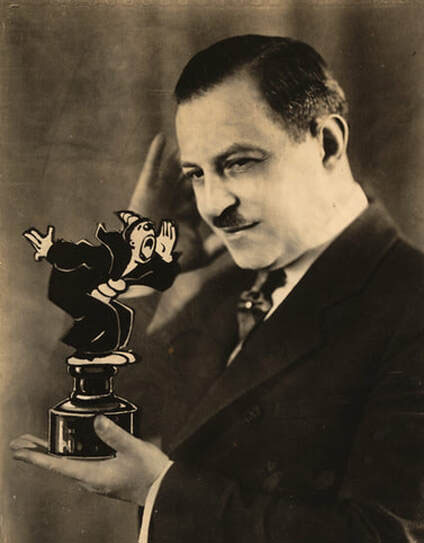
In the past to shoot reference footage it was much more complex (and also time-consuming and expensive, which made it accessible only to the largest studios, and certainly not to individual animators): stages equipped with 35mm cameras were used, long later eventually even with Beta, Umatic or VHS cameras, which however returned images of poor resolution and difficult to “stop” frame by frame and re-trace over a TV screen.
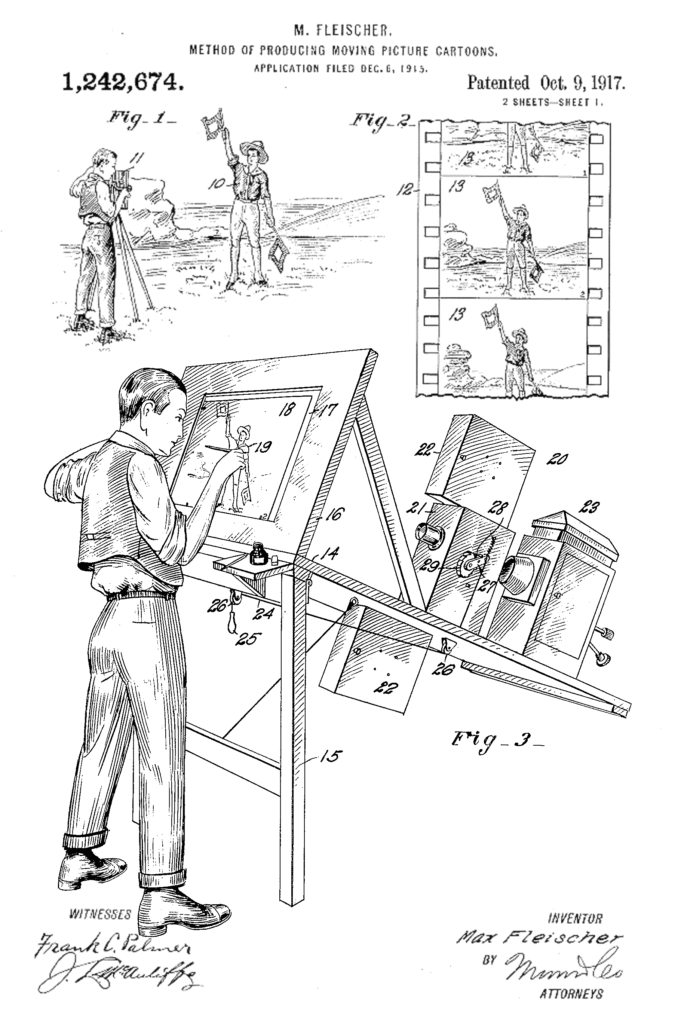
In reality this technique, which was called “rotoscoping”, became part of animated production very soon, so much so that its invention is today credited to the Fleischer Studio, which introduced it already in the late 1910s and in the early 1920s.
This technique, which consisted in the direct projection of the filmed image onto a work surface, on which the “draftsman” (who was no longer an “animator” at this point, since the movement of the character was entirely entrusted to the filmed shot of the actor/model) literally manually re-traces the photographic image frame by frame, giving it later the features of the character.
Disney Studios soon took possession of this invention: already from the end of the 1930s (in particular starting with Snow White – 1937) the animators of Hyperion Avenue relied extensively on films shot in the studio, especially for the rendering of realistic human characters, a task with which many of the animators of the time had little or none confidence. As often happened at Disney at that time, the Studio modified that technique in its own way, further perfecting it, and inventing its own method, internally called “Photostats”, which consisted of register printing the frames of the reference film on photographic paper of the same format of the actual animation field.
The Disney animators, however, did not limit themselves to tracing the photographic image, but completely re-interpreted the poses, the expressions, the action times, taking inspiration from the model rather than reproducing it as is.
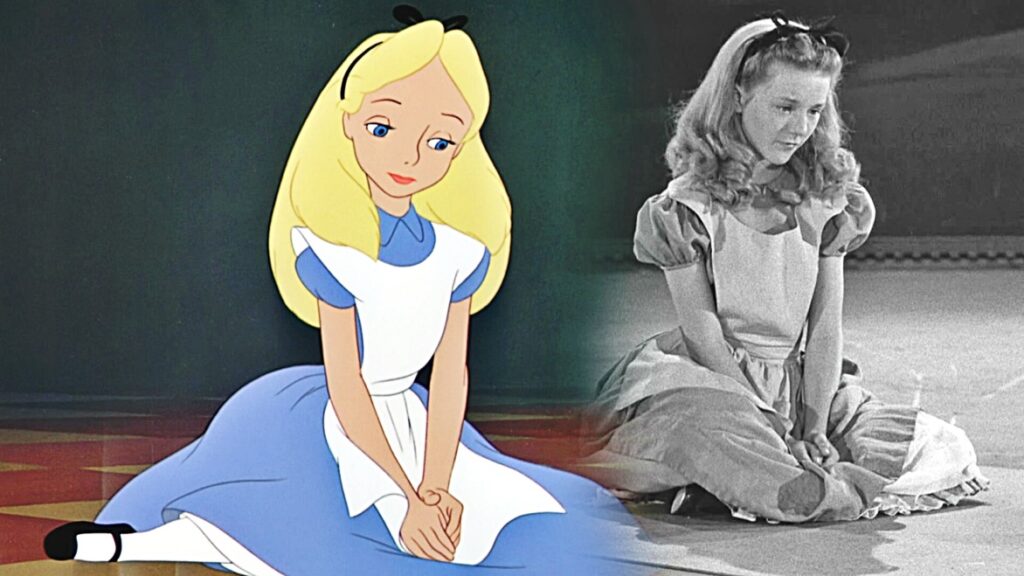
In this way they could maintain much greater creative freedom, they could better adapt the movement and proportions of the live “model” to the animated character, and above all they could apply the “principles” they codified to the animation, such as exaggeration, squash & stretch, anticipation, etc. Finally, in this way they were able to maintain the “vital breath” of the character while using the help of the “reference shot” to obtain more coherent, sophisticated and believable movements and acting than they could have done by working purely from their imagination.
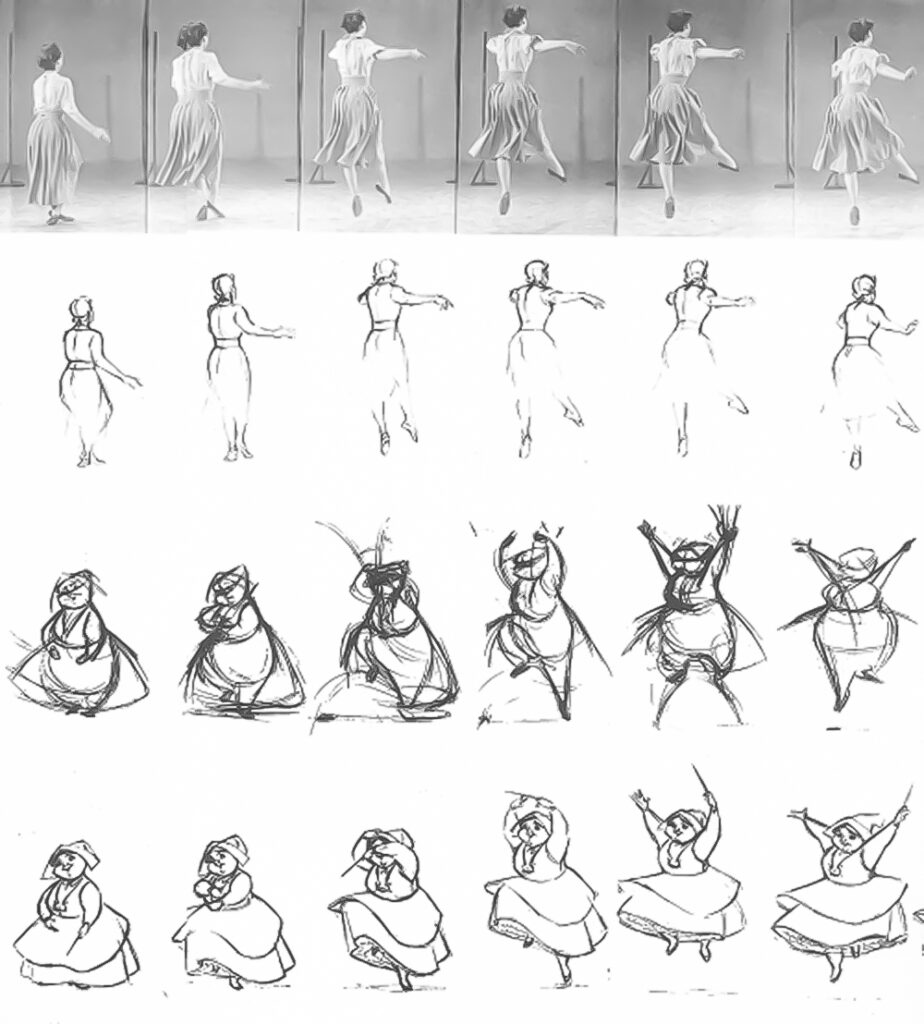
One of the best known examples of this “method” can be found in Illusion of Life by Thomas & Johnston, in the comparative illustration of the use made of it by the animator Frank Thomas for the animation of the character Merryweather (in Sleeping Beauty), where we can compare the drawings traced directly from the photostats with the animator’s processing, up to the final result. In this case Thomas even changed the character’s view from rear to front, while maintaining the key points and timing of the “real” movement.
Later the same technique was widely used in industry, sometimes massively for the creation of entire films, or large parts of films, sometimes with the aim no longer of increasing quality, but rather of lowering costs and speeding up production.
I remember some feature films made largely with this technique, such as some Ralph Bakshi films (“The Lord of the Ring“, “American Pop”, “Fire and Ice”, and the quite bizarre “Cool World” [Fig 17.12] starring Kim Basinger and Brad Pitt). The latter done in “mixed media”, attempting to rather clumsily exploit the track of Zemekis-Williams’ masterpiece and box office hit of a couple of years earlier “Who Framed Roger Rabbit” – unfortunately failing badly in comparison.
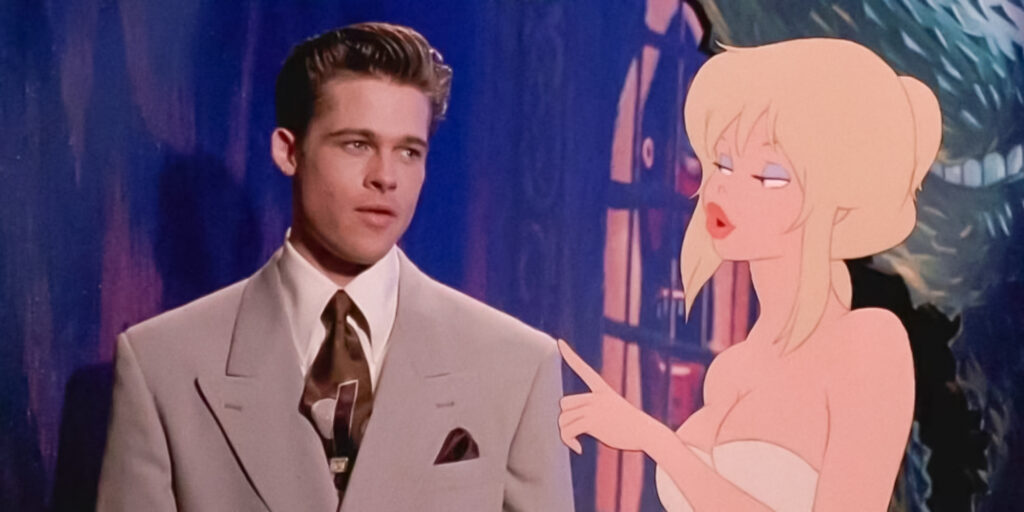
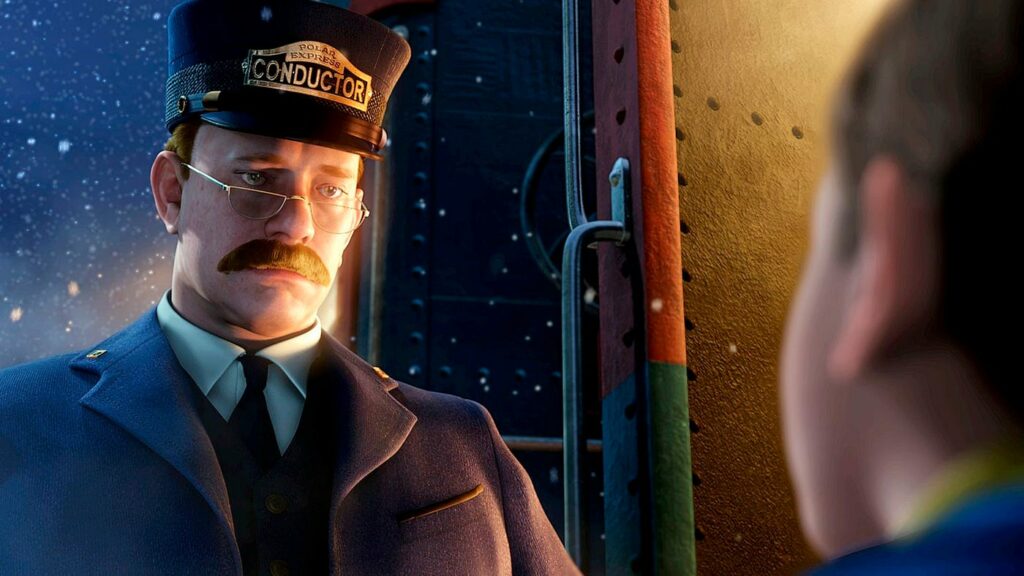
I mention these works, all rather mediocre (but to be honest I must remember that the same Bakshi made his feature film debut with a quite revolutionary movie such as “Fritz the Cat” from Robert Crumb’s iconic strips) because they help me point out a very peculiar effect, and extremely significant for the reflection we are making on the animator’s profession: rotoscoping, although often very faithfully tracing the photographic image, always appears paradoxically ineffective, fake, frozen, incapable of transmitting emotion, which is not the least reason for the substantial failure of these experiments.
In some way, irony of history, Zemekis himself, a director whom I consider a genius, fell for it much later, with the overly extensive, convinced and reduntant use of a very advanced technique, applied to 3D animation, but in background very similar conceptually to the old rotoscoping, such as the Performance Capture (“The Polar Express” [Fig 17.13], “A Christmas Carol”, etc.).
These examples have the merit of demonstrating, so to speak “against the light”, what the work of the animation artist really is, which, as in all arts, is not and should not be a copy, nor a reproduction, but an interpretation of reality.
If we carefully trace a series of frames of a film to reduce it to a drawn character, we obviously carry out an arbitrary synthesis, and in this synthesis we lose a whole series of micro-details which in the real film contribute not only to making it an accurate reproduction of reality, but rather the re-creation of it, in the language of photography – and cinema: the loss of these subtle “details” dramatically impoverishes the image, taking away its realism, weight, psychological depth and likelihood.
In order to recover all these details in the graphic language of animated drawing, it is not possible to simply re-trace the model from life, but it is necessary to completely redraw it, rework it, according to the principles of animation, as we mentioned above.
Disney animators, from Snow White onwards, as we saw it, widely used photostats wherever it was needed, especially for human characters (from Peter Pan, to Sleeping Beauty, to Jungle Book, to 101 Dalmatians, etc.), but they used it without ever giving up applying their animation technique and principles, starting from locate and process keys and breakdowns, rather than proceeding straight forward, frame by frame. In this way the characters maintain their vital quality, remain credible and consistent, both visually and psychologically.
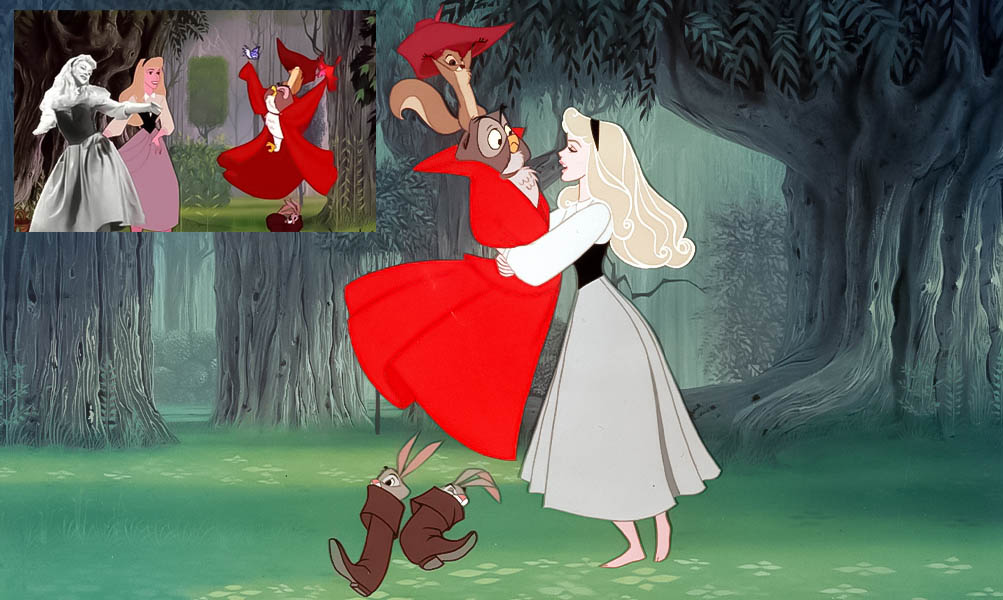
Princess Aurora’s dance with the Owl in Sleeping Beauty is evidently entirely based on the live action filming of an actress-model, but manages to maintain all the charm, appeal and vitality of a believable animated character (i.e. one with a soul), as well as harmonizing perfectly with the other little characters (rabbits, the squirrels, the birds) which are obviously animated from imagination.
VI – Perception and Proprioception
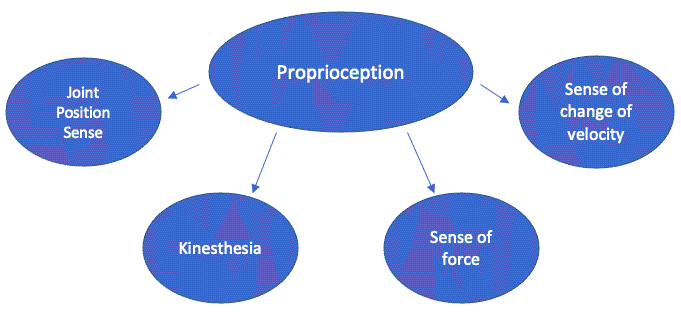
I return to the discussion regarding acting, mentioning another very important point of interest.
As I explained above, the type of acting that the animator stages is radically different from that expressed by the stage actor, but actually also from the cinema actor, although the distance in this case is in other respects a little more reduced.
While the cinema and stage actor performs with his own body, his voice, his expressions, his attitudes, and therefore carries out a substantially direct performative act, the animator creates his performance through the intermediation of a technical tool, and therefore starting basically from within its own cognitive system.
In this sense, it is an essentially proprioceptive act, or, as per definition, relating to stimuli that are produced and perceived within an organism, especially those connected with the position and movement of the body.
In other words, the animator feels within himself the movement he wants to perform, the state of mind he wants to express, and does not “stage” it physically, but “translates” it through the tools and technique of animation, from the pencil to the toolbar of a digital application.
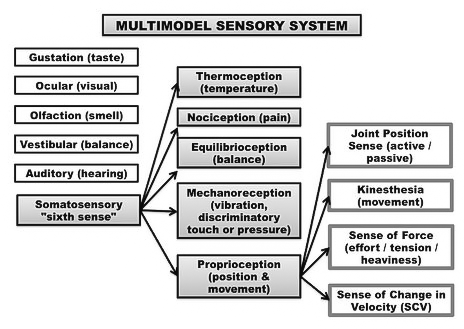
From a strictly medical point of view, proprioception [Fig 17.16] can be defined as the sense of the orientation and relative position of neighbouring parts of the body and the strength of effort being employed in movement.
It is distinguished from exteroception, by which we perceive the outside world, and interoception, by which we perceive pain, hunger, etc., and the movement of internal organs.
The word kinesthesia (kinaesthesia, kinesthetics) is sometimes used interchangeably with proprioception, but, strictly speaking, kinesthesia is the sense of body motion rather than position.
Here, however, we understand it in a sense more strictly linked to the psychology of perception, as the ability of our cognitive system to evoke a certain attitude, a certain pose, a certain behavioral sequence from the internal memory of our senses, and then to reproduce it.
Every animator will have experienced how it is easier to stage actions and movements that we know well than those that are not so familiar to us. For example, I was (in my youth) a decent downhill and slalom skier, and it has always been very easy for me to play a character who skis, whether it was a human, a rabbit, or even a giant egg; while on the contrary unfortunately I am a terrible dancer, to the disappointment of my partner(s), so I have always had great difficulty representing a dancing character, and I have always had to rely on a long and meticulous study of dance sequences in the form required by the scene under processing. And obviously I can’t shoot these references by myself, since I really dance like a drunken bear.
This means that the movement, the action, the expression, must be felt “inside” oneself, even before taking any pencil (or mouse) in one’s hand. If we limit ourselves, to get out of trouble, by rely on references, without understanding (“feeling”) the mental and/or physical movement we are trying to reproduce, we are doing a bit like in those children’s games in which, in order to “draw” a figure, we are asked to “follow the dots” numbered on the sheet [Fig 17.18]: at a certain point a recognizable figure will appear on the page, but obviously we will not have performed any conscious “artistic” act in this, and the figure will remain foreign to us, as if it had been traced by another person. Which is essentially true.
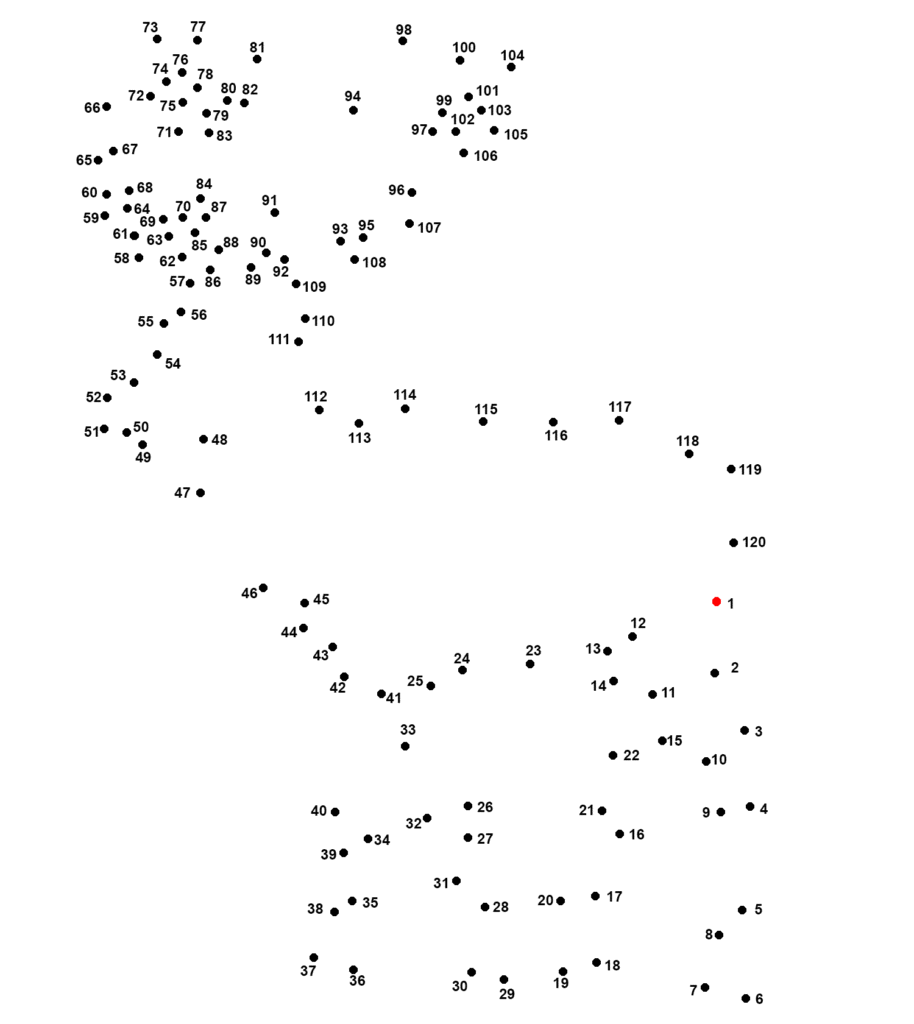
And this also applies, in my opinion even more, to the self-reference footage I mentioned above.
We often see online videos released by animators from big studios, for example Dreamworks or Disney/Pixar, who “act out” some key scenes they animated from mainstream feature film in front of a smartphone or a retail digital camera, and then compare the original “trace” with the final result. Well, if I have to give an heartfelt advice to a young artist it is not to be fooled by this: those are usually expert animators, often very talented, otherwise they wouldn’t be working on those productions, and they know well how to treat their reference footage to create excellent animated sequences, at the level of the project in which they are engaged. And usually, they are quite reticent about how they carry out this essential processing work.
The effect is that an inexperienced observer may believe that this way any of us can make reference movies with our smartphone and come up with brilliant and “perfect” animated scenes. And this is not true at all.
Indeed, the damage, if this message is received uncritically by a young artist in particular (and the animators are, as Milt Kahl said, quoted by Richard Williams, “lazy bastards“) is double: on the one hand is instilled the false information that this is “convenient way” to, quick and easy to achieve brilliant results – which then, usually, DO NOT arrive at all, thus creating frustration and discouragement; on the other hand, the habit of re-trace scenes from references filmed from life, but also from pre-existing animations, “spoils” the artists, and prevents them from developing that sensitivity on movement that I have called “proprioceptive” and which is essential for creating animation of high (but also just medium) quality.
The scene, the character, his emotions, the dialogue, the accents, everything must first be well introjected and felt intimately; just as an actor immerses himself in his character, animation must come from within us, not just from an external source. For this reason, as it would never be superfluous to repeat, before starting any scene, before even picking up the pencil or the mouse, the animator should carefully reread the script (not only the fragment inherent to the scene, but also what happens before and what will happen after), review the storyboard and the director’s notes, for the umpteenth time, and imagine in every detail the scene within himself. And if something still doesn’t work, reread it again, and again (and again). Just like every good actor does in stage rehearsals.
What is true, in any case, is that when an animator who is too accustomed to relying on reference or stock footage finds himself having to tackle a scene or animate a character for which, for whatever reason, there is no way to use this trick, the fragile “house of cards” of a talent not supported by solid bases inevitably collapses. And the industry today does not forgive lapses.
Furthermore, if we take into account that today at least 90% (I think) of the animation produced in the world are not mainstream feature films, but TV or streaming series, an area in which it is often impossible to have the time and possibility to use filmed references, we understand well what damage can result.
To conclude, for now, on this topic, in my opinion the filmed reference should absolutely be the last of the resources to be used to create an animated scene, and in any case it should always be used with great caution, very sparingly, on the basis of a good work experience already acquired, and always followed by accurate and careful work of re-elaboration, correction and adaptation to the animation principles.
I would add that in animation schools or universities this practice should simply be avoided, or, possibly, taught with due caution only at the end of the courses, when sufficient technical knowledge and experience has already been accumulated. I know I’m a bit drastic on this topic, but in a music school, for example, no one thinks of teaching or learning piano via a roller-piano (or a pianola).
Returning to the main topic of this entire chapter, we have seen how the concept of “acting” really has an absolutely central place in the technical and artistic background of every animator.
In summary, the first characteristic that distinguishes a talented animator is his acute sensitivity for the vital and expressive value of movement – or the transformations in time and space – of a more or less articulated object. Even pure movement alone is capable of transforming an inert object into a vital and individually autonomous subject.
The complex of poses and movements that we give to an object transforms it in a character performing an action, wich is his acting, through which we can finally communicate behaviour, thoughts, emotions and feelings to an audience.
And, at the end, the sequence of these thoughts, emotion
Storytelling, the Journey
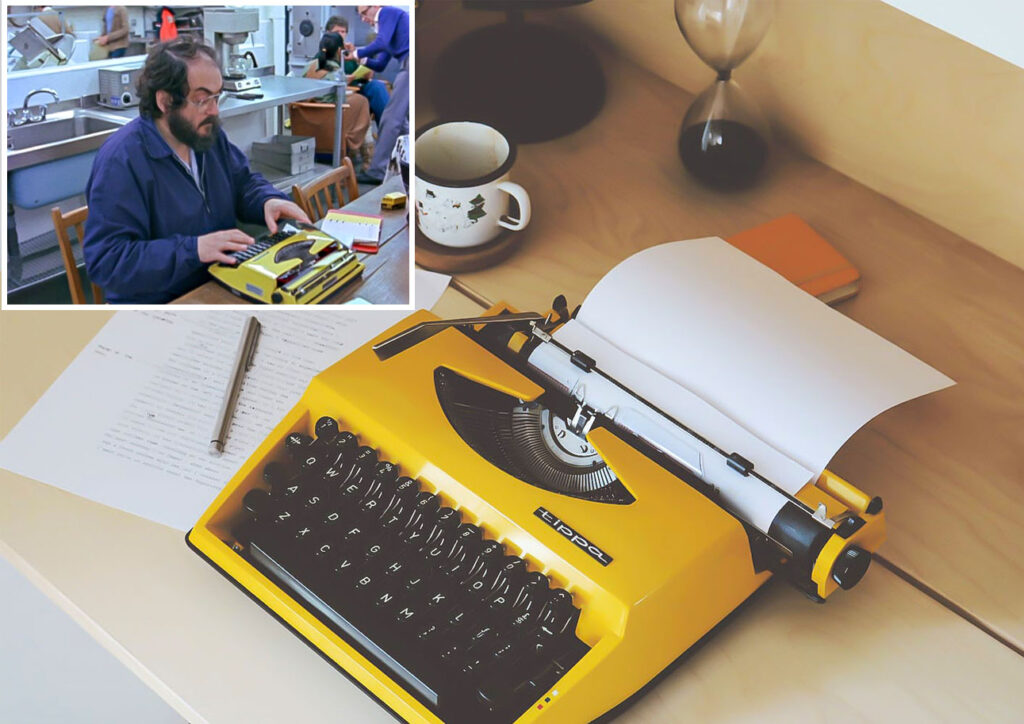
But “storytelling” is not synonymous with “scriptwriting”…
Well, we have therefore finally established what the “raw material” of the animator as an artist is, his clay to model, his paint to spread on the canvas, his sounds to align on the pentagram: it is movement, an impalpable yet very visible “matter”, intimately linked to the primary roots of natural physics, that is, space and time. Outside of the interaction between these two dimensions, movement simply does not exist, it is no more a phenomenon that is part of our experience.
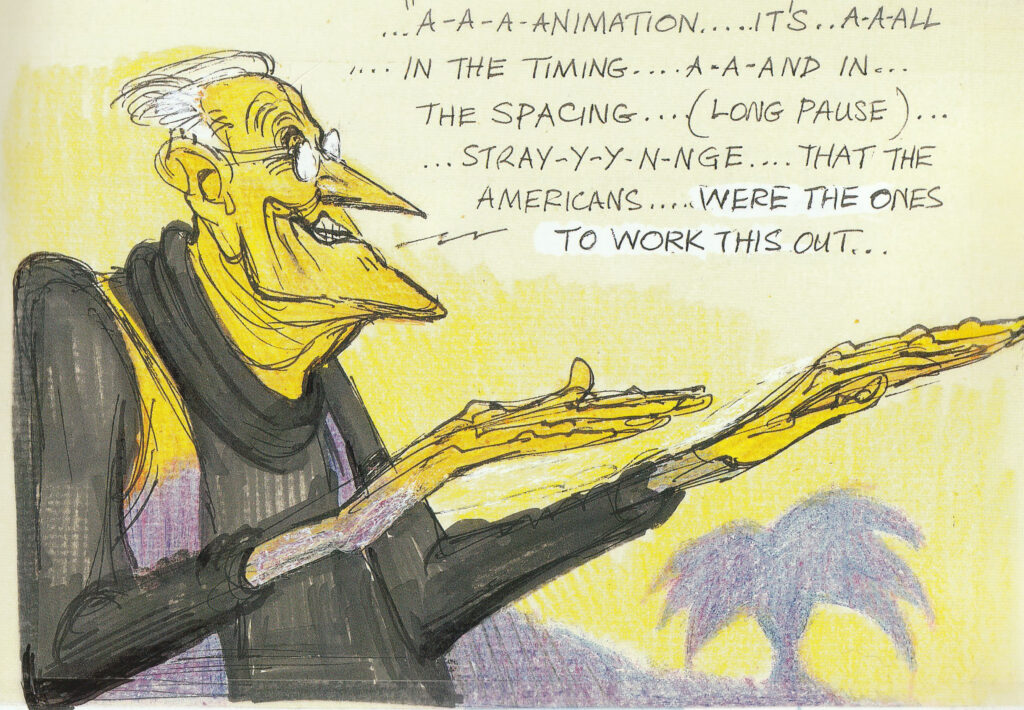
It is no coincidence, as we will have the opportunity to analyze later, “Spacing” and “Timing” are the two pivots around which the entire art of animation revolves. Grim Natwick, quoted by Richard Williams, famously argued that “Animation it’s all in the Timing and in the Spacing” (Adding, again according to Williams: “Strange that the Americans were the ones to work this out”, which instead it is not completely true on my humble opinion, on the contrary it seems to me that it is rather logical that it was the Americans who did it).
In this scenario, the animator is the artist who knows how to shape the forms, times, rhythms of this space-time flow that we call the “movement”, so as to derive meaning and emotions from it. In other words, life.
Again, it is no coincidence that the very name of “animator” or “animation” comes from the Latin root of “animatio”, which literally means “to give life”, “to infuse life”.
But naturally this “magic”, this generative miracle, as happens in all forms of art, has a precise purpose, that is that of telling a story.
That is, something that concerns us in some way, that involves us emotionally, sensorially, sentimentally, in which we can identify and derive some meaning from our existence
We mentioned, a few pages back, the dichotomy between the synchronic and diachronic arts, defining the latter as those which, like cinema and animation (and music, literature, theatre etc.), deal with a transformation, a mutation, of any kind, which develops over the course of a span of time.
While an art that we can define as perfectly synchronic, such as sculpture, stages a narrative entirely internal to the shape and the spatial dimension, devoid of any temporal dimension (apart from the “implicit” one linked to the historical and cultural moment in which it is conceived and created), a diachronic art develops its narrative over a certain actual and measurable time frame.
For example, music, which we can consider the purest of the diachronic arts as it is solely devoid of the visual and spatial dimension, rearranges a series of sounds along the temporal axis to express an emotion, a concept, a virtual dialogue, through harmonic and melodic development, thus implying a “story”, and, metaphorically, even the spacial location in which the same story takes place.
Similarly, with animation as we understand it in these reflections, a series of movements are sequenced, articulated according to the laws of physical, perceptive and psychological coherence to “give life” to objects/characters, in order to convey emotions, thoughts, actions and reactions to the environment, correlations and interactions with other coexisting objects/characters.
In this scenario, the artist’s work never stops at the simple description or reproduction of such movements, treating them as more or less complex but isolated and self-contained physical events: on the contrary, every movement, every action, every “event” refers to the previous and anticipates the subsequent, composing an intelligible narrative arc, or rather, again, to tell a story.
In the video above [Fig 18.01] I return to our previous example, with a character making a simple leap following the primary principles of animation, such as anticipation, squash and stretch, spacing and timing. A “second level” of reading was already present, with the character’s expression appearing to connote the jump as due to a feeling of fear, surprise, discomfort.
However, this “fright”, despite being clearly characterized not only by the facial expression, but also by the entire context of the action being performed, lacks any element that justifies it, that makes it coherent and psychologically plausible and in which the observer can identify. For now it still remains an isolated event, concluded in itself, purely described, but without a past or a future, in other words, without a dramatic development: without a story.
However, if I add, without modifying anything of the character’s action, a new moving element, such as the triggered bomb in the example above [Fig 18.02], the observer’s perception immediately interprets the event as a chain of events that presuppose a previous situation and a subsequent development, a cause and an effect.
So, we finally told a story.
To explain myself better, I return for a moment to our old “billiard balls”, so as to reduce the scenario to the bare minimum. In this example I only changed the size of object [A], making it much larger than object [B]. Our perceptual system, based on innate experience, reads this dimensional difference as a “threat” by [A] towards [B], and consequently infers [B]’s movement away as an escape, attributing the motivation to the fear of the smaller object (perceived as weaker) towards the larger one (perceived as stronger). In this case we have constructed an intelligible micro-narrative cell which reads: “[A] approaches threateningly to [B], who runs away in fear”. By increasing the escape velocity and changing the latency time we can change the escape into something even stronger, like “terror”. If instead we slow it down, we will read the action as a simple moving away (to see better?) [Fig 18.04]
The interesting thing is that, when we are inside the narrative, we can also change, or even contradict the expectations set up by our perceptive system, which we have defined as “instinctive”.
For example, we can make the biggest ball to “run away” [Fig 18.05], thereby creating a “surprise” and therefore a possible comic effect [Fig 18.06], according to the classic Freudian definitions of “joke”. (“Jokes and Their Relation to the Unconscious” – Der Witz und seine Beziehung zum Unbewußten, Sigmund Freud,1905).
At this point it should be underlined that when speaking of “storytelling” here I do not mean talking about plot, dramatic development, or rather anything that is the responsibility of writers, scriptwriters and storyboard artists. Storytelling here is understood only as the primary cell of narration, expressed by every movement or action of the character (of the actor), which must contribute to the progress of the general plot of the story, without redundancy, without omitting, without deviating from the main path. Only in this way will the gesture, the action, the emotion of the character (actor) be effective, and felt as essential, indispensable, and inevitable.
In other words, in our work every single movement, every action, every change of expression is never an end in itself, but must contribute in an essential way to the progression of the story that is intended – that the play in its entirety intends – to narrate.
In the previous example, the fact that a bomb enters the field presupposes a narrative situation that justifies it (Who threw it? Why they did it? What is the link between this action and the presence of the character on the scene? What led him to being in that very place? What is the relationship between him and the character who threw the bomb?). In the same way, the event must find a justification consistent with what will happen (that we want, or that our director wants to happen) during the subsequent narration (The character dies? Or disappears? Or stays burned on the scene? The character who threw the bomb laughs? Or is disappointed for not having somehow obtained the result he expected? Or is upset because he didn’t expect the bomb to actually explode? etc.).
As we have seen, the fragmented nature of the animation work, entirely concentrated in the analysis of the action of a single character within a single scene assigned in the order and times established by the work plan, can very easily lead to lose sight of the main road and introduce elements of redundancy, disturbance, even contradiction, which can distract or even distort the understanding of the main story.
For example, if our character at the end of his jump, instead of having a scared expression simply smiled, the meaning of the whole action would change radically, and together with it, inevitably, also the meaning of the story [Fig 18.07].
Naturally this is an extreme example, but it demonstrates how nothing that moves within a scene can be considered neutral, isolated in itself. We are in a diachronic art, as we have said, and therefore everything is inevitably inserted in a sequence, in a space-time chain, in which every single link can determine the solidity or instead the fragility of the narrative line. If one of these links breaks, the entire construction loses its bond and risks being lost in nonsense [Fig 18.08] .
This leads us to define another fundamental concept, namely the essentiality of the movement, of the gesture, of the action performed on stage, in the sense of its irreplaceability or necessity and in that of its conciseness, simplicity, effectiveness.
In theatrical and cinematographic acting, “overacting” is defined as the acting of an actor who adds superfluous elements to the action, for example waving his hands too much, exaggerating movements and expressions, indulging in useless gestural or vocal virtuosity. Similarly, “overanimation” is defined as the action of a character in which the secondary actions are too abundant, unjustified, detached from the context of the main action, perhaps inserted only to show the technical skills of the animator. An error that is unfortunately much more common than one might imagine, so much so that we can see traces of it even in high quality films, particularly in 3D CGI animation, where it is relatively easy to exaggerate, since much of the dirty work is done by the machine .
Just as a witness in a trial is asked to tell “the truth, the whole truth, nothing but the truth”, the animator of a scene is asked to tell “the story, the whole story, nothing but the story”.
Returning to the daily work of an animator, in particular if employed in a medium or big studio, as I mentioned above his work is similar to that of an actor engaged in a dramatic role, but his acting technique differs from that of the stage actor and instead comes very close to that of the cinema.
Often in non-specialised literature, and therefore in the eyes of the common public, animation is treated just as one cinematographic genre among many (drama, western, horror, romcom, musical, historical, comedy, noir, etc.), but this is a completely superficial and ahistorical definition, because animation should rather be considered as a sort of “parallel cinema”, in which the various genres are included, as a reflection or parody of those of live action movies. Essentially what differentiates it from the latter is the generative technique, which operates discrete on the single frame rather than on the reproduction of a continuous staged action.
In any case, what matters in this discussion is that animation is to all intents and purposes cinema, and it fully shares its language. But that’s not all.
Precisely due to the nature of its technical execution it can push certain characteristics to the extreme: the animator not only works in a fragmented way on the single scene as determined by the production plan, but unlike the actor who is physically present on the stage or the set together with other actors, technicians, directors etc., he works more or less isolated on his desk, or on his computer, and does so by exercising in the meantime extreme analytical attention on the movement of the character he is animating, in order to obtain the desired action, and this, in fact, down to the single frame.
The animator’s work is first and foremost a work of analysis, he breaks down the movement, he dissect it, like on an autopsy table, down to the smallest detail, This is precisely inherent in the basic method, divided into extremes, keys, breakdowns and inbetweens. For this reason it is much easier to lose sight of the “synthesis”, the sense of what we are doing within a story, and it is easier to indulge in redundancy, distracting actions, and showing one’s virtuosic whims .
The animation must instead be like the clear and clean bed of a stream carrying the water to push the blades of the mill, without dispersing into secondary branches, vortices and eddies, shallows and swamps.
To give an example taken from the “masters”, we can compare the almost perfect animation created by Milt Kahl in the famed sequence of Shere Khan meeting Kaa in “The Jungle Book”, with that of the raven Jeremy (voiced by Dom DeLuise) in Don Bluth’s “Brisby and the Secret of NIMH”.
In the first example [Fig 18.09] every single movement is calibrated to the millimeter, the composition is perfect, there is not even a single movement that can distract attention from the main action, and when there is, for example the nervous albeit restrained movement of Shere Kahn’s tail, is always completely functional to the narrative. Milt Kahl even chooses to entrust the entire lower part of SK’s body to a held cel, which is rather unusual in Disney full animation, but it is a conscious choice, due not so much to the need to saving time and work, as well as not disturbing the perception of the scene in any way.
In the second example [Fig 18.10], however, the crow is rather overanimated: too many primary, secondary and even tertiary movements end up distracting from the main action, in the same way that a magician’s hands distract the audience’s attention from the trick he is performing. Don Bluth’s film obviously remains a jewel in the history of animated cinema, a small masterpiece without which the entire subsequent “rebirth” of Hollywood (and off Hollywood) animation could not be explained, after the painful industrial, creative and technical crisis of the 1980s. However, evidently, in their desire to give their best, the formidable crew of animators involved in the project (certainly not favored by serene working conditions, always racing against very tight deadlines and uncertain budgets) tended to overdo it, also out of pure enthusiasm.
In summary, the art of the animator, like that of the actor, with which it has so much in common, but also like every other artistic expression, is fundamentally the art of the essential, of the maximum effect with the minimum effort.
While in life, in reality, redundancy is often a rule – there are so many stimuli and signals that we must untangle to give meaning and coherence to this reality – in the field of artistic expression, and in the related field of representation, everything that is acted or said is functional to the underlying theme of the narrative, it is the center of gravity on which everything depends and on which everything must fall.
To obtain this synthesis, this essentiality, it is obviously necessary to work a lot on the technical tools that you have available, with continuous and tireless study, exercise and refinement of your skills. But once you are in the game, with the scene on the desk, and the delivery times pre-established, there is no point in panicking or rushing, in fact it is decidedly counterproductive. It is a very common mistake, even among the most experts, including myself, to rush into animating the newly opened scene, relying on the layout and – when there are – on the posing and the director’s notes; but this irresistible temptation must be resisted.
Instead, first of all it is necessary to stop and reflect for a while, reread the script at least in the closest parts of the scene that is being animated, review the videoboard, if available review the animation of the previous scenes, rethink the character and try to think with his head, dressing not only with his appearance, but with his emotions, his thoughts, his motivations. This is an essential process that should not only be carried out at the beginning of a new sequence or episode, or during a meeting with the director, but always, every time you start working on a scene.
Finally, our character, which we embody as actors, enters the narrative, the story, and begins his journey, his true adventure.
In the last article of this chapter we will touch on one last topic, just as fundamental as the previous ones, but extremely volatile, difficult to define, even if it constitutes the true first spark that distinguishes an authentic artist from any other person, and at the same time it is the “added value” that each of us can exploit throughout our career: the individual talent.
Talent: Skill or Genius? (Part I)
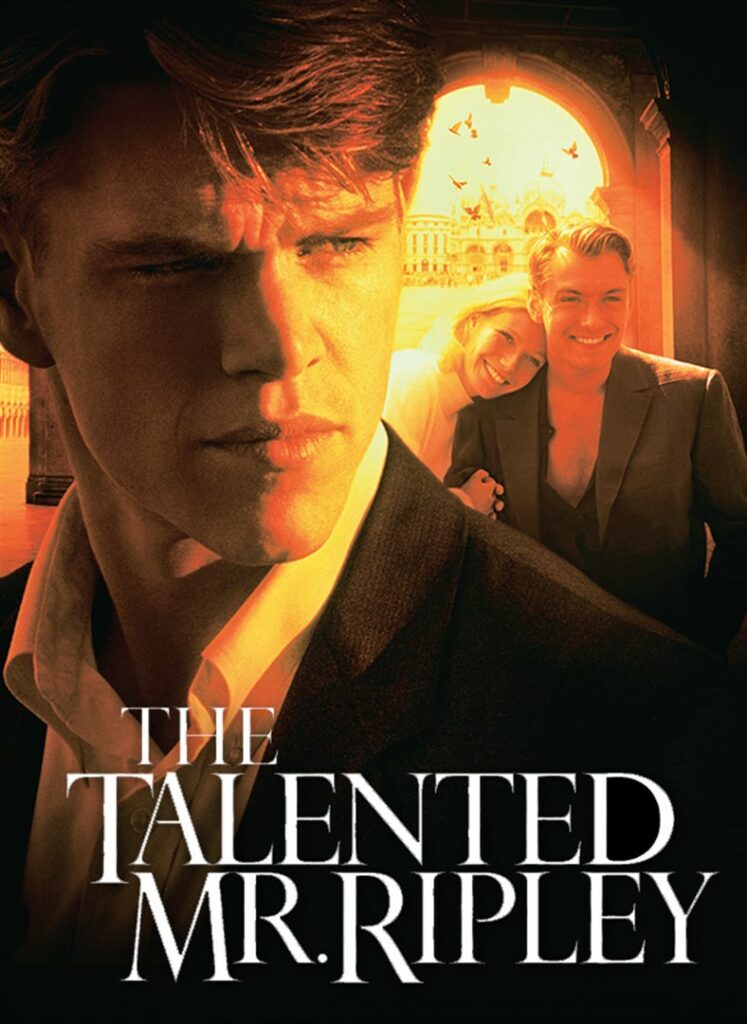
To conclude this quick overview of mine around the technical – and above all theoretical – foundations underlying the animator’s profession, and, together with it, this first section of articles of a general nature, I would like to focus on one of the most essential ingredients, but at the same time time also often misunderstood, or even misrepresented, among those that make up the basic equipment of every artist in animation (and not just animation) or aspiring one.
I am naturally referring to talent, as anticipated in the title, of which I would like to try to redefine the fundamental aspect it has for every person who finds themselves in some way engaged in a creative or artistic activity (or job).
This is therefore not a topic that specifically and exclusively concerns the animation world (including not only animators, but also all the people in some way and in any position involved in the creation and artistic production in this sector), but which it extends to every creative, amateur, professional or industrial field, from music, to art, to design, to advertising, to publishing.
However, due to the distinctly industrial characteristics of movie production, and animation in particular, it is a very delicate and crucial topic, which is often oxymorically both overvalued and underestimated.
I would like to dedicate these reflections in particular to younger artists, who are just now starting to deal with the professional and industrial harsh reality, hoping to help them to better evaluate their own abilities and potential, dispelling some rituals and myths that have become consolidated over time in our little world, in particular – if you’ll excuse the metaphor – at its entrance doors, which are increasingly crowded, heavy, rusty and difficult to open.
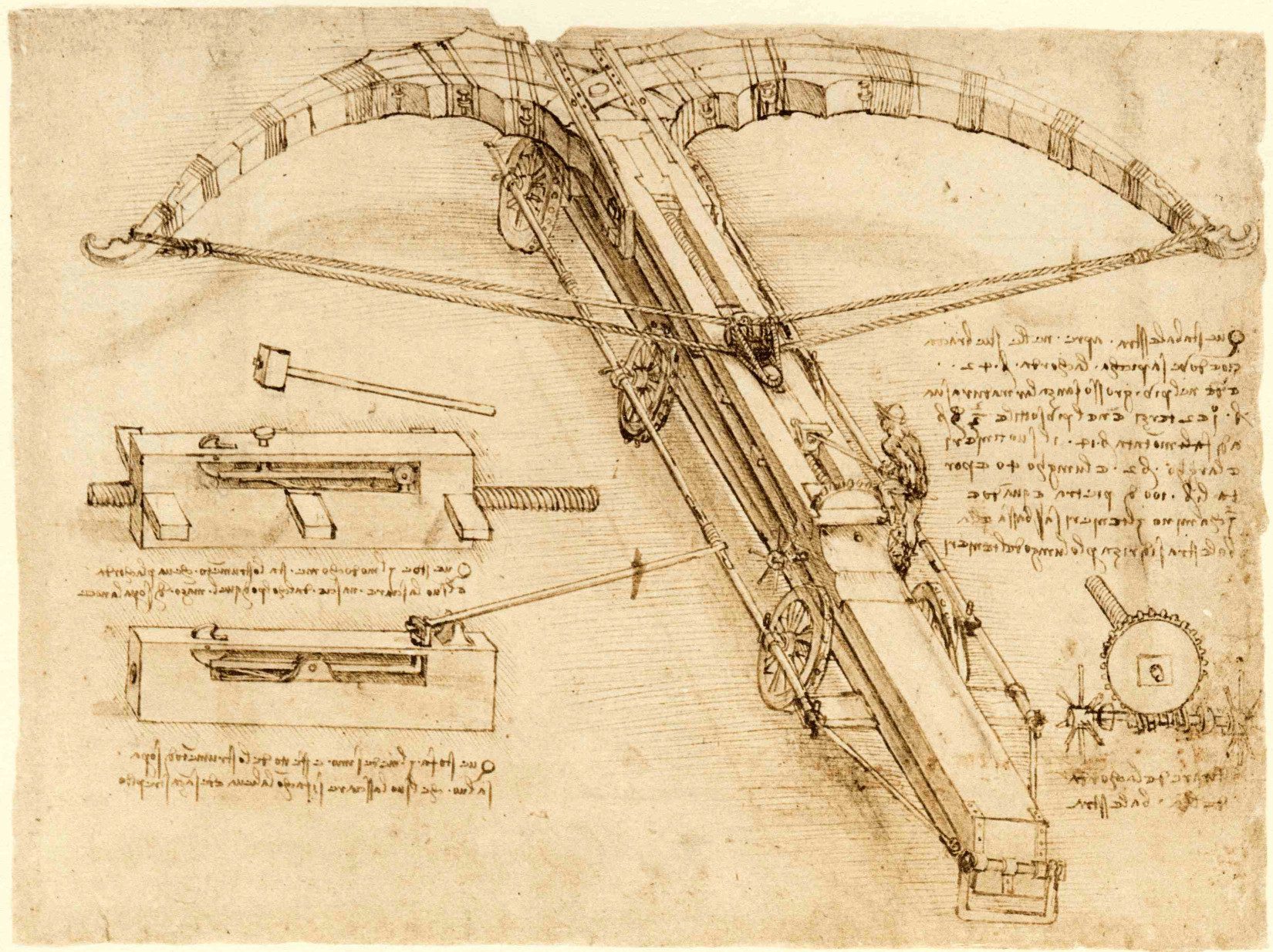
In fact, in what I have called our “small magical world”, the term “talent” is much cited, emphasized, and often used inappropriately. We often read recruitment announcements like this: “we are looking for new talents for our Studio, for the in-site positions as xxx and yyy” or self-congratulatory statements from other large and small companies such as: “Our firm thanks all the wonderful irreplaceable talents who have allowed us to carry out our fantastic project xyxyxy” (perhaps not mentioning that many of these “irreplaceable talents” have already been fired pending a not very probable re-hiring for a hypothetical future production).
Much more often than one might think, this term – talent – is used as a euphemistic synonym of “skill“, rather than in its literal meaning of “particular intelligence, predisposition, ability and relevant intellectual gifts, especially as natural and intended for particular creative activities“
This is a only apparently minor verbal cheat, as those same companies that spend much of their words extolling the talent of their artistic crews, often do not disdain to treat those same people like any other workforce, always blackmailable and replaceable even if to just keep costs low and obtain higher profits.
It’s a terminological issue, therefore, but not one to be underestimated, due to the devastating impact that certain apparently harmless words have on the personal experiences of artists and employees.
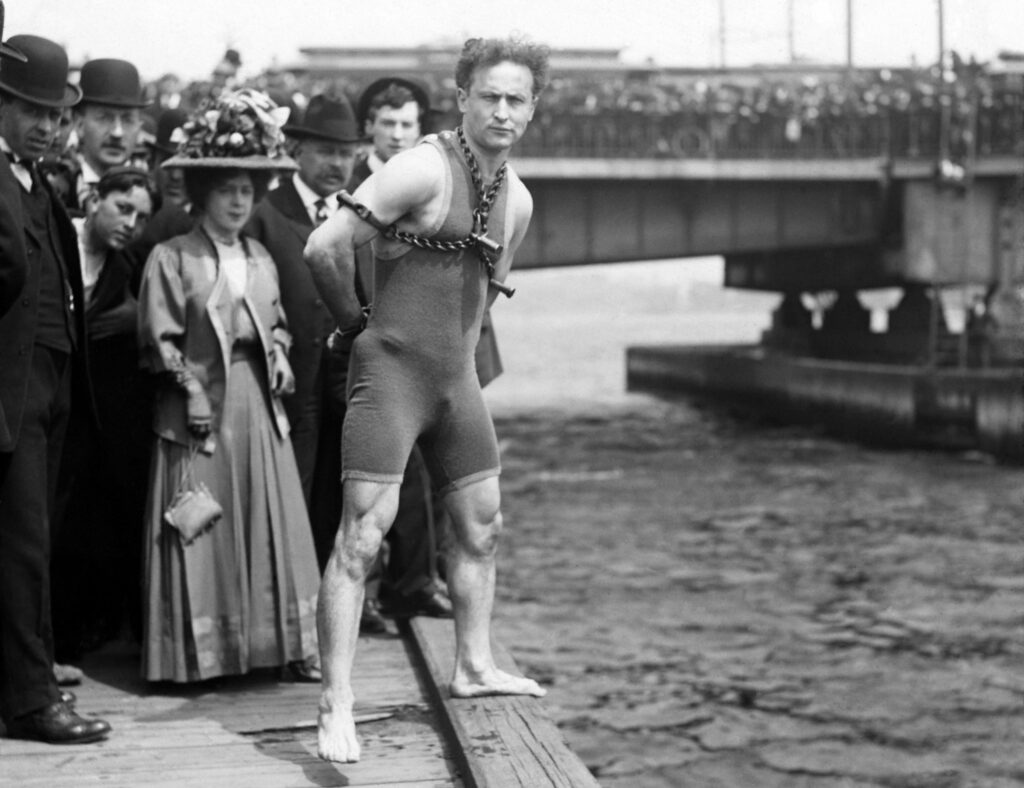
Therefore, we cannot fail to underline what should be absolutely obvious, namely that “talent” and “skill” are not synonymous at all, and are not interchangeable depending on the opportunity or context.
“Skill” represents the technical and executive toolbox that every person who works in a certain field must equip themselves with in order to be able to operate at their best in that field, and to be able to face, resolve and complete the tasks that come entrusted to them, or that he himself intends to achieve. In short, it is a gift that is not exclusive to the artists, but to anyone involved in a production or work process: an electrician will be considered more or less competent and qualified in his field to the extent that he is able to efficiently and correctly assemble/disassemble a junction panel, or to solder contacts, or put his hands in a live circuit without risking being electrocuted.
In the same way a musician must demonstrate that he knows how to play his instrument (or instruments) to perfection, and in the same way a chraracter animator must be able to move (and bring to life) the characters entrusted to him in a convincing, solid and flawless way.
Within these skills and abilities, there is always room for a wide range of greater or lesser levels, so the electrician mentioned above will be considered excellent, good or mediocre in his field based on his ability, speed and safety in repairing a faulty system; and the musician as well based on the technical quality of his performance and the ability to brilliantly overcome the most hidden difficulties and pitfalls of the score.
Likewise, the animator will be considered more or less “good” based on his ability to bring his character to life while respecting the director’s requests and, today more than ever, strictly respecting production times.
“Skills” are mainly abilities and attributes that can (and must) be learned, exercised and refined over time, and are in general tools available to anyone who wants to learn and apply them. They are also eminently dynamic qualifications, always destined to evolve over time not only in quality but also to adapt to the ever-changing professional scenarios: those who have started working as 2D animators may at some point have to work in the 3D field. If started with TV Paint, you may suddenly have to adapt your knowledge to work on Harmony or Maya.
In current language in today’s world of work, in any case, these are the minimum requirements necessary to aspire to access any “career”, at any level, where there is no longer any sliver of time or investment to dedicate to an internal training, and whoever is hired must immediately demonstrate that they have skills that are almost always superior to those actually required for the job offered.
This is a devastating vicious circle for the new generations who in this way really seem to have no chance of entering the world of production, unless they have family ties or support that allow them to “jump the queue”. I can’t imagine anything more negative and unfair than this state of affairs, but I’ll stop here, because this is not the place to explore this topic which involves the general organization of our society.
I will limit myself to focusing on the evident paradox of the requirements that are demanded by some companies, even in our sector, such as we find in certain hiring notices that seem to require absolute excellence, worthy of a Nobel Prize, when in reality the job offered is often of low-level and ridiculously poorly paid.
In this regard, I would like to suggest – particularly to young artists – not to be intimidated by these bombastic announcements, and to look at the objective concreteness of the job offer. The “required requirements” of certain H.R. managers can almost never be met by anyone, if not by a very unlikely random coincidence, even in a period of shortage of demand like the current one, and companies must “make do” with what they can find on the real market, and not in their dreams. It is always good to remember that in any case if it is true that the artist “needs” the producer to work and survive, it is also true that the producer “needs” the artists to realize his projects, and it is not necessarily true that this “need” is less urgent than the other, on the contrary. As a producer, and as a director, I well remember my anxiety every time I had to find qualified artists available to work for the project that was under my responsibility.

The producer, in my opinion, almost always needs the artist more than the latter needs the producer, because, believe me, an artist could one day be a producer, while a producer can never be an artist, and it is it is on this basis that the relationship should be set up, even by a young person with still limited demonstrable experience in his CV. Not only because experience can only be accumulated with experience, and therefore it is a path that must be completed in any case, but also because in this climb, very hard and demanding especially at the beginning, it is necessary to know how to select very carefully the steps and the handholds on which one relies to advance. It is necessary, especially at the beginning, to allow oneself the “luxury” of choosing, avoiding projects that are very low profile, of little interest, or poorly conceived, or unclear, which would end up slowing down rather than encouraging the climb – i.e. the career.
And above all, never, never ever give in to the calls of “free collaboration” behind the promise of “making a better CV” or “having visibility”. Companies of a good level never risk their reputation with these dubious and legally borderline methods, so they are almost always, if not always, tricks that some unscrupulous producers adopt to carry out their projects with little economic risk: it is necessary to be strongly wary on these swindlers, and in any case it is more productive to invest your time to enrich your portfolio with personal projects and proposals that can truly demonstrate your abilities, rather than getting involved – without compensation – in some often low-grade job that will never belong to you anyway, and which, at best, is destined to boost someone else’s career.
Having said this, however, the point that I find most relevant to point out here is how all these dynamics, which belong to what we could define as the sphere of ability, competence, skill, are often too lightly attributed, in good and sometimes in bad faith, as we have seen, to the context of talent: this term instead means something very different.
Rather, it is a strictly individual and personal gift, unique and irreproducible, like a digital fingerprint, with which we are (more or less, or not at all) naturally, innately gifted. And over which we therefore have minimal, if not zero, possibilities of control and improvement.
It is therefore not simply a series of technical tools learned or skills acquired, but one’s own particular propensity or elective affinity towards a particular activity or form of expression.
Typically it is something that cannot be taught or learned, but is rather something that guides us, or even irresistibly pushes or attracts us towards a particular pole of interest, and which represents in our life choices a powerful stimulus and reinforcement to start certain paths and achieve certain goals.
To give an example in the musical sphere, a person normally endowed with a good sensitivity, or perhaps encouraged by a favorable cultural and social environment, will be able to brillantly complete regular studies and training at the conservatory and become a recognized and appreciated musician or instrumentalist, and even achieve results of absolute excellence. Just as, starting from a different personal story, he could have become a successful writer, or a lawyer, or an engineer, or a doctor… Or an electrician.
A person with a natural talent for music, on the other hand (and I chose music because in this area the function of talent has always had a particularly strong and unequivocal impact) feels literally devoted right from the beginning to this expressive area, to which he feels infallibly and ineluctably that he belongs. He could have done nothing else in life, and he is ready to face any sacrifice, adversity, social or material difficulty in order to have access to it.
At the same time, talent works as a sort of catalyst, making it relatively “easy” for him to achieve goals that normally require much greater investments of time and energy for any other person. As a result, his chances of achieving excellence are objectively much higher than average.
Unlike abilities or skills, talent is an attribute that belongs almost exclusively to the exercise of the arts and creative activities, whatever they may be.
It is true that in common language the ability of other professional figures who prove to be particularly gifted in their field is often defined as “talent”. For example, a lawyer who manages to win all or almost all of his cases can be defined as “talented”, just like a surgeon who manages to excel on the surgical table. However, no matter how high the skills in the field and how prestigious the position is, in these cases we always remain within the scope of personal “ability” in carrying out specific and highly specialized tasks. And in fact the category of art in these cases is used only in the sense of metaphor: an open heart operation can be defined as a “work of art” due to its perfection and elegance of execution, but it remains confined in the field of science, physics and of biology: the field of “spirit” is closed to it, I would say almost by definition.
Here the discussion would become very intricate, entering into philosophical, aesthetic and epistemological issues that go beyond this brief analysis of mine; and on the other hand I don’t think I have the appropriate scientific tools and expertise to delve deeper into this matter.
I would say, greatly simplifying, that no one is “born” a lawyer, or a surgeon, while some of us possess a special gift (which can sometimes seem like a curse, but that’s another story) that has led them to “born” a musician, or a writer, or an actor… Or an animator.
How this is possible and how it actually happens remains largely an unknown issue, in the sense that rationality alone is not entirely sufficient to “explain” the phenomenon. But it is so, and this is confirmed by the fact, for example, that in some – certainly very rare – moments in history someone is “born” into this world to be Mozart, or Paul McCarthy, or Raphael, or Picasso, or Dante, or Joyce.
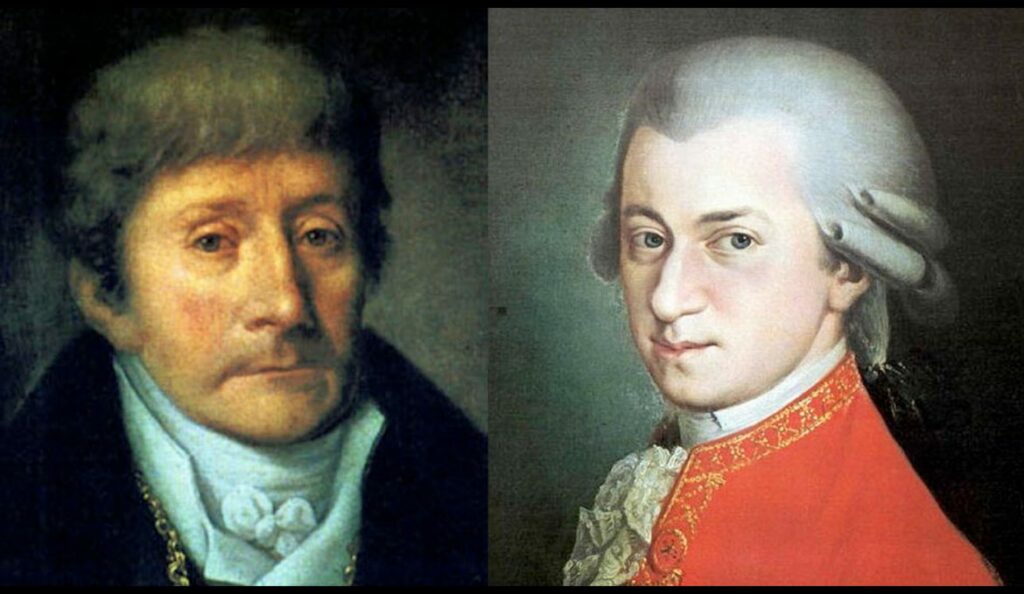
But here we are within the scope of what we can define in all respects as “genius”, which in reality we can define as the maximum and extreme expression of talent, thereby at the same time guaranteeing a measurable dimension to the phenomenon. In the sense that talent, as it can exist in this extreme form, exists in a whole range of gradations, from the highest to the lowest. While maintaining, please note, the same character – and name – of “talent”.
Talent: Skill or Genius? (Part II)
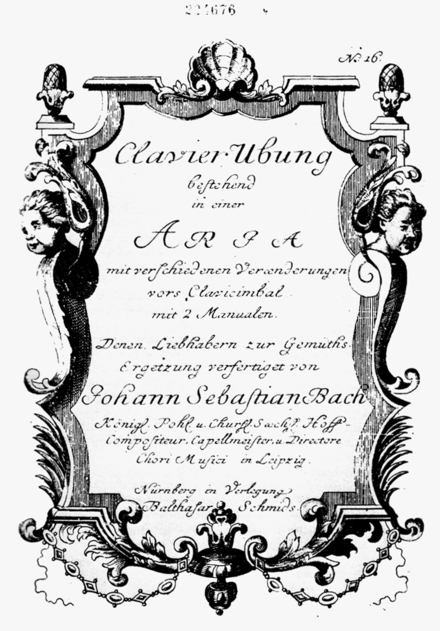
As I had the opportunity to write above, talent – and consequently its maximum and rarest manifestation, genius – belong almost exclusively to the arts and, more generally, to creative activities.
I would like to clarify this point better, so as not to give rise to misunderstandings: it is naturally in the lexicon and in common acceptance to define particular talents (and genius) even outside the sphere of the arts in the strict sense: we have great talents (and geniuses) in Science, Medicine, in Physics, Mathematics, Philosophy, practically in every sector of human knowledge. But this is not in contradiction to what has been said so far, because this definition refers to the eminently creative component of all these activities, not to their technical and executive dimension.
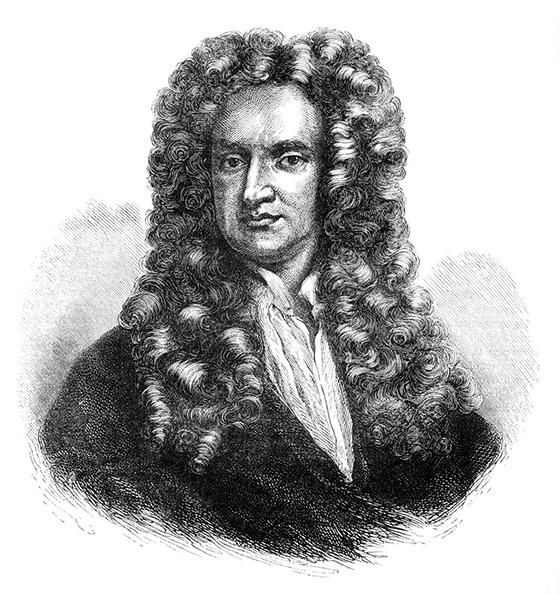
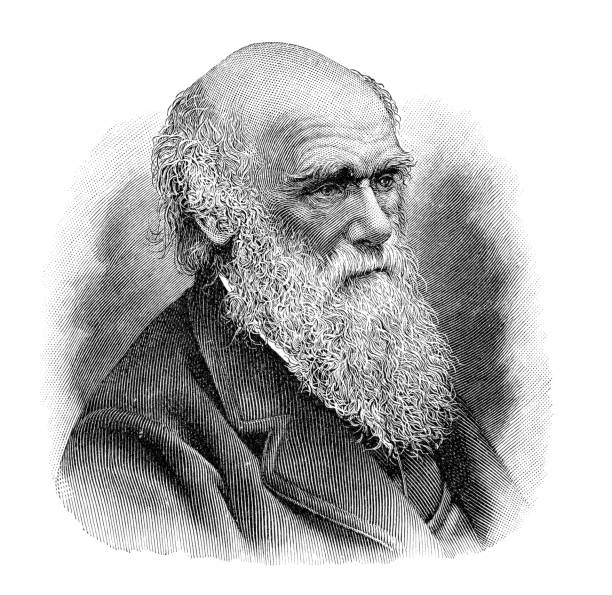
Sir Isaac Newton is considered a “genius” not for his (exceptional) ability to express concepts in mathematical form, but for the innovative, revolutionary – and therefore creative – vision in which he was able to combine these concepts to the point of radically reinvent modern physics. The same goes for Charles Darwin, who we do not consider a genius for his extraordinary ability to analyze the biological and environmental data that he collected over the years of sailing on the Beagle, but rather for the creativity with which he was able to use these data to support a theory that revolutionized not only the world of science, but the very vision of the world accepted up to that time.
In this sense the arts can be considered simply as privileged manifestations of this same creativity, and we deal with them here more directly only because the focus of these conversations is centered on this particular perspective, animation as an art form.
Therefore, due to this very close, tangled, intimate bond between “talent” and artistic expression in general, it has truly always been the worry, the burden, the blessing-and-curse that every artist, from the most humble to the most recognized, from the most modest to the greatest, he finds himself having to carry it on his shoulders for his entire life, due to the very fact of practicing an artistic profession.
It is no coincidence that I spoke of “burden”, because the field must immediately be cleared away from an often poorly posed question: even the most gifted, even those who are among the few “chosen” in the Olympus of excellence, and even among those who we define “geniuses”, the artist will always feel the burden of this gift weighing on him, first of all because he perceives it for what it is, that is, innate, and therefore only very partially controllable and manageable by his rational conscience, and then, because he knows very well that there are NO limits to excellence, and that it takes constant, tireless effort to live up to one’s talent: talent, authentic talent, is a voracious and insatiable beast. And the more so the more vigorous the talent itself is.
This applies in the same way and intensity to every artist, from the mediocre, to the most gifted, up to the Empyrean of Maximum Excellence. Because, keep this in mind, it is an entirely internal struggle. It should not be confused with the competition and the comparison of our abilities, of our goals, with those of others: it is instead a question of the conflict between our real abilities and the goals and objectives that our talent sets us. Which, if authentic, are always a step or two, or even more, ahead of our current capabilities.
This, if we look closely, although we may perceive it as a burden, is actually the real fuel that powers the engine of our creativity to develop, to overcome itself, to perfect itself, to achieve ever greater results. The moment this flame was missing, or when we felt “satisfied” with what we are and are able to achieve, the “propulsive drive” would be extinguished, and with it our creativity.
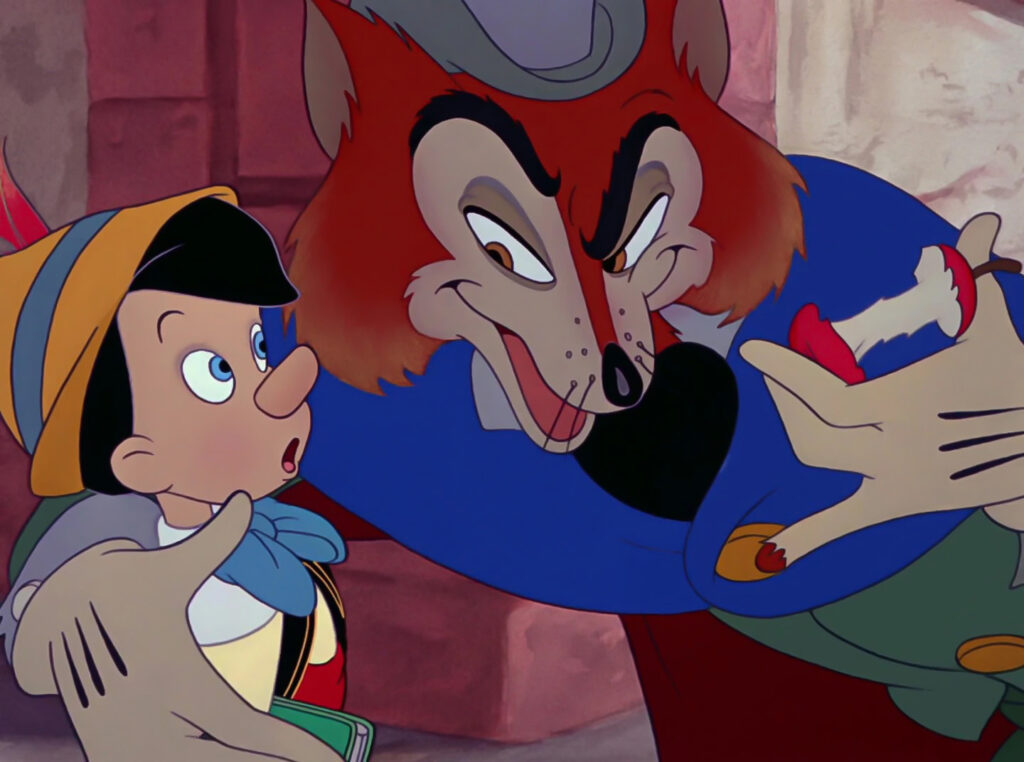
However, the confusion between ambition, skill and talent can be an insidious trap, for all of us, but in particular for the younger artists: the moment we feel “inadequate” compared to others who we recognise as more brilliant than us, or, worse, on the contrary, when we felt too fulfilled and satisfied with our work, or too high to compete, we would risk losing this driving force, which is essential for growing and stabilising our position on the market. Or, in the case of more fragile, inexperienced and insecure personalities, regardless of their talent or objective abilities, they risk becoming discouraged, to the point of prejudicially giving up on possible results that would have been fully within their reach. In my career I have seen more than one artist, even a promising and valuable one, give up the battle due to this sense of inadequacy, often in the face of exaggerated requests, or due to little faith in themselves and in their own value, and give up preventively, sometimes even definitively, to any comparison, and to a possible career.
In this regard I would like to recall a book, a purely narrative and fictional novel, which however is truly very emblematic for revealing how harmful and even destructive these dynamics can be, and how much they can affect the very life of who do not know how to recognise their real extent within the psychological and mental balance.
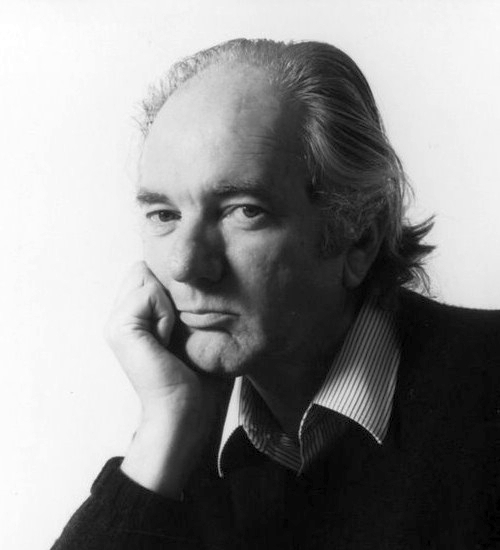
This is the short novel by the Austrian writer Thomas Bernhardt (1931-1989) entitled “The Loser” (Der Untergeher – 1983).
The book tells of the imaginary (but not too much) meeting between three artists in their youth and training phase. Two of them, the narrator – never called by his name – and his friend Wertheimer, are fictional. The third, however, is a real historical figure, the legendary virtuoso pianist and Canadian musician Glenn Gould(1932-1982).
The story begins when the narrator and his friend, both young pianists already trained and gifted with an extraordinary talent, decide to participate (at the Mozarteum in Salzburg, a very emblematic place in itself) in a masterclass held by one of the greatest and most esteemed pianists of the time, who also really existed, the Russian naturalised American Vladimir Horowitz (1903-1989).
The course (plausible but imaginary) takes place in the year 1953, the date in which Horowitz is in his 50s, while Gould is 21, as we can imagine the two “fictitious” co-protagonists are.
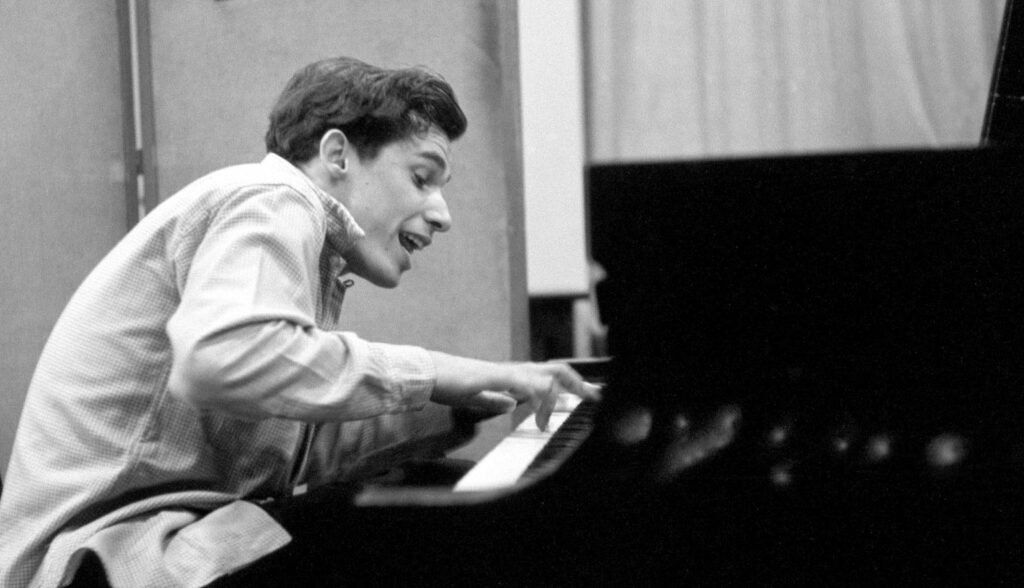
The character of the “narrator”, as I was saying, is a pianist who has already reached a level that we could define as excellence (otherwise he certainly would not have access to such a prestigious seminar) and who turns out to have come to reasonably aspire to a successful musical career; all this coming from a rather wealthy family, and driven first and foremost by personal ambition and the urgency of freeing himself from a grayly bourgeois environment. In his musical practice, technical ability and virtuosity (the “skill”, as we have said) have more space than actual talent.
His friend and colleague Wertheimer (a name that is also somewhat evocative: by pure coincidence, the same surname as one of the fathers of the Gestalt psychological theory, of which “our” Michotte was one of the important exponents) however, demonstrates a genuine talent and appears to have already started a concert practice of a certain level, although he too seems more focused on technical excellence and public recognition in itself rather than on a true and exclusive relationship with music as an art form.
Having arrived in Salzburg (which the narrator says he “hates”) the two pianists find themselves witnessing, by chance, the performance by the young Glenn Gould of one of the most profound, complex and mysterious scores in the entire history of music, the very famous (also thanks to Gould himself) Goldberg-Variationen (BWV 988 – 1741) by Johann Sebastian Bach.
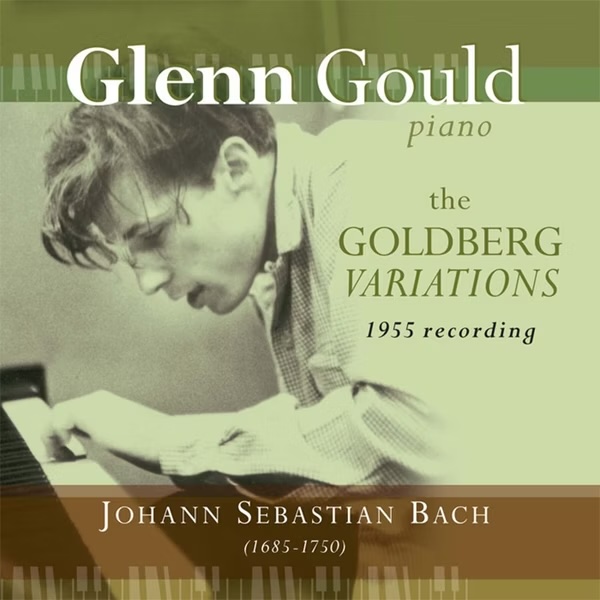
Both artists are sensitive and prepared enough to receive such a violent and devastating impression that they suddenly and forever see the course of their lives change, and not just their artistic and musical life.
Both cannot help but recognize that they are faced not with a simple execution, but with a truly exceptional event, one of those very rare cases in which someone, as a “mortal” human being, has the adventure of witnessing the primary explosion of an authentic genius, and, what is even rarer, being in possession of the tools to fully recognize the greatness and exceptional nature of the event itself.
The two react differently from each other, but both are so overwhelmed by the expression of that genius that they have to admit that they cannot even remotely sustain the comparison, and both abruptly end their careers and abandon the field of musical performance.
In the historical story of Salieri, which I had mentioned in the previous conversation, it is very unlikely that the worthy musician, already in full career and esteemed internationally, was truly able to fully evaluate Mozart’s genius, so much so as to engineer his death, as legend claims (and Milos Foreman’s movie “Amadeus”). However in this case the two young pianists had both fully understood the dimension of the phenomenon they were facing.
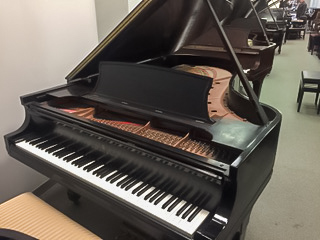
The first of the two, the narrator, simply decides to sell (or rather, practically to sell off) his precious and beloved Steinway piano and to dedicate himself to an unspecified activity in the philosophical field, while maintaining contact with his “past life” through the painful and ultimately unsuccessful attempt to write a historical-critical essay on the figure of his model and demon, Glenn Gould. Who by the way will die prematurely from a stroke as soon as he reaches the age of 50.
Even Wertheimer, for his part abandons musical activity, but, having music much more deeply rooted in the depths of his soul, and possessing his own marked talent, he does so with much more suffering and effort, and ends up dedicating himself without passion to some “humanistic” studies, also not better specified. In reality, he will never be able to overcome the trauma of that fateful encounter, which will corrode his spirit mental balance until, almost 30 years later, he takes his own life.
But it won’t be his own sense of inadequacy that will make him finally decide to come to terms with his own existence, but rather the devastating event of the premature, for him aesthetically and logically inexplicable, death of his mentor (it was Gould who nicknamed him “the loser”), demon and mirror.
I wanted to tell this story in summary, for those who don’t already know it, because I consider it very significant for better understanding these psychological dynamics to which all of us, due to the very nature of our work, are exposed.
For the particular benefit of younger artists, who are just starting to face this rigid and severe market, I would therefore summarize what has been said so far in some fundamental points, taking into account what concerns us more directly as (chraracter) animators:
A – Skill and Talent, as we have said and repeated, are not synonymous. Even if it is common to play on the ambiguity of these two terms, what companies and their HR are looking for with their recruitment announcements is not and could never be actual talent (and much less genius, of course) but much more simply skills and knowledge that can be recognized and evaluated, hopefully objectively. So don’t be discouraged when you read stellar recruitment notices that seem to require artists capable of painting the Sistine Chapel, those are childish ambitions without the possibility of being reflected in reality. All they ask for are the necessary and sufficient qualifications and skills to perform a precise and limited task. All you need to equip yourself with are the technical tools and skills to best perform these tasks. Whether you are endowed with talent in greater or lesser quantities is entirely up to you, which could, if anything, help you in acquiring these tools and exercising them to the fullest.
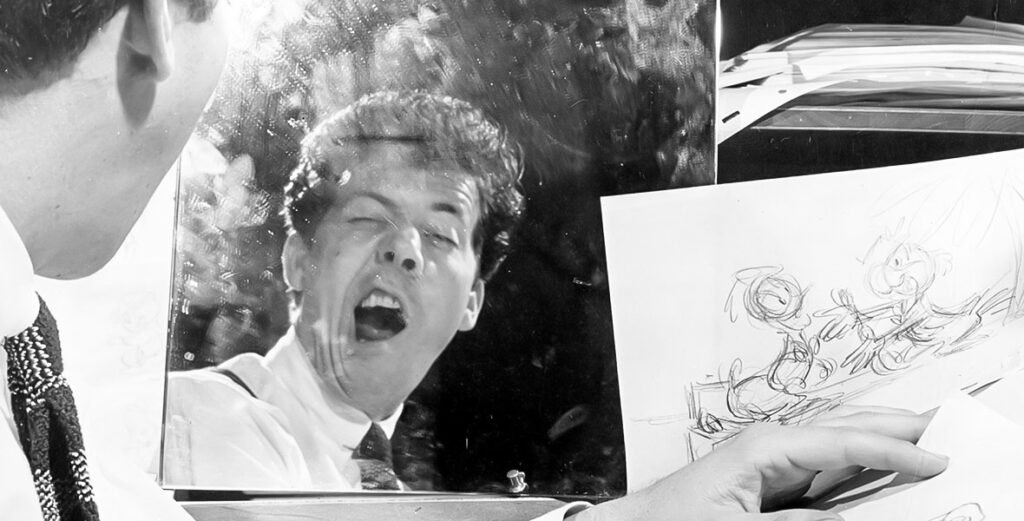
B – Even Talent and Genius – obviously – are not synonymous. And speaking of Genius, well, forget it: it is expressed by very few individuals in the world, and you could live an entire life without having the fortune of meeting even one of them, not only in our field, but in the whole world in general. I myself can say that I have met many talents, even great ones, in all disciplines, and the only one who I could say with good approximation of belonging to the category of “geniuses”, and who I had the fortune of knowing personally, was Umberto Eco (not even a very long and in-depth acquaintance, but which has profoundly marked my life in its own way, nevertheless). Another person who perhaps wasn’t a genius but certainly a brilliant artist, this time precisely in our sector, and with whom I was lucky enough to have a conversation of a certain level was the great Genoese illustrator and theater set designer Emanuele Luzzati. I then had the good fortune of meeting some other brilliant or highly prestigious people (not “absolute geniuses”, but certainly indisputably living “on another planet” compared to us mere mortals) such as Marc Davis, John Lasseter, Bruno Bozzetto, and in totally different fields I could still mention figures like Dario Fo, Franco Basaglia, Gillo Dorfles, and very, very few others. And this over the course of a life that is neither very short nor particularly sedentary.
So, don’t worry: you are not a genius, this world doesn’t really require geniuses – it can barely comprehend its existence, and in any case if you were, you would already know it (and you wouldn’t be here reading these poor little things of mine).
C – In any case, conversely, unless we are geniuses ourselves, which as we have seen is very unlikely, no matter how high our talent may be, we will always manage to find someone on our path who has more, or even much more talent compared to us. Put your heart at rest: this is inevitable.
These encounters are actually very interesting, but not always easy to manage. This mainly because we do not consider these people as aliens from “another planet”, but in some way we recognize them on the same level as us, and indeed we can have a natural conflictual reaction with them, considering the very high level of competition and challenge to the last blood that characterizes current work environments. Let us also add that usually these “talents” superior to us, precisely because they are also engaged in their hard battle for survival, are not particularly nice and well-mannered, unlike many geniuses or “quasi-geniuses”, who are usually so high level that they can almost always allow themselves to be affable, human, available in an almost touching way.
D – Symmetrically, we know that no matter how weak and uncertain our talent is, we will always meet someone who is in some way less gifted than us, this too is inevitable, and should reassure us a little bit. This is really part of life, it’s a bit like when we travel on a motorway: no matter how much we press down on the throttle, until we touch or even exceed the legal limits, we will always find someone who overtakes us because they are faster. And conversely, no matter how slowly we decide to proceed, we will always find someone to overtake, because he or she advances more slowly than us.
In reality, all this “traffic” at such different speeds does not reassure us at all, and those in particular who venture into the whirlwind of the current for the first times find themselves disoriented, intimidated, unable to control their pace, and at times could feel so overwhelmed by be tempted to abandon the trip.
If, however, we get out of the trap of “competitiveness”, which is only convenient for those who try to profit from our work, we realise how all this variety of vocations, skills and talents represents the greatest treasure at our disposal.
Contact and collaboration with people with talent and experience greater than ours is an invaluable stimulus for our growth, and all the more so the higher the difference in experience, ability, knowledge and talent that separates us from them.
BUT even meeting people with less experience and ability than us can be, and truly is, of great value, as long as we resist the sterile narcissistic temptation to console ourselves by extolling how much better we are compared to them.
You have no idea how much there is to learn, humanly, artistically and even technically, from someone who seems somehow further behind us in the queue. Moreover, helping an artist in difficulty, in addition to being good for one’s self-esteem as human beings, can be a great opportunity for ourselves to clarify processes that perhaps we now carry out a little mechanically, without thinking about it, even with a weakened enthusiasm. Personally, every time I found myself “teaching” something to someone (including these articles, even if they don’t have a real interlocutor in front of them) I found it like a gym, in which to exercise my tools, my thoughts, clarify and deepen certain issues, refresh my memory and also develop fresh new ideas.

And finally, let us always remember that animation, like cinema, is an eminently collective work: there are many people, many artists who are committed to a certain project, each with their own tasks to carry out, with their own goals and dreams, and with their own skills and ability. As in an orchestra, the individual instrument performs its part, but must at the same time be in perfect harmony with the entire collective of the team. The different skills, the different talents, all collaborate to achieve the goal, and it is perhaps precisely this collegiality, this unity of intent and results, one of the most precious assets that this profession, hard and wonderful, generous and ruthless, reserves for us.
Summarising, Concluding, So Far…
In these days I am reading a book by a not very well-known author – at least outside his homeland – Georges Duhamel (1884-1966), entitled “Scènes de la vie future”, first published in France in 1930, recently published in Italian for Edizioni Medusa (unfortunately I am not aware of any English translation).
It is the story of a journey made by the French writer around the United States at the end of the twenties (therefore precisely at the outbreak of the Great Depression which would upset the USA and Europe and lead to the Second World War), during which he writes in the form of diary a merciless and deeply disturbing account of the most sensational, contradictory and controversial aspects (sometimes welcomed in Europe with uncritical enthusiasm) of the overwhelming technological, economic and industrial development taking place in that country. As we know now, this model of development, precisely after the “regenerative” catastrophe of the WW2, would then impose itself on a intercontinental and Western level as the primary parameter of the world balances that have accompanied us up to the current historical moment, in which for the first time these balances they are beginning to reveal themselves to be seriously compromised and threatened.
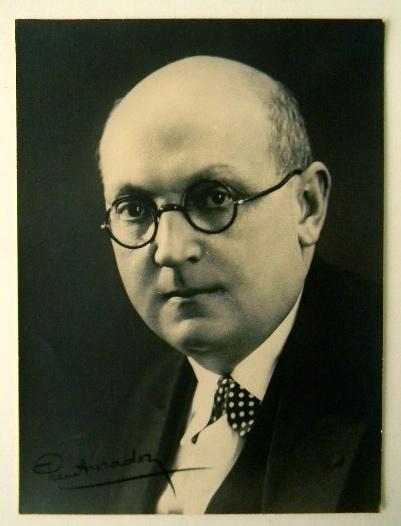
Duchamel’s vision is extremely, indeed furiously, critical of this model, as it was just taking shape in his time, from a point of view that until a few years ago I would have defined reactionary without hesitation, but which today reveals itself in many respects almost “prophetic”.
The project of “pure” American capitalism, based on profit, unlimited growth and the exploitation – even predatory – of human, economic and environmental resources, is highlighted by this author with extraordinary clarity and, as I was saying, beyond the tones of a millennialist invective, if we try to ignore the original disgusting reactionary virulence, it reaches us with a message that (unfortunately) sounds prophetic for the current events we are experiencing day by day: from climate change, to the return of conflicts in and around the Europe, to the re-emergence of more or less fanatical far right-wing parties and organisations on a global political level.
The pages dedicated to the large industrial intensive slaughterhouses, in their unsustainable crudeness and treated in a symbolic way of an economic and global power “system”, would be enough to understand how much this author has been able to see forward regarding the havoc that the so-called civilisation of mass prosperity was already doing to the detriment of the planet’s resources, something for which we are only now beginning to perceive – and pay – the consequences.
In his visionary pamphlet Duchamel – and this is the reason why I quote him so extensively here – also does not neglect to put under fire what was already proving to be one of the most flourishing and iconic American industries which, although it was technically “born” in Europe, right here would have laid its deepest and most vigorous roots: the film industry. The movie system. Hollywood.
The author refuses to recognize any artistic status for the still pubescent American film industry – just as it was establishing itself, after the first steps as fairground attractions and the clumsy attempts to mimic theatrical art, imposing an original identity and an increasingly autonomous language – and he vigorously denounces what he sees as very serious risks not only for the freedom of artistic expression, but also for the very intellectual and mental integrity of the audience, unaware and defenseless, exposed to such shows.
The imposition of prefabricated and mass-distributed images, somehow like Ford Model T cars, of elementary and standardised narratives – with the manifest sole aim of generating profit – on mass audiences “hypnotised” by the star system, deprived of any critical spirit by the nature itself of the projection of an artificial “dream” on a silver screen, constitutes in the eyes of the French author a true mass corruption of spirits and souls, definitively and indisputably opposed to the vocation and mission of spiritual and moral elevation of the “noble arts”. An authentic anti-humanistic revolution.
Certainly these are extreme positions, which may sound, as I said, darkly reactionary, but we cannot fail to glimpse in this analysis all the limits, risks and distortions inherent in this which today we definitively recognize as an “art form”, which however remains imbued with technology and industrial production logic, with balances between costs and profits, between the paranoid search for “novelty”, for the “never seen before”, and at the same time the total conformist subjection to the taste of the mass public.
Then came Einsenstein, John Ford, Dreyer, Kurosawa, DeSica, even Disney, just to mention the first who come to mind, to demonstrate how “art” could fully find its place even in what could appear comparable to an industrial production like any other. Indeed, it could involve, excite, entertain and form audiences that were potentially much larger – and in a certain sense “democratic” – than those hitherto interested in the so-called “major arts” shown in their temples of choice, as theatres, concert halls, museums, libraries.
In truth, the film industry has had not so great affinity with other industrial sectors since its origins, as it was, whether we want to recognise it or not, a “cultural industry“, in which it was never possible to shape and above all fully predict the tastes of the final buyers, the audiences: even today these tastes remain largely unpredictable, and film production remains largely a “gambling” in which the risk component of the investment remains extremely high compared to other sectors.
Moreover, even the “noble arts” that are so dear to the french writer have never been able to be truly independent from great structures of production and power, from investments that are sometimes even colossal in resources and production technologies: let’s think of certain huge, sumptuous cathedrals, artistic masterpieces themselves, in turn the setting for sculptures and paintings of the highest historical, cultural and, obviously, artistic value: cinema is not very different from all this.
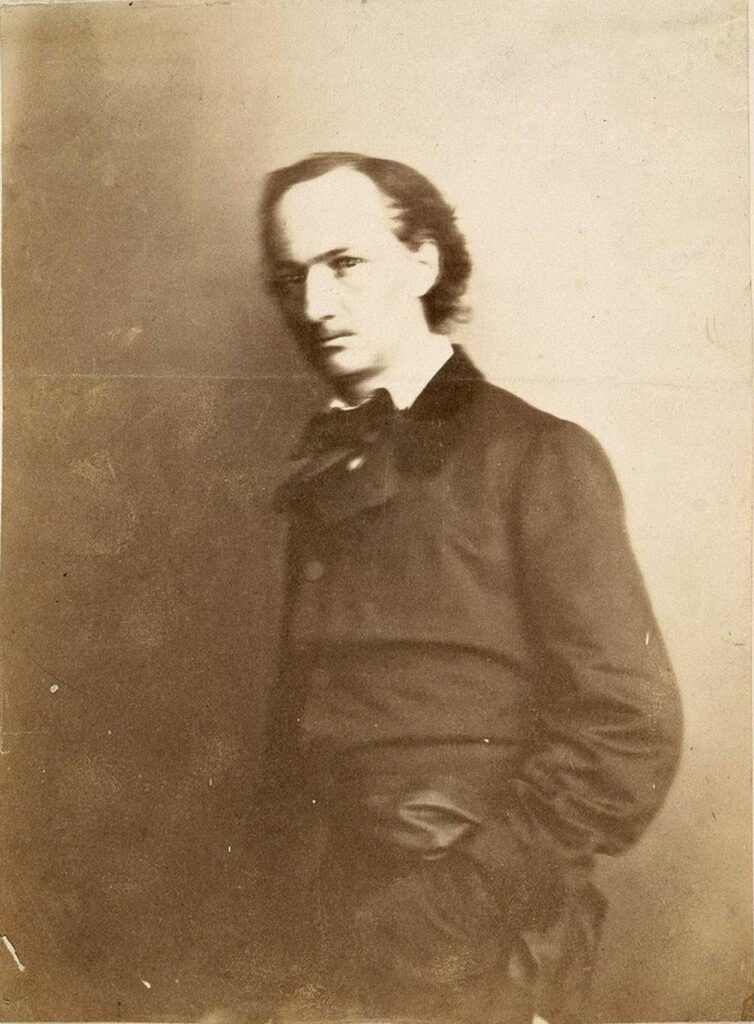
With not very different tones, much earlier, another Frenchman, much more well-known and celebrated than Duhamel, the “poète maudit” Charles Baudelaire (1821-1867) had railed against the nascent art of photography, which in his opinion would have provoked tout court the death of the noble pictorial art… except appearing himself in some of the most moving portraits by one of the first recognised “masters” of the art of photography, Felix Nadar (1820-1910).
And in the end, obviously, the art of painting did not become extinct at all, but found other ways of expression in which photography could not follow it, thus opening, for both, to an entirely new conception of the “function” of visual arts, between aesthetics and documentation, reproduction and creation.
All things that sound very familiar to us, given that animation and cinema are in a certain sense the natural “daughters” of photography, or rather the technical reproduction (to get back to Benjamin) of reality. Moreover, the corruption and disappearance of the aura, again in the Benjaminian sense, remains the most valid and consistent critical observation of both Duhamel and Baudelaire, and it is no coincidence, as we have seen, that this is something with which we are still dealing today, as the aforementioned generative AIs have suddenly and noisly landed on the great stage of ideas.
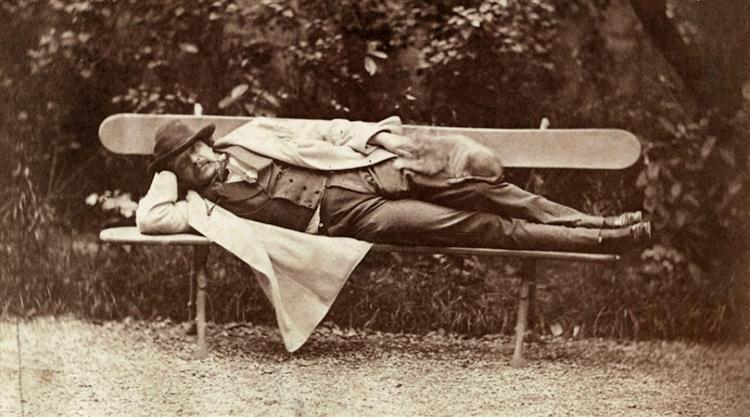
I write all this, at the conclusion of the first part of these notes and considerations of mine on the art and craft of animation, not only because I believe that animation itself is so rooted in the body of the film industry as to embody, by its very nature, its primary and most marked artistic vocation, but also because I have the feeling that never before in recent years have these themes become so relevant again: themes and issues that seemed outdated, but that now the invasive and pervasive diffusion of certain technologies in the delicate creative organism of high-profile human activities, has sensationally re-proposed their validity.
These technologies, to an incomparably greater extent than in the past, have unleashed a real storm of ethical, legal, legislative, moral and, last but not least, aesthetic and creative implications, and have opened up a completely new and in many ways worrying scenario. Precisely this, in the first instance, pushed me to write these pages, hoping that my contribution, despite its modest dimensions, can help other people, artists, colleagues, especially young people, by making available my experience gained over several decades of activities in the sector.
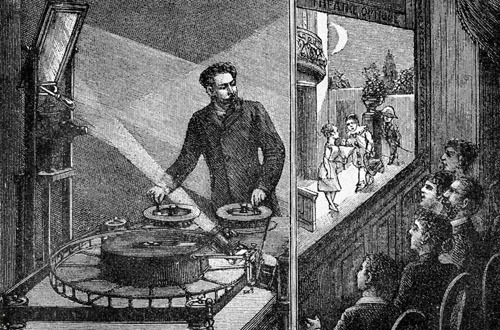
Due to my education and mentality, I have always been very sensitive and readily available towards every technical and technological evolution that over the years has directly or indirectly involved my activity, well aware of how animation has always been closely linked to technical devices, since its origins, since the very first manual contraptions of Charles-Émile Reynaud (1844-1918) like his famous Théâtre Optique. Moreover, if we think about it carefully, in the face of unrepentant idealists (including the aforementioned Duhamel), there is no art that is completely unrelated to any technical component, which almost always precedes and determines the aesthetics, the language and the contents. Any art, in general, consists of nothing other than the production of “artefacts” through the use of manual skills and more or less sophisticated technical tools. Even music, which is considered the most “abstract” of all the arts, can only reach its public through the use of appropriate technical tools, i.e. musical instruments, from the prehistoric drum to Pro Tools.
For this reason I have always been very ready to adopt for my profession every interesting innovation that the market offered over the years, every tool that promised to make my work easier and quicker, allowing me to obtain better and higher results, moving from film to digital, from traditional 2D to 3D animation, from pencil to Cintiq. But this is precisely the point: with Generative AI, in the artistic field, we find ourselves faced with something totally new, for which the categories of analysis and evaluation that were valid until recently no longer have any relevance: actually, we are not able anymore to understand and dominate the phenomenon.
In reality there is nothing truly new or strange in this, technologies have never guaranteed in themselves to be resources for the progress of humanity. Let’s just think about nuclear technology, and its devastating impact on history, as it continues to present itself today: from the “dream” of inexhaustible and clean energy, to the nightmare of the atomic bomb. A technology, just because it has been invented, does not mean that it must represent a “step forward” in the direction of progress.
But History also teaches us, around this same topic, that a technology, once conceived and started, cannot in any way be stopped, and it is very probable that it will proceed at its own pace on its path, indifferent to any opposition, protest , threat, treaty and convention.
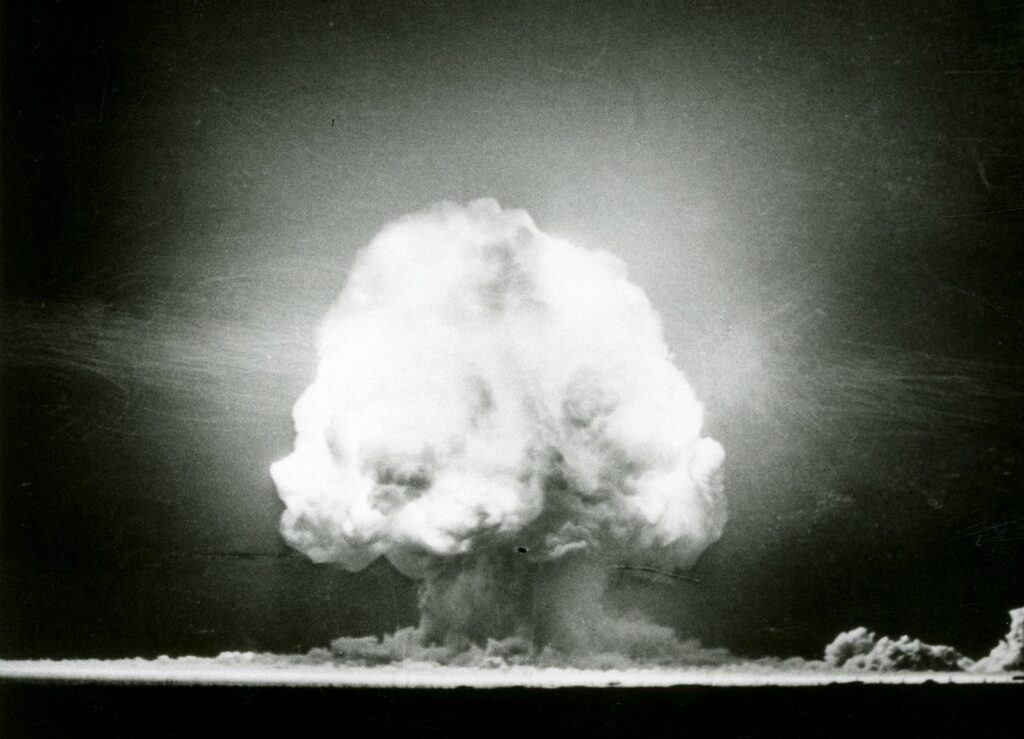
Likewise, AI is now launched, it is here, among us, and will continue to follow its “natural” course almost ineluctably. If it ever suffers a slowdown, it will be due to its own structural reasons, due to excessive growth, due to the inadequacy of those who lead it, or due to too much voracity. Or for external reasons linked to changed global economic conditions, military conflicts, excessive demand for resources, excessive impact on the climate, etc. We, individually or collectively, can do little, except a form of “humanistic resistance”, as Duhamel called it, that is, simply refusing to use this tool in any way and denouncing the “theft” of our data and contents to fuel the “beast”.
But how exactly is Generative AI so DIFFERENT from every innovative technology seen so far?
For the first time, a combined software and hardware technology aims not simply to support a human activity by making it more agile, faster, efficient and economical, but potentially to replace the human component of that activity itself. And where the human component is more present, so much so as to be dominant as in the arts, the higher and deeper is the threat and potential damage.
For example, in past times a writing program, such as Word – which I am using right now here – aimed to provide the writer with a tool that would allow him to express his thoughts in written form in a faster, more agile way, technically correct, providing him with a whole suite of tools aimed at making his life easier, to concentrate as much as possible on the mental act of writing, relieving him of all those technical tasks that once slowed him down or distracted him: from the spell checker to the thesaurus dictionary, to the possibility of deleting, moving, modifying, copying, pasting words and texts, to the cleanliness and intrinsic order of digital files compared to the disorder and difficult management of old paper notebooks.
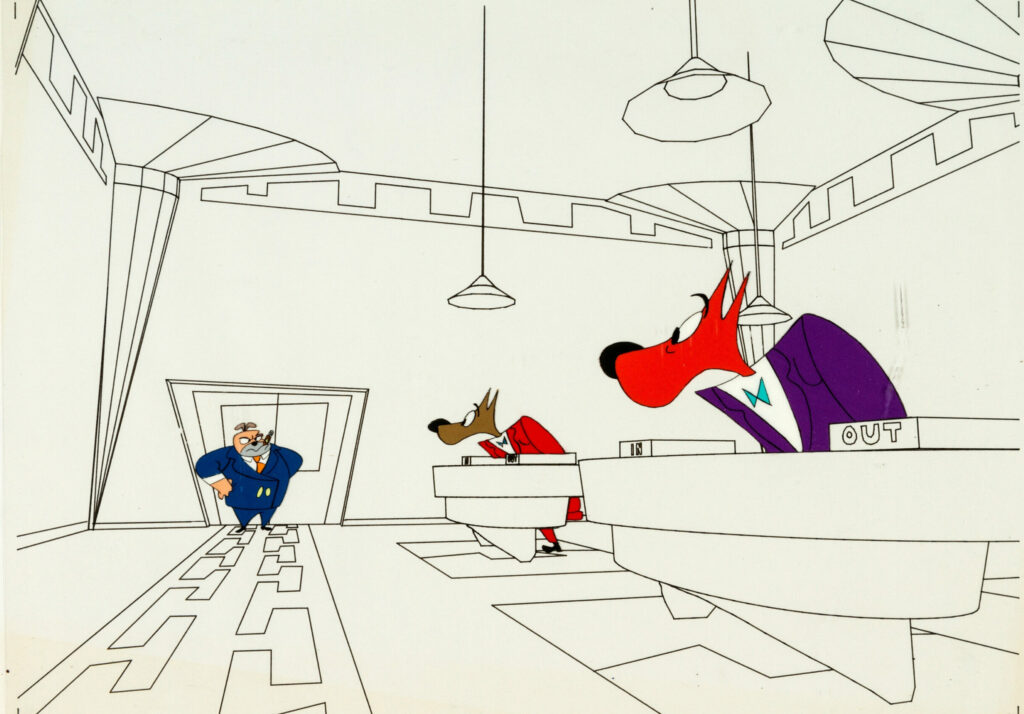
An application like Chat GTP, on the other hand, explicitly aims to replace not so much the “author” as such, who could be somehow assimilated to the user of the program, but his thought, and his ability to process it, tracing it instead through algorithms over an immense volume of words, concepts and contents expressed by other individuals, totally anonymous, and chaotically accumulated in these immense bottomless “cesspools” that are global databases.
In other words, Generative AI aims to artificialize and therefore replace not so much the artist (in this case the writer) as a living and thinking being, but his very thought, his imagination, his dreams. It is no coincidence that the first serious agitations on these issues were promoted by Hollywood screenwriters’ unions.
From all this it is easy to understand what the looming threat is, in particular for those who, like us, professionally embody the human creator of this creative cycle, and from whom they aim to take away the control and ownership of our own thoughts.
It is not just, as many seem to limit themselves to fearing, the removal without compensation of our personal data, thoughts, images, to feed with them the endless pool from which the system draws. In short, it is not simply a question of Copyright. Because if this were the case it would be easily (at least in theory) solvable, just forcing the AI organisations to pay a decent fee for any content stored and used.
Unfortunately, even if each of us received financial compensation for our contents when they were transferred into the database, that is, if what is now a theft were “magically” transformed into an economic exchange, in reality we would not have solved anything. It is not comparable to the sale of one of our illustrations for publication on some edition or platform. The real “damage” occurs AFTER this hypothetical transaction (which for now is still solidly pure and simple theft), and is much more profound and epochal than the simple loss of jobs of a few thousand professional artists.
It is precisely about that “intellectual decadence” that Duhamel denounced, even though he certainly could not even remotely imagine that it would be talked about again and even with more urgency, almost a hundred years later: on the one hand, the progressive detachment of these “works” from any human conscience; and on the other, the impossibility for the very definition of “artificial” to simulate “talent”, whatever it may be, in the generation of the product, whatever it is. Which from an “intellectual property” would have changed – in perfect line with capitalist ideology – into a “product”.
On the one hand we are witnessing a gradual but inexorable detachment of the artworks from their essential human component. On the other hand, the very definition of “artificial” denies these instruments any possibility of replicating or even simulating “talent” (not to mention “genius”), which as we have seen are properties that can be recognised exclusively by human beings (spectators, audiences, readers, viewers) towards other human beings (the artists).
However, this is not the greatest risk and damage, in my opinion: much more profound is that potentially caused to what I could call the “transmission belt” of knowledge, culture, learning, testimony and memory.
The new generations of artists, exposed from birth to these tools and to the prodigious simplification that they seem to promise, would no longer feel stimulated to produce new ideas, new visions of the world, new schemes, but to settle on the materials proposed by the proprietary algorithms, in limits and under the conditions dictated by their owners. Consequently, on the part of the public, there would be a gradual progressive and inexorable impoverishment of the artistic product, at the expense of the characteristics of uniqueness, originality, novelty and unrepeatability of the stories, images, sounds, creative works, thus amputated of human talent and genius.
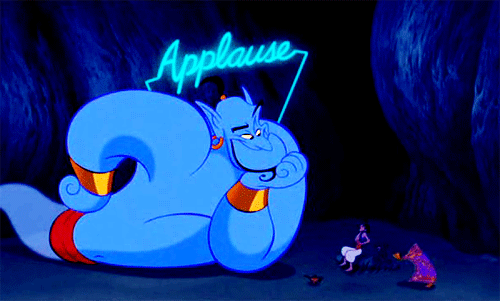
Some object to this alarm, which they consider excessive, “Luddite”, hostile to progress due to bias or ideology, recalling how our sector has already undergone periodic and profound “crises” many times, almost always linked to technological evolution, but also to major oscillations of a market that is by definition unstable and capricious such as that of taste and cultural fashions; and which has always recovered, renewed and relaunched itself towards new development prospects that were hitherto unpredictable.
And this is true, even if this opinion tends to overlook the fact that behind these recurring “crises” there has always been a heavy sacrifice of people, talents, human beings who suddenly have lost in temporarily or permanently their sources of livelihood. Therefore it is a vision already in itself flawed by a sort of social Darwinism of a vaguely reactionary nature (the strongest wins, whoever knows how to adapt wins, whoever knows how to beat the competition wins, the losers lose, etc.), which we could easily define as ethically cynical and morally intolerable.
But the crucial point is not even this, because what is lost sight of in this kind of comparison is the absolutely unprecedented and devastating nature of the current “crisis” compared to all previous ones.
Now it is not simply a question of a change in technological paradigm and language: the advent of sound erased cinema as it had been experienced, produced, distributed and received up to that point almost overnight, profoundly revolutionizing the industry and costing the careers of many artists, actors, stars, and specialized workers hired in the studios. It was certainly a social massacre, but it was also a trauma that led to the birth of a completely new language, far from the old silent “pantomime”, bringing the public closer to greater identification in the story, and promoting the roles of a whole new generation of skills, intelligence and talents.
None of this is evident in the current situation, the language does not change, the “hardware” production process remains substantially unchanged, there are no new creative categories in sight, on the contrary, the whole process is in fact a process of pure subtraction, without any compensation. And this subtraction is carried out entirely at the expense of the main human component, therefore aiming at the very living and beating heart of the cultural industry, that is, the creativity and talent of the individual artists.
We add that every artistic expression is essentially an act of communication of an individual/human being towards another individual/human being (or group/community of individuals in the case of a collective art form, such as cinema, but also architecture, for example). Eliminating the human component from one of the two ends of the thread makes communication meaningless. In fact there is no longer any “communication” at all, the thread breaks.
These are all open questions, which demonstrate the great complexity of the issues at play. But what matters here and now is to recognize that we are now INSIDE this change, this revolution, or this battle, call it whatever you want, and that the process has begun, and nothing, unless unforeseeable conditions or events intervene, can not only stop it, but not even slow down a bit in its course.
We would like to point out that this technology, in other fields, promises to truly be an instrument of progress (particularly in the scientific field: in the previous chapters I have presented some notable examples), but in the artistic and cultural industry we cannot fail to note risks and critical issues that, if left unmanaged, far outweigh the possible, currently far from granted, advantages.
How should we, as operators in this industry, position ourselves towards this ongoing “last revolution”?
Trying not to give in to harmful emotionality, and to remain anchored to rationality and an objective analysis of the facts, I would say that we are faced with three possible attitudes, or action schemes:
A) À la guerre comme à la guerre (At War as at War)
We could simply oppose the entire process decisively and with all our might, refusing any contact with it, denying its legitimacy, contesting its methods and principles, and attempting to force politics to promote restrictive laws, or better, highly restrictive ones, on the use of these tools in the artistic and Copyright fields.
Following Umberto Eco’s lesson, I could define this position as “apocalyptic”, even if it is perfectly legitimate, it is not rearguard or reactionary. Indeed in some respects I would even consider it dutiful, especially at a time when we have to equip ourselves to defend the artistic property of our achievements from the robbery carried out at our expense by data collection agencies and from the unauthorised use that is made of them.
However, it is a battle perhaps lost from the start, and in any case purely defensive, which limits itself to responding to fire as best it can, therefore with means that are difficult to compare with those available to the “enemy”, but which is not capable of affecting the root of the problem. AI applications will continue to evolve and expand their hold on the market, at least in the short/medium term (because in the long term we do not yet have enough data to predict if and how some stable and non-destructive balance will be ever established), and in the meantime thousands of more or less senior jobs in the creative sector will be pulverized, and we, proud of our coherence and incorruptibility, clinging to our “ivory towers” , we will only have to watch the ruin and devastation that would result. The process will continue its course, and we will simply be excluded from it (and no one, except our own conscience and pride, will care to know that we will have voluntarily “self-excluded”).
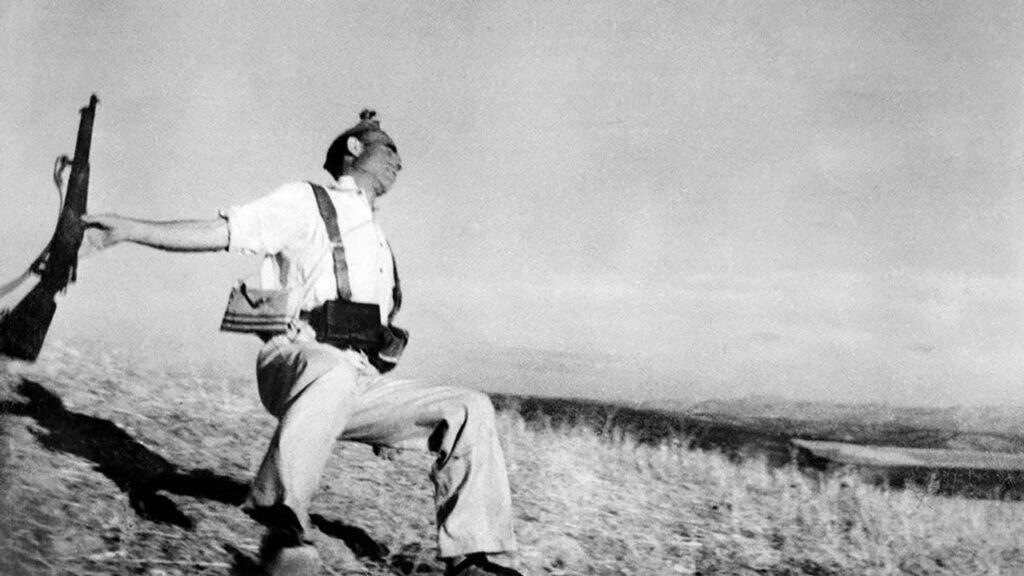
B) Joyful Integration
On the other hand, we could “integrate” joyfully, welcoming innovation in the name of progress, and throw ourselves more or less uncritically into the gears of the process in order to obtain the greatest possible advantage in terms of personal growth, competitiveness and profit.
This is also a completely legitimate position, and is in line with what we have done in all the crucial steps that new technologies have gradually proposed – or imposed – on us.
Unfortunately, however, as we have seen, in this case it is not a simple, albeit radical, technological evolution, which we can and must align ourselves with in order not to remain isolated and excluded from the market because our products would end up being obsolete and surpassed by those produced from our competitors.
Here now the statute of the process is openly, as we have seen, that of replacing our competence and creativity (I’m simplifying) with sophisticated algorithms. For this reason our collaboration, even if apparently in the immediate future it could appear as a gain, a win-win deal, even an individual growth, in a longer period – and no longer just at an individual but collective level – would end up inevitably turning against ourselves, metaphorically making us do the end of Charlot sucked and crushed between the gears of the Big Machine.
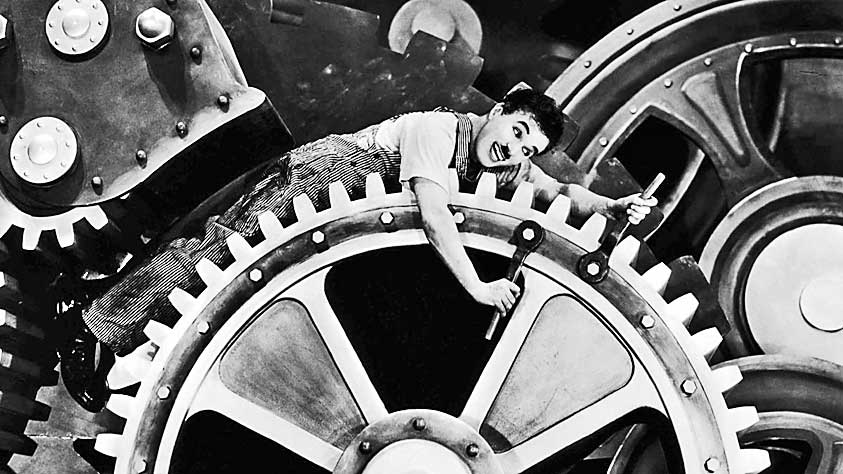
C) Active Resistance
But there is also, as always, a “third way”, which however is NOT the usual “middle way”, which in reality solves nothing except making us feel wiser or smarter. I would rather say a sort of fully alternate path, inventive, creative, but, above all, active.
Let us not abandon the battlefield to take refuge behind the walls of an increasingly fragile and unsafe castle. And much less do we surrender to the “enemy” by trying to quickly enlist in their ranks so as not to lose acquired or hoped-for advantages, contenting ourselves with picking up the crumbs that fall from their bandwagons.
What we must do instead is to work with even greater commitment to accentuate as much as possible the difference in quality, originality, variety, novelty, genius and humanity between what we know how to produce compared to what – artificially – the “machine” can do. Always reminding us – above all – that the public is not (yet) made up of machines, but of human beings like us.
In short, we can say, a real guerilla, a partisan war of Active Resistance.
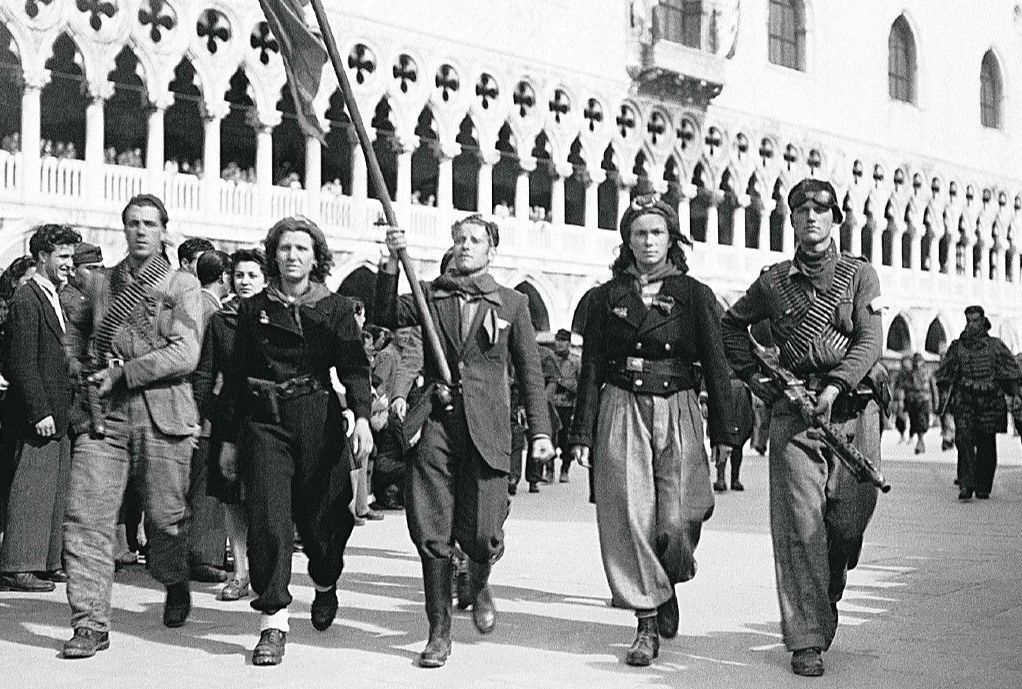
From a tactical point of view, it is useless to seek a clash on the ground and with the rules established by the adversary, we would never be able to prevail: the “machines” have on their side a computing power, a speed and production cost-effectiveness that no human, alone or in a team, is capable of equalizing, not to mention beating.
Instead, it is necessary to establish an exclusive “our” field, defined and impregnable, into which simply no AI system, however sophisticated and advanced, will ever be able to penetrate.
As we have seen, it is not pure and simple “skills” that can compete with those of the algorithms, but the unique and inimitable characteristic inherent in every human being, whether a more or less gifted artist, or what we have defined as “talent “. No machine, no algorithm, no processing system will ever be able to simulate talent, by definition, because it is an eminently and exclusively human quality that only other human beings are able to recognize. “Talent” (and its maximum expression, “genius”) is recognised only and exclusively because the observer “knows” that behind the product, the artefact, the work of art, there is a human being. Paradoxically, a human audience could accord wonder and amazement for the admirable precision of the IMITATION to the SAME identical work generated by an algorithm, but could never recognize talent and genius in it. Simply because he wouldn’t know who to attribute it to.
For this reason, all we can – and must – do now is to exercise our creative abilities in the field in which we engage day by day, and in order to do this we must recognise the origins and manifestations of our primary vocation, learn to recognise its foundations, and the principles that guide our choices and actions, and which we can apply on the technical tools we possess.
It is precisely to try to respond to this need for knowledge and method that the idea of starting to write this series of articles was born. Also, and in particular, because the art of animation (character animation), which is the subject of this discussion, it is considered more of an performative art than a creative one, and therefore by its nature more exposed to the aggression of artificial intelligence generative technologies. The problem arises less for writing, for example, where the purely creative component is much more dominant, if not exclusive. Or in musical composition, for which the same applies. Instead, apparently, an instrumentalist, a violinist in a symphony orchestra, is much more defined by his performative and interpretative excellence than by his more purely creative vocation.
In the same way, an animator must understand what his real role means, and what the role of his talent is in all this, to demonstrate with facts his irreplaceability ALSO on a creative level.
It is precisely to try together with you to identify, define and establish the creative foundations of this work that these conversations were born.
Initially the idea was to organize a series of thematic “courses”, but in reality this could not fully correspond to my intentions.
There are dozens of courses of this type around, some excellent, paid or free, and many excellent “in person” schools where students can learn the basic and advanced techniques inherent to animation to perfection.
However, what I felt was missing the most was more a treatment of the subject from a more wide-ranging point of view, from a less technical and more theoretical perspective, something that was closer, for example, to a treatise on musical theory, rather than a practical course on how to play a particular instrument.
Even in music, an AI algorithm would today be perfectly capable of “interpreting” a Bach’s piano piece “as if” it were Glenn Gould himself playing it. And there are very few who would be able to distinguish the two tracks simply by listening. We take this for granted, no one doubts the now prodigious processing capabilities of these systems. But we are instead interested in understanding why Gould is Gould. And because he is and remains inimitable and irreplaceable. And why and how, today, another great pianist like Láng Lǎng, on the same pieces, is Láng Lǎng. Why and how he is completely different from Gould, yet capable of releasing an equally high and undoubted “aura” from his interpretations of Bach.
This is why I thought of diving in depth into the generative secrets of our art, starting from understanding why we are who we are, as artists, what is the drive, the motivation that brought us, and that every day brings us, to our desk, to our Cintiqs, to our computers.
And what are the sources and goals of our inspiration and our vocation, two other dimensions of an exclusively human nature beyond the reach of any artificial system: a “machine” (i.e. an algorithm) will never know an “inspiration”, but only a massive input of data to be processed, nor even a “vocation”, but just a series of strings of instructions, of algorithms, activated for the purpose of processing that same data and returning it with a complete meaning.
Powerful hardwares, super-fast processors, huge memory packages, highly sophisticated algorithms, data centers hungry for data as well as energy: the public is and will always be aware of all this, and for this reason it can never be completely deceived if not by his own – always aware – choice. It is all our now the task to draw the boundary of this choice, and to ensure that this public is put in a position to know how to discriminate without hesitation – in the mass of materials that reach it in a magmatic and uncontrollable way – so to speak, “the wheat from the chaff”.
I am sure that the public is perfectly capable of distinguishing the human, original, exciting quality of a product in whose creation human intervention prevails, over that of its artificial imitation. As I was saying, the audience is human, it is not artificial. The aura, the soul, is recognizable as original and unique only in the human product, and it is only it that can create the irreplaceable relationship of identification with the audience.
First vinyl records, then CDs, have never been able to replace live concerts, but only make music listening more widespread – thus also increasing the demand for concerts. Ultimately, it’s the same as what happens with our work. But the public will be always and increasingly attracted, in my opinion, by the warmth of the human communication, just as people still flock to theatres (and arenas) to listen to a Láng Lǎng or Bob Dylan concert live.
We must ensure that these theatres, these arenas survive, because this is, remains and will always remain the public’s demand,: I am firmly convinced of this, AI or not, and I feel I can be basically optimistic about this.
But it will ultimately depend, however, only on us, from now on.
In the next chapters I intend to continue along this same path.
I will try to examine the foundations of animation, as we know them from the extensive technical and historical literature on the subject, and to address its content, not so much from a strictly technical point of view, but from a historical and methodological one, and above all by trying to draw a coherent and stimulating theoretical line, also on the basis of theories of perception, which is what first pushed me to start this wonderful profession.
